View of Tel Aviv beach looking out our hotel window. WOW! |
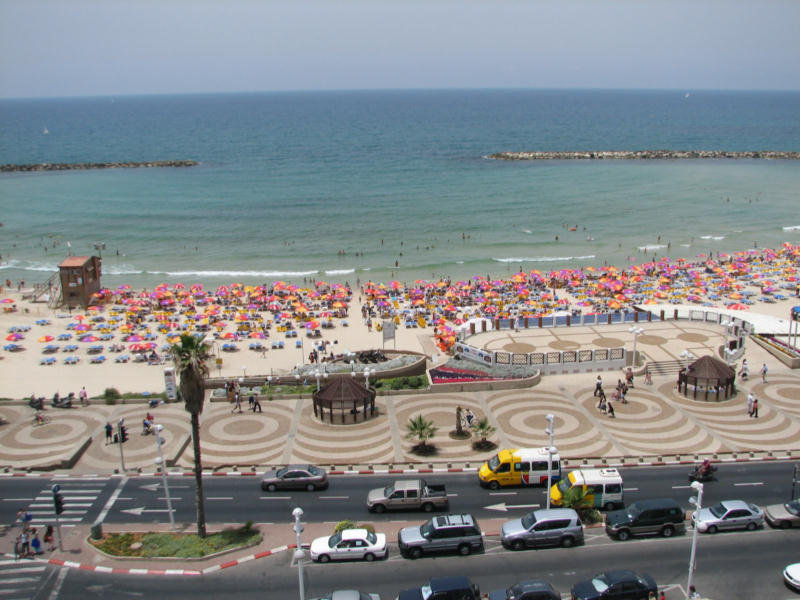 |
Might as well head for the beach upon arrival. Unpacking be damned. Hold Everything ... Photo Op! |
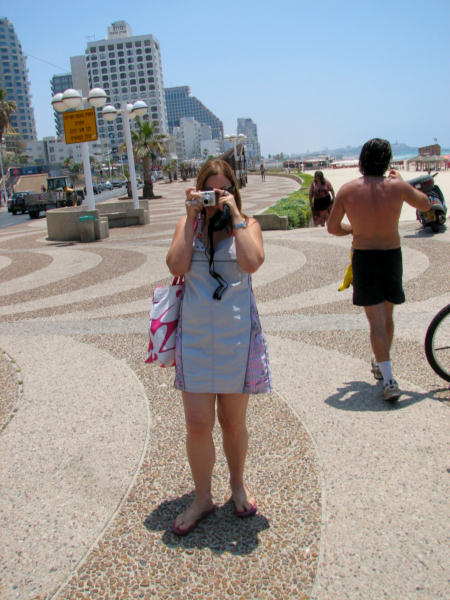 |
The subject of the Photo-Op. |
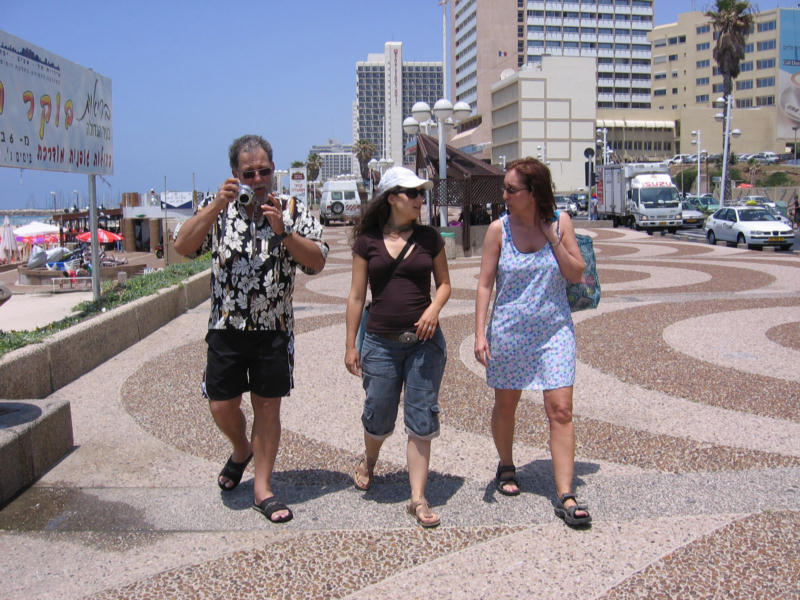 |
Joan & Natalie head for the beach. |
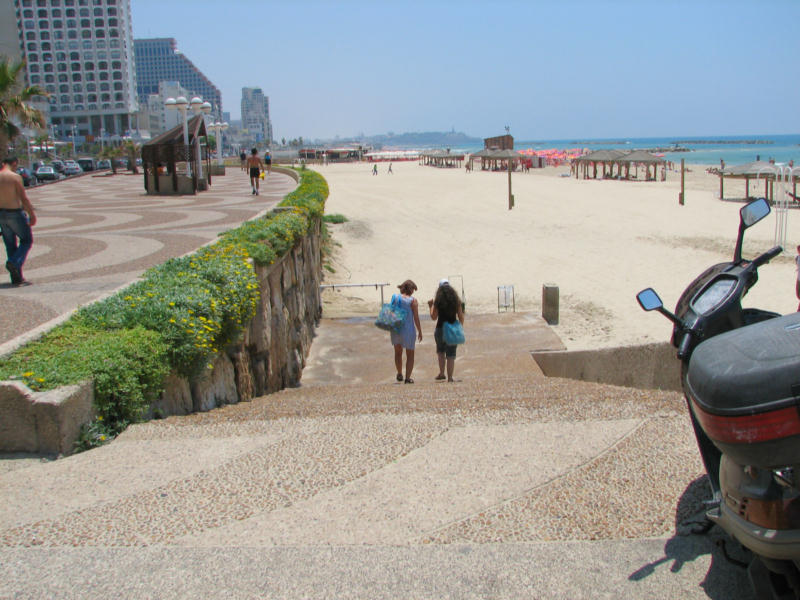 |
Picking a site and setting up camp. [Our hotel is the set of windows between the tall Dan Hotel on the right and the rainbow colored building.] |
 |
Whew, the hard part is done. It's 11 o'clock we're actually here and on a beach! |
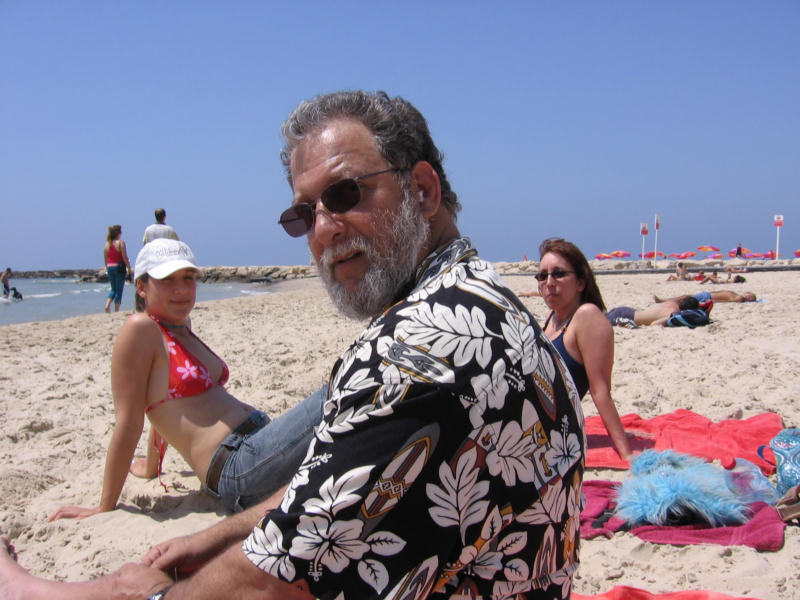 |
Back up to the room. The hotel had TWO elevators. This was the LARGE one... kidding. |
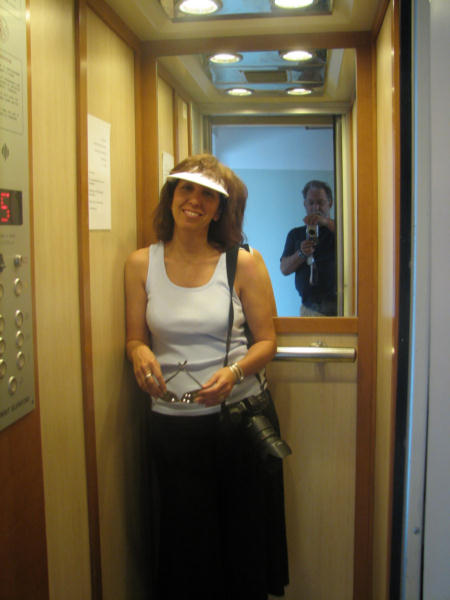 |
Back in our room, we hear a commotion on the beach. |
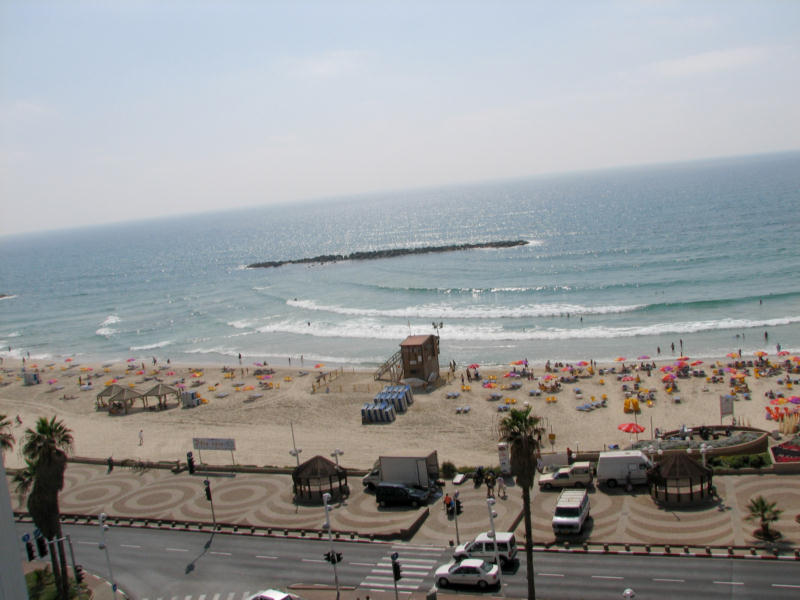 |
Looking out our window... |
 |
... we see people gathering... |
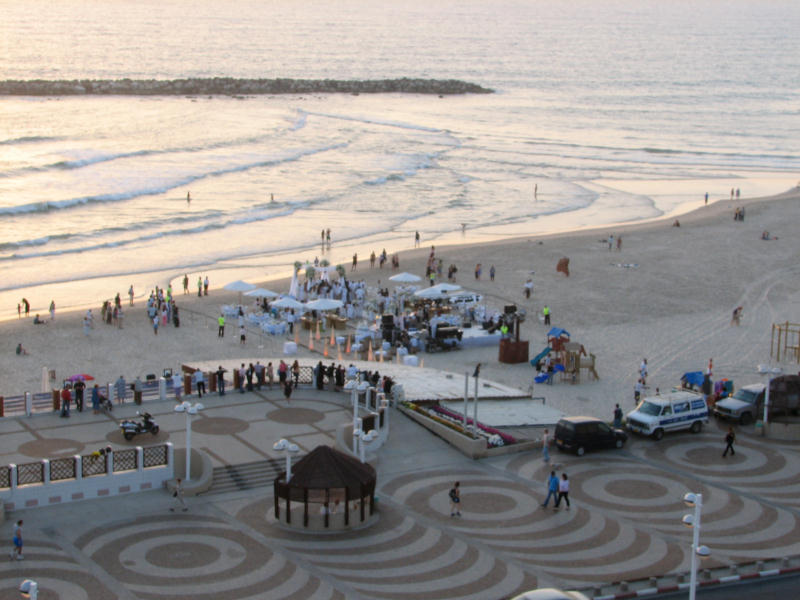 |
for what appears to be a wedding. |
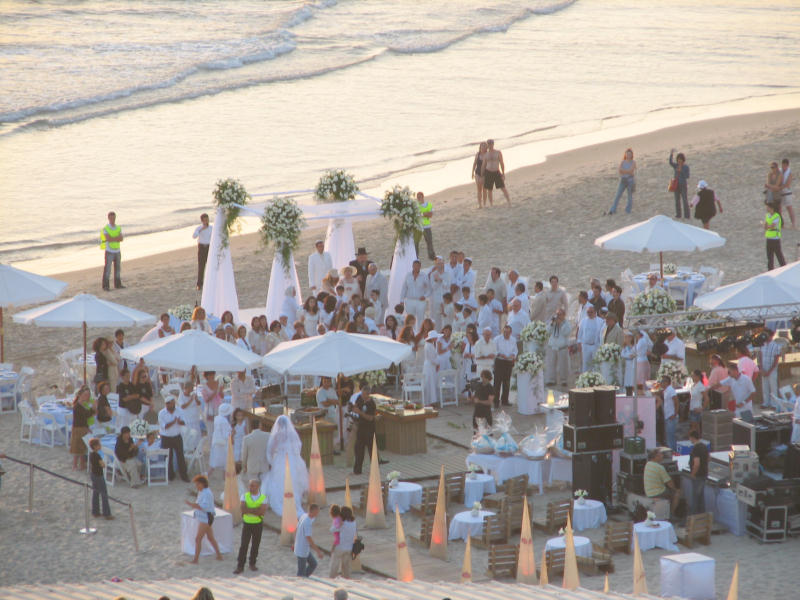 |
Note the guys in the green vests. Security! Everywhere. |
Yep. A beach wedding in Tel Aviv. |
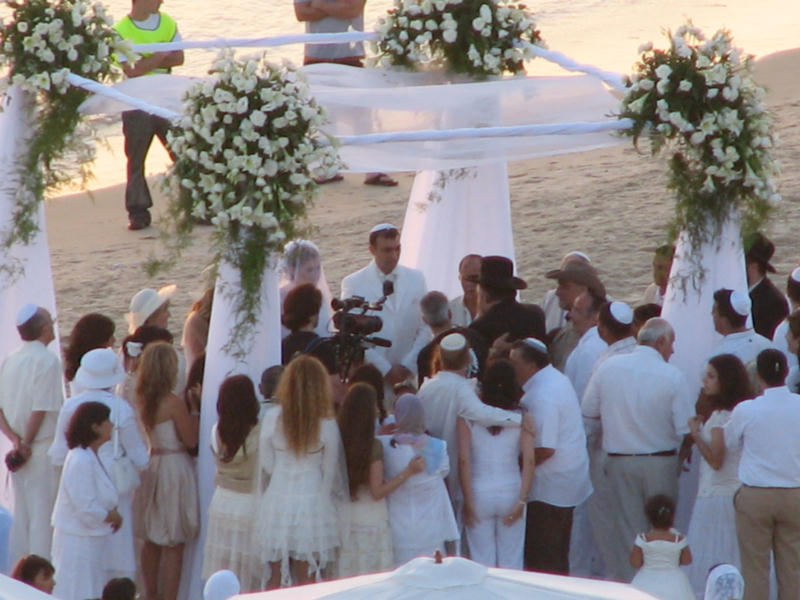 |
As the sun sets behind them. Nice! No? |
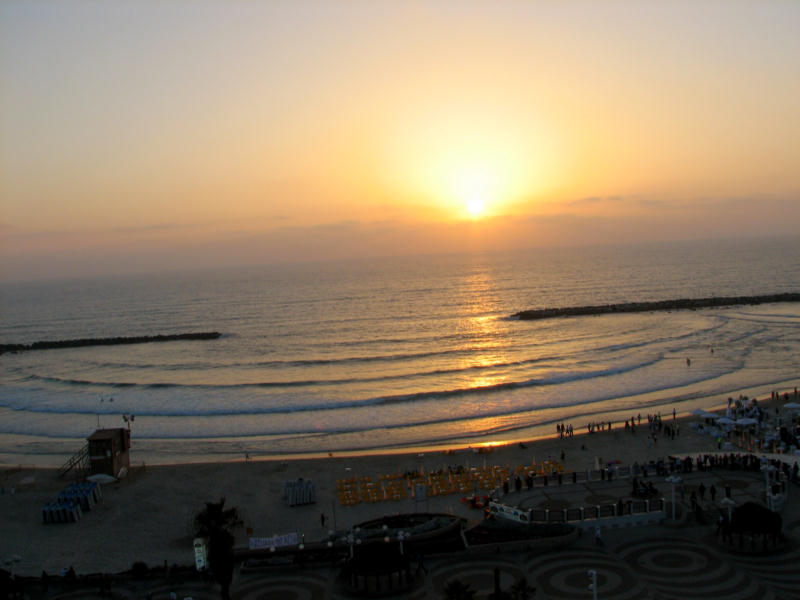 |
Top Of Page |
Now HERE's a city! Holy to three religions and born from a confederation by Saul between the Philistines and the Hebrews (1010-BCE); built by son David and grandson Solomon and then conquered by the Assyrians, Babylonians (587-BCE), Persians (538-BCE), Alexander the Great, the Macedonians, the Syria-based Seleucids, the Jewish Hasmonean family (164-BCE), Romans (63-BCE), Persians (614), the Byzantine Empire (628), Turks (1071), Crusaders (1099), Saladin (1187 - Horns of Hittim), Muslim mercenaries (1244), Marmelukes (1260), Ottoman Turks (1516), the British (1917), the United Nations (1948) and if that weren't enough, finally the Six Day War (1967). The Old City is divided into four Quarters: The Muslim Quarters (the largest and most densely populated), The Jewish Quarters (today, the most restored), The Christian Quarters (in the shadow of the great Basilica of the Holy Sepulchre), and The Armenian Quarters (the smallest and quietest part of the Old City). |
The next morning (our first in-country), we head for Jerusalem. Now THIS was what eventually became the first AH-HA moment for Joan. After paying the cab driver, I looked over to see Joan frozen in space and time. I called out, no answer. I couldn't get her attention. I walked up to her and she looks dumbfounded. "I just can't believe we're here in (expletive) Jerusalem". Ah, well, AH-HA. |
 |
[Jaffa Gate: Built in 1538 for traffic and pedestrians coming from modern West Jerusalem. The breach in the wall at left was added in 1898 so Kaiser Wilhelm II of Germany could enter the city in a carriage. It's now used for the taxis.] |
Once Joan's mind came back, her feet started moving too. We walked past the Jaffa Gate plaza, turned right and headed for the Armenian Quarters. |
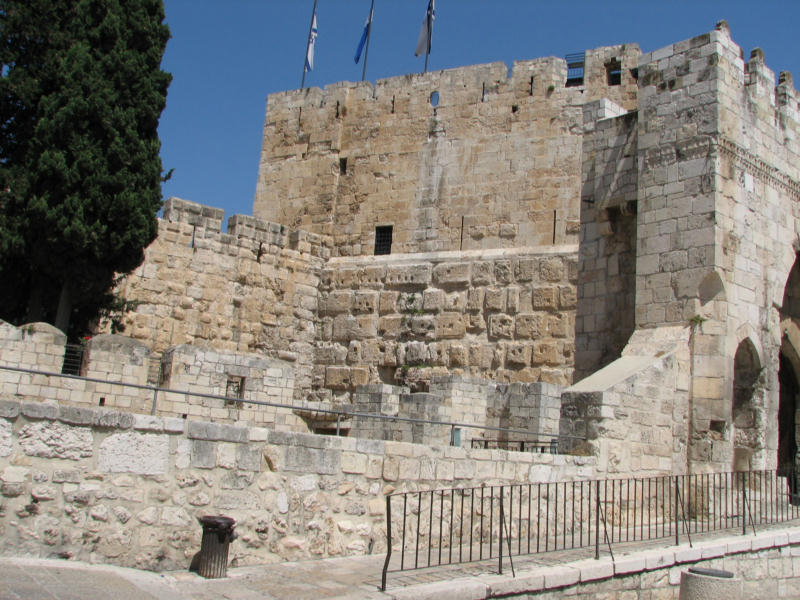 |
[Looking back at the inside ramparts of Jaffa Gate.] |
The Armenian Quarters. She caught-on fast. Everybody walks down the middle of the narrow streets. An Old City map would have been helpful, since it had been 18-years since Rick had been there. We got lost, missed everything to see in the Armenian Quarters and headed for the Jewish Quarters. |
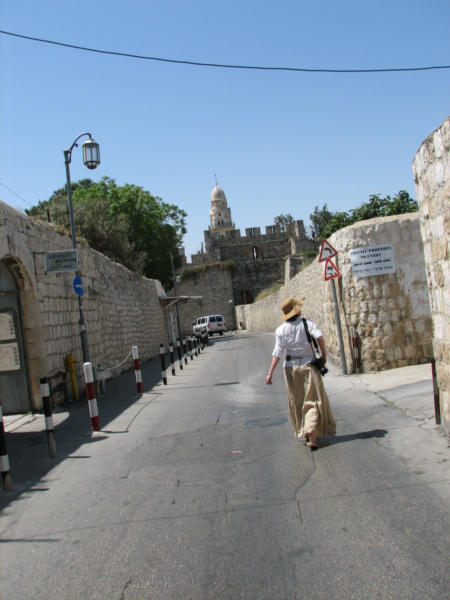 |
[The Citadel (aka The Tower of David) in background. Most likely site of Christ's trial and condemnation] |
The South-West corner of the Old City and the "road" heads east. It was about here Rick remembers he'd gotten lost exactly here, 18-years ago, this week. We need a map. |
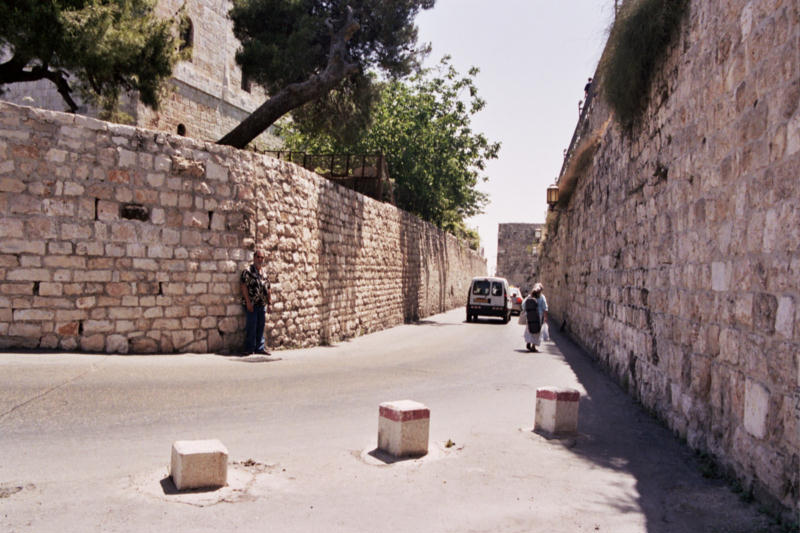 |
Along our lost way we pass our second gate to the city: Zion Gate. It's pretty pocked-marked with bullet holes from the 6-Day War of 1967. There's also damage to the wall's base where soldiers tried (unsuccessfully) to blast their way through with explosives. |
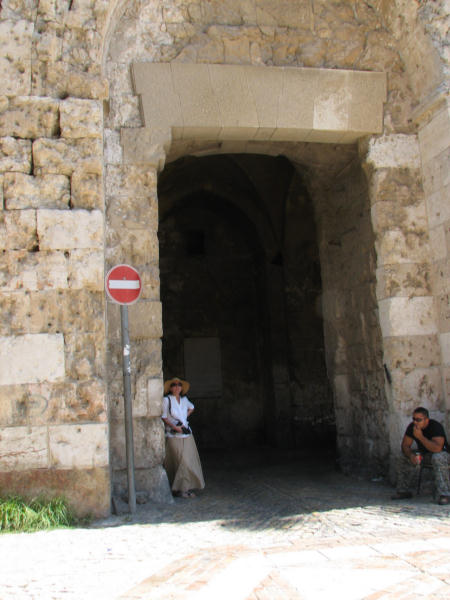 |
[In Arabic, it's known as the Gate of the Prophet David because of its proximity to the place traditionally held as King David's Tomb. The Tomb of David is actually a 15-minute drive from here.] |
The Jewish Quarters. Sidna Omar Minaret (in the Jewish Quarters?). |
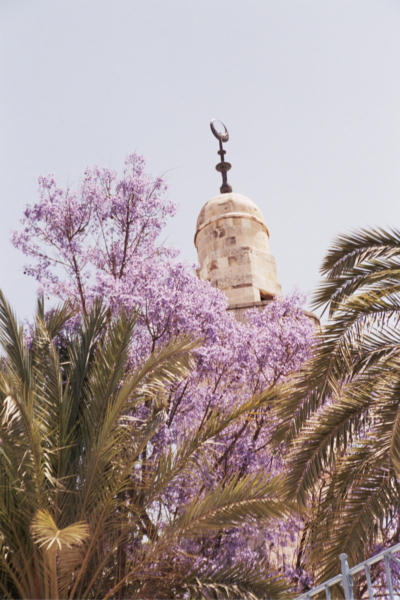 |
[After a few hundred 18th-century Polish immigrant Jews fell behind on loan payments, the Hurva Synagogue complex was burned to the ground by creditors. This arsonist act also destroyed the Rambam Synagogue and the mosque of Sidna Omar. Today, all that remains is the mosque's minaret (above) and a reconstructed arch of the Hurva Synagogue's former main facade.] |
The Cordo. What at one time (King Herod's) was the main East-West road through the Old City. Newly excavated, it's now the most expensive underground MALL in the city. Joan bought some jewelry here. Rick bought a mezuzah for a friend. |
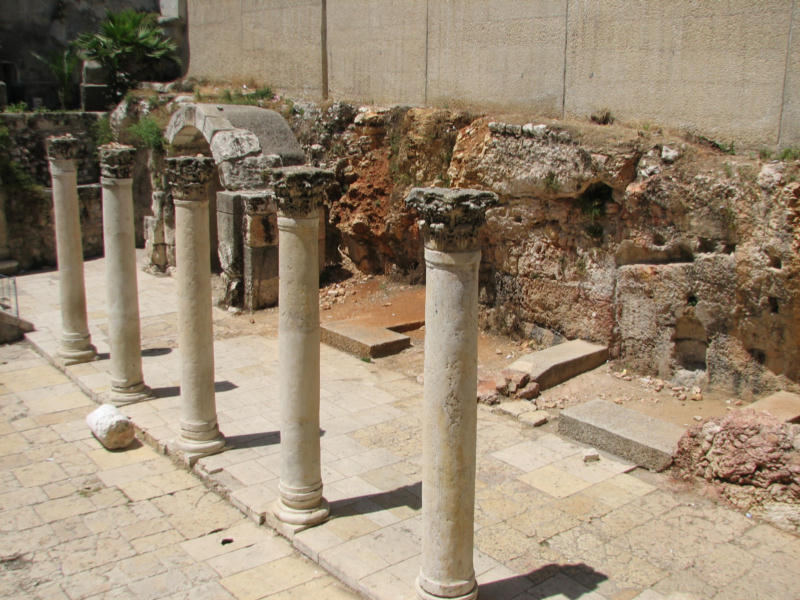 |
[A reconstruction of the original Cardo showing the remains of original shops that were partly hewn out of solid rock and columns used to hold the cedar covering over the 41-foot wide roadway.] |
Joan shooting The Cordo from an elevation known to be from Byzantine times (6th Century). |
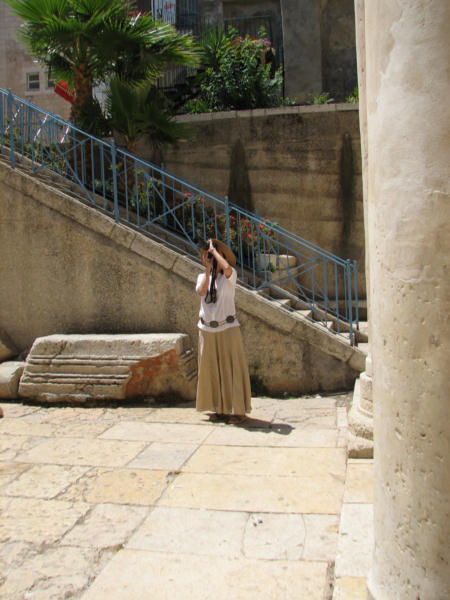 |
Even under the Byzantine streets, further excavation revealed even older antiquities. Perhaps 2500-years old, or older. This column base lies 15-feet below our Byzantine level... ... and stands atop another 20-feet of sculpted stone. |
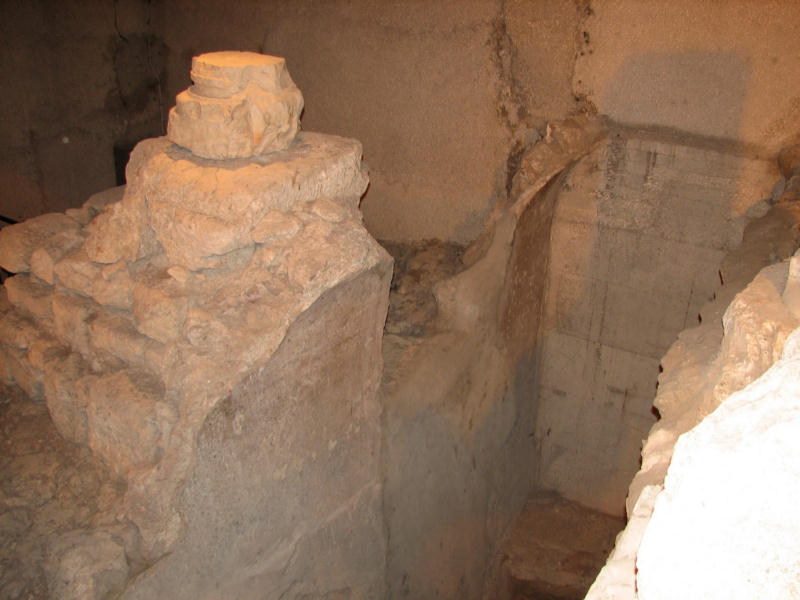 |
AHH-HA Moment #2 Yes, that's exactly what you think it is, Solomon's Temple Mount. The Dome of the Rock in the background and the Western Wall (The Wailing Wall, Ha'Kotel) in the foreground. AHH-HA. |
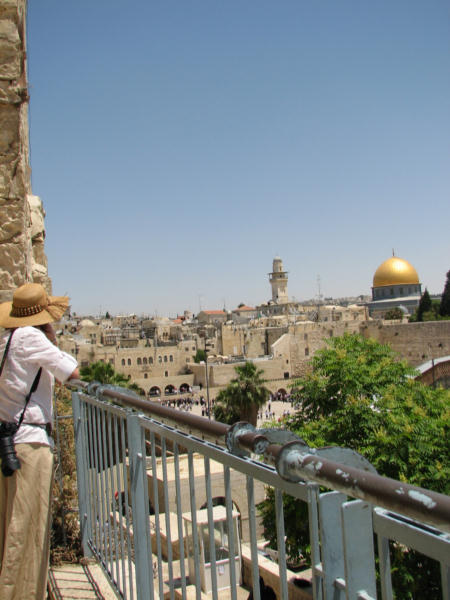 |
I don't know why I included this picture. We're walking down to The Wall. First we'll go thru a very serious security check. No levity! |
 |
Ha-Kotel ha-Maaravi (The Western Wall, or, The Wailing Wall) Judaism's holiest site. Actually, The Wailing Wall and the Other Wall which separates the women's side (right) from the men's side (left). All this in an effort so as to not distract the men while they pray. AS IF! |
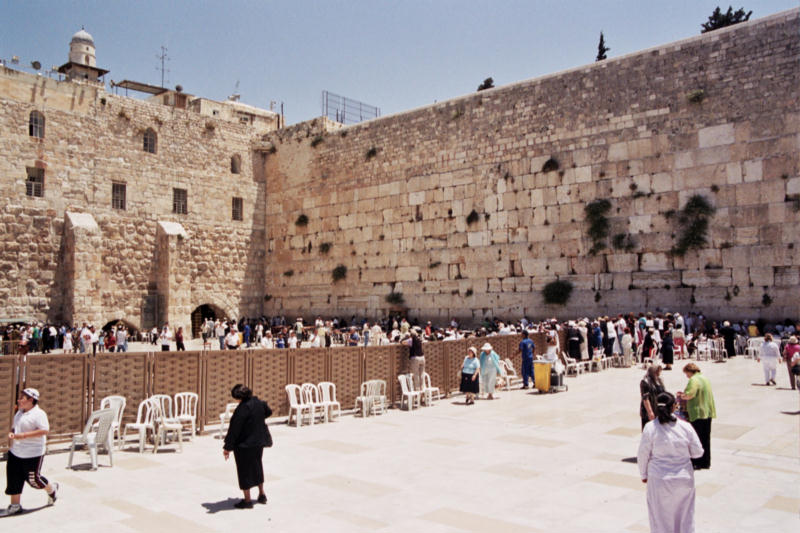 |
[The only remaining section of the retaining wall of the Temple Mount. Built by Herod the Great in 20-BCE during his expansion of the Temple enclosure. The huge, lower stones (and 80-feet more of them below-grade) are Herodian. Those higher up date from Omayyad and Fatimid (Turkish) times. The top-level finishing stones are Persian. Jews pilgrimage here to lament the destruction of The Second Temple in 70-CE, giving it the name, the Wailing Wall.] |
Bar Mitzvah set-up, on the men's side. Women can stand on chairs and watch the festivities... ...from their side. |
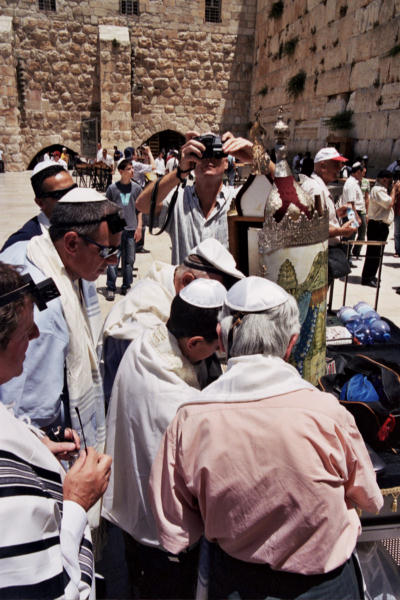 |
And Rick gets approached while writing a prayer to stick in the wall. They guy wanted to bless me before I prayed, until he found-out I was a Cohen. Then he wanted ME to bless HIM! I let him bless me. Then he asked for 20-shekels (for his children, of course). We settled on ten. |
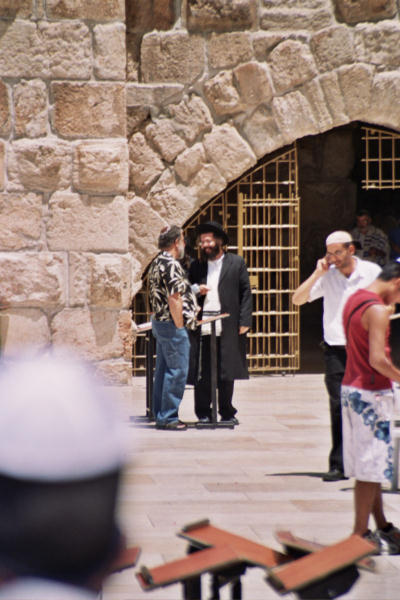 |
Then it was quiet time at The Wall. |
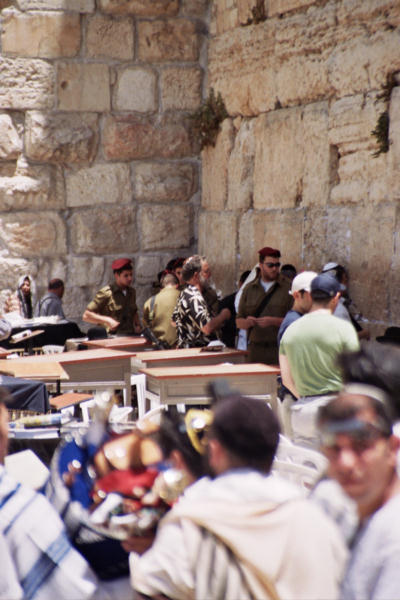 |
And on the girl's side, girls just being girls... with guns. |
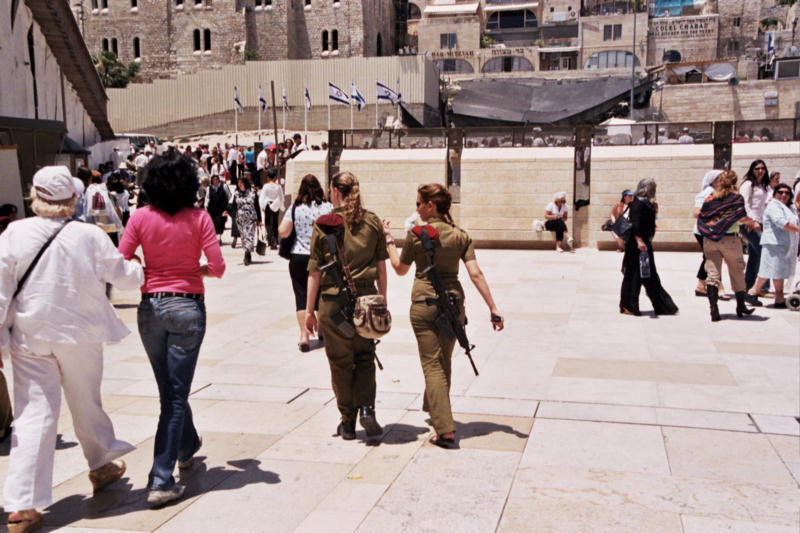 |
Looking back at the Jewish Quarters from The Wall. |
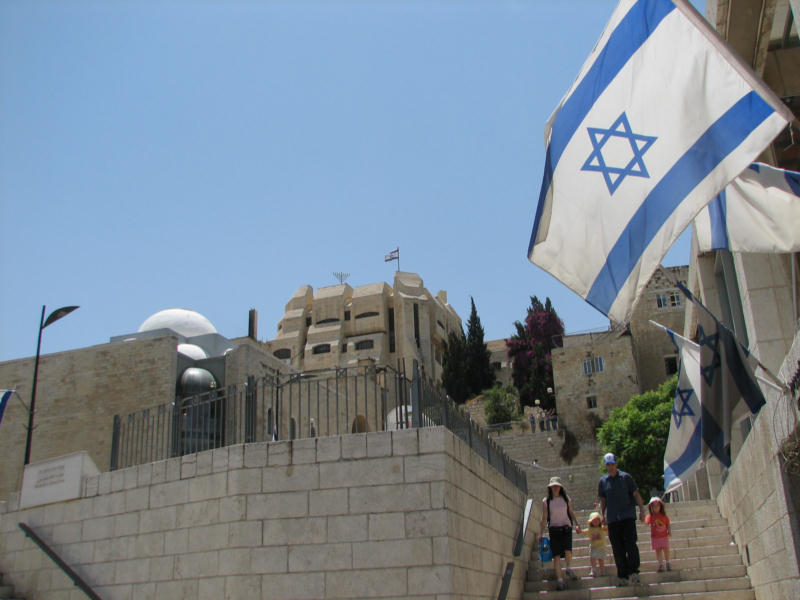 |
And looking east toward the Mount of Olives. (remember those trees in the upper left corner) |
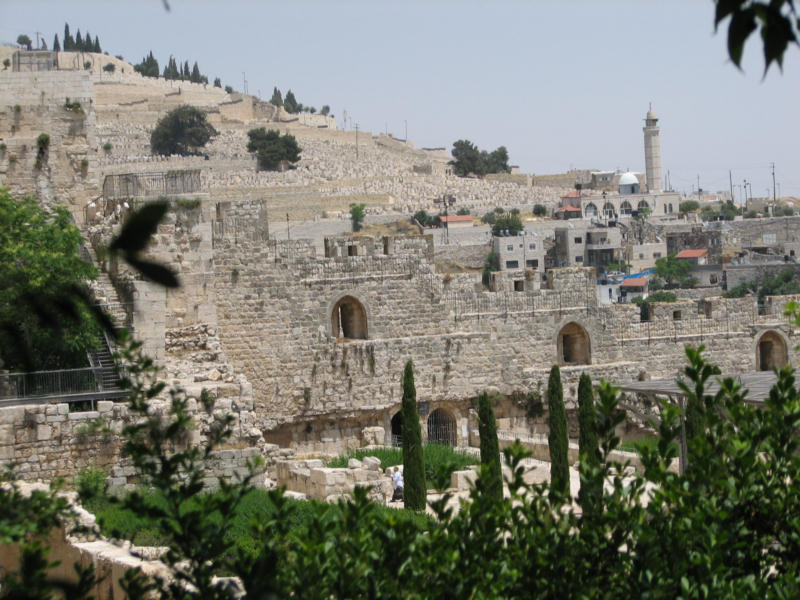 |
The Arab Quarters. Stepping on to the Temple Mount (in Arabic Haram esh-Sharif the "Noble Sanctuary"), the site of Solomon's Temple and the Second Temple. Now the site of both the El-Aqsa Mosque and the Dome of the Rock. [antiquity-strewn area in front of the Museum of Islamic Art] |
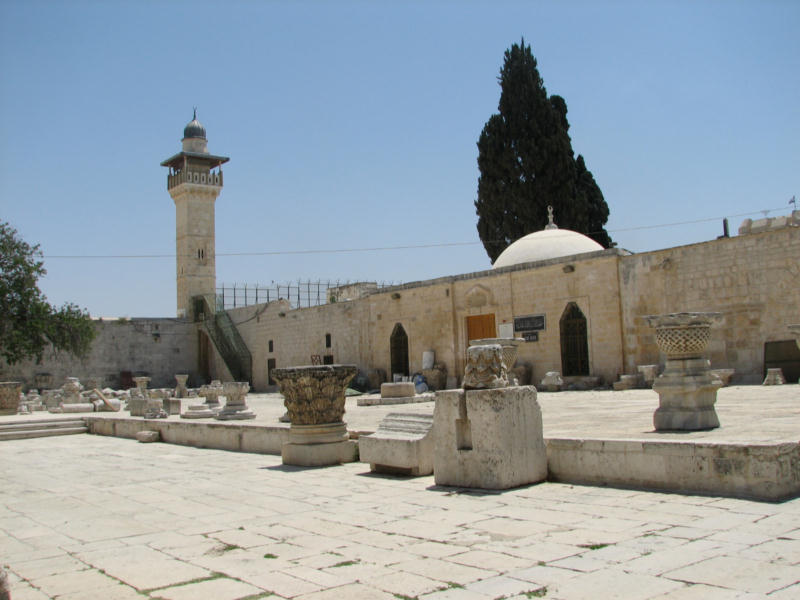 |
[The Temple Mount is a vast esplanade constructed atop huge archways. Beneath the deck of the mount are mostly unaccessible catacombs and the rock outcropping believed to be the site of where: Abraham was asked to sacrifice Isaac, the site of the Holy of Holies of Solomon's Temple and later where Muhammad left the Earth on his Night Journey (the one and only possible reference to Jerusalem in the Koran, and then, not by name).] |
The El-Aqsa mosque itself was "closed to all non-Muslims, on this day, pending negotiations between the Palestinian and Israeli authorities." Damn politics! |
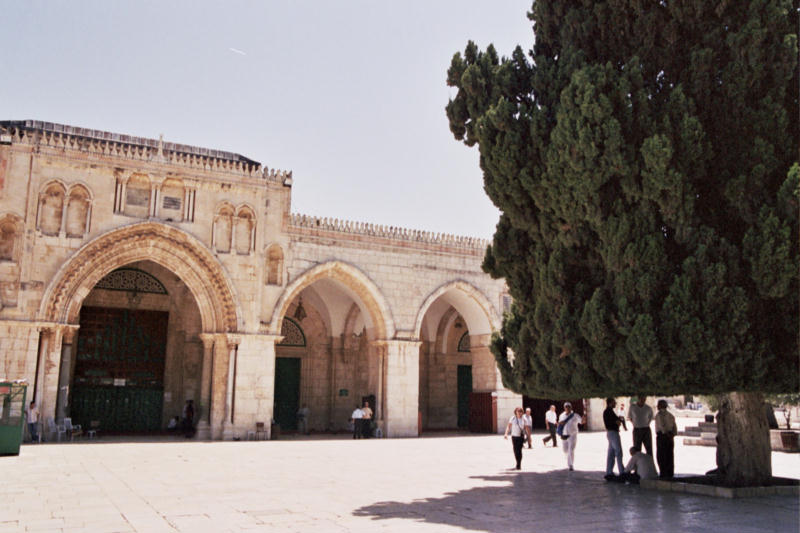 |
[Shown here are four of the seven facade bays of entry. Twice in history, this building was razed to the ground by earthquakes. It's present form dates to the 11th Century.] |
So we head across the Temple Mount to the Dome of the Rock. |
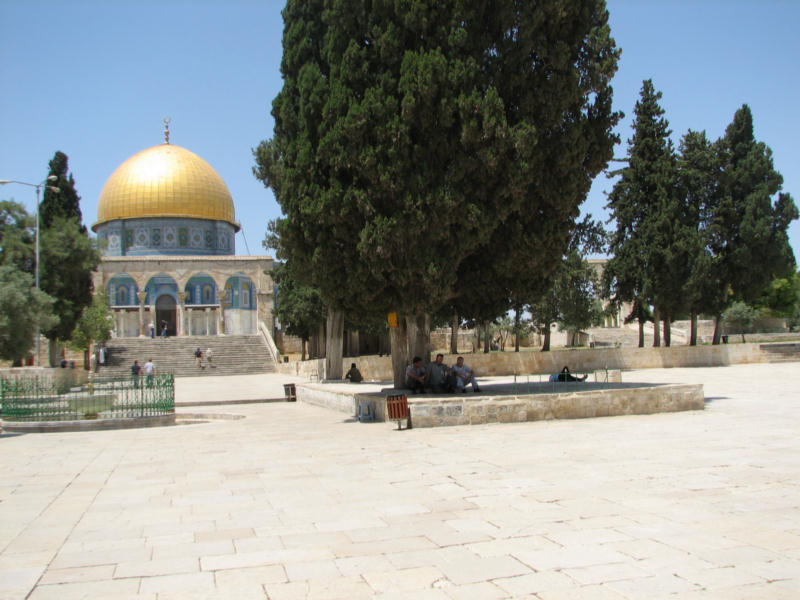 |
[One of the first and greatest achievements of Islamic architecture. Built in 688-691, The Dome of the Rock has become more a shrine and a symbol of the city than a mosque. The dome was originally made of copper, but is now covered with gold leaf, thanks to King Hussein of Jordan. Beneath the dome, the drum is decorated with verses from the Koran telling of the Night Journey. Leading up to the dome in all directions are eight sets of stairs topped by a set of archways. Each set of stairs and archways (called qanatir) are unique in size and length and date from different periods. Some column capitals were recycled from Roman-era buildings.] |
Joan and one of the Qanatirs leading up to the main entrance of the Dome. This Qanatir is unique in that it's stairs are carved out of the stone of the platform. |
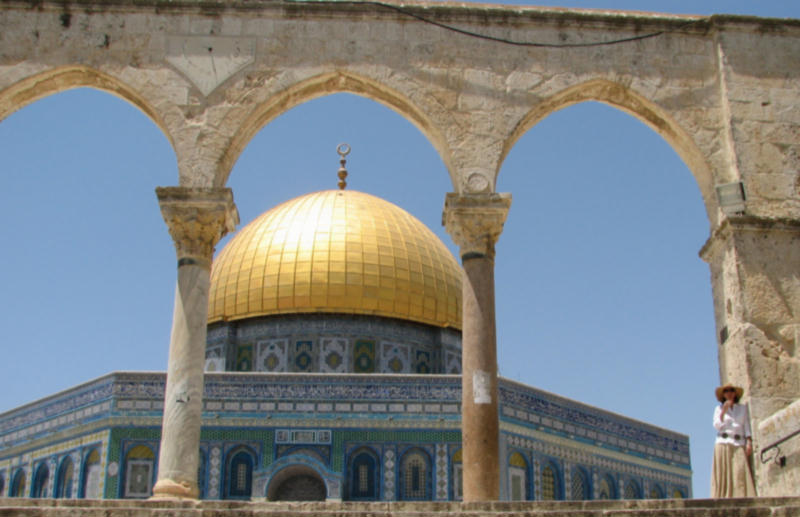 |
The place is HUGE! But, "closed to all non-Muslims, on this day, pending negotiations between the Palestinian and Israeli authorities." Politics, damn! |
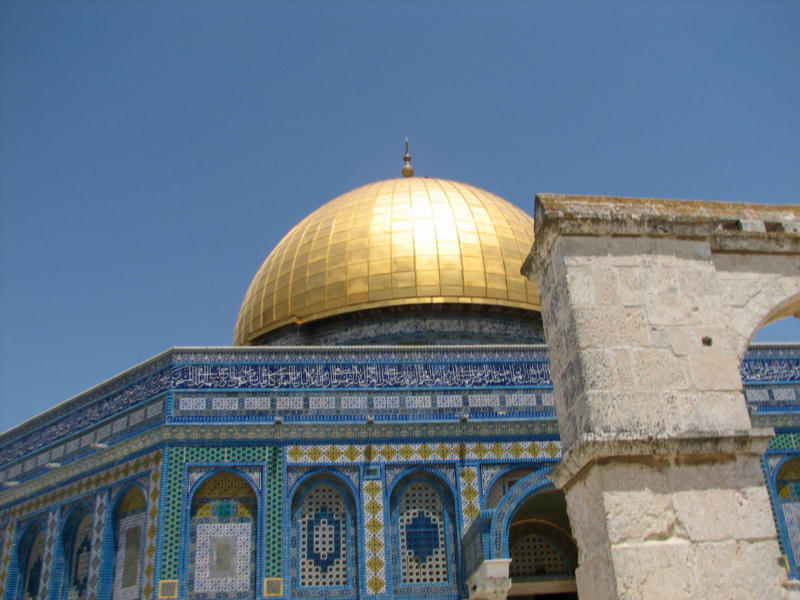 |
The top band of mosaics contains passages from the Koran. |
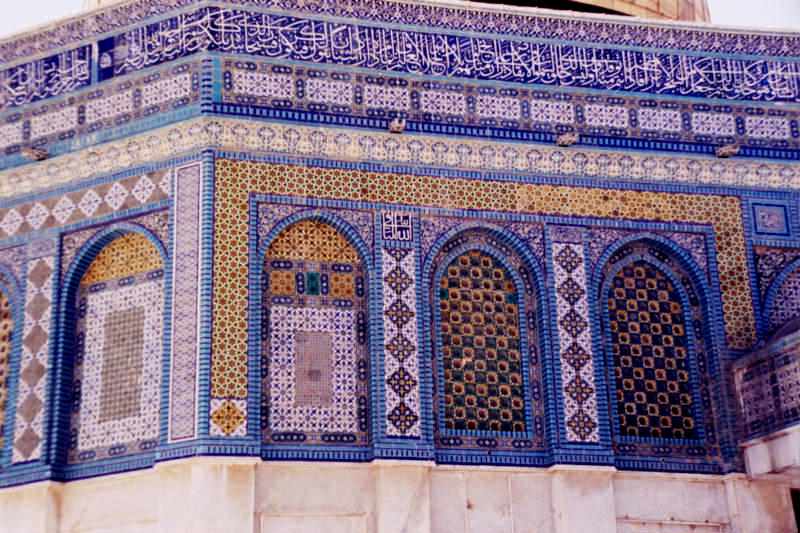 |
Everywhere on the grounds are little buildings. This one is a public water fountain. Behind the fountain can be seen the Cotton Merchant's Gate, thru which non-Muslims are not allowed to pass (although it is the best way to get into the Jerusalem market). We didn't know the Muslim password for the day, so we were turned away and had to walk 35-minutes to the non-Muslim passage. |
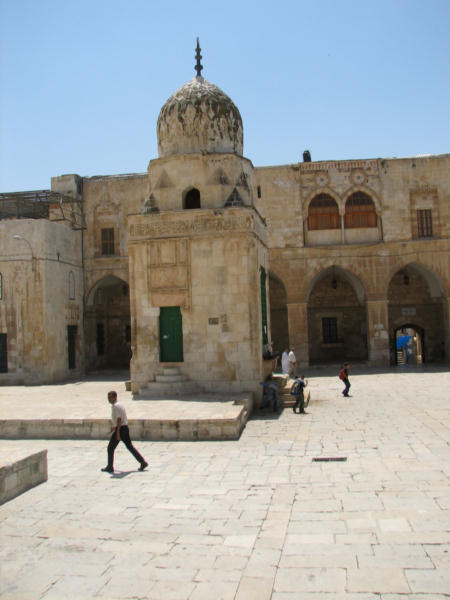 |
[The Sabil of Qaitbey fountain was built on the order of the Mameluke sultan Qaitbey (1468-1498). It has a carved stone dome, the only one of its kind in Israel.] |
Dome of the Prophet, a qanatir, Ashrafiyya Madrasa (Islamic Religious School) and minaret in the background. From this minaret (one of four on the Temple Mount), the call to prayer can be heard five times daily throughout the entire Old City (thanks to Bogen pre-amps, amps and dome-horned speakers). |
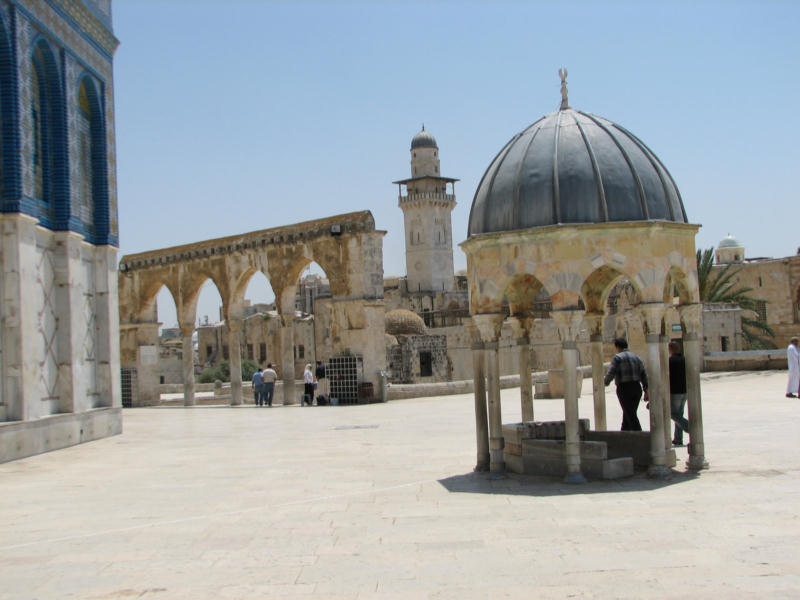 |
Nowhere a sign of hostility. People couldn't have been nicer. |
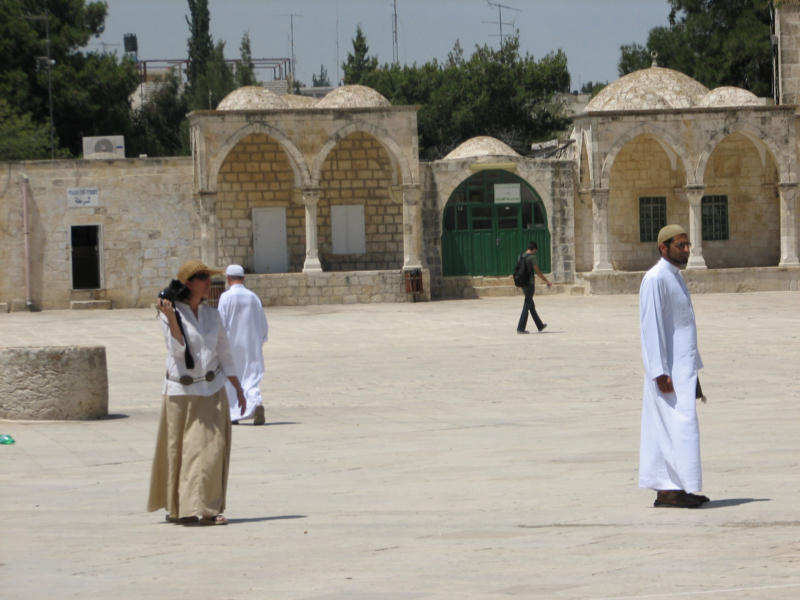 |
Another archway. |
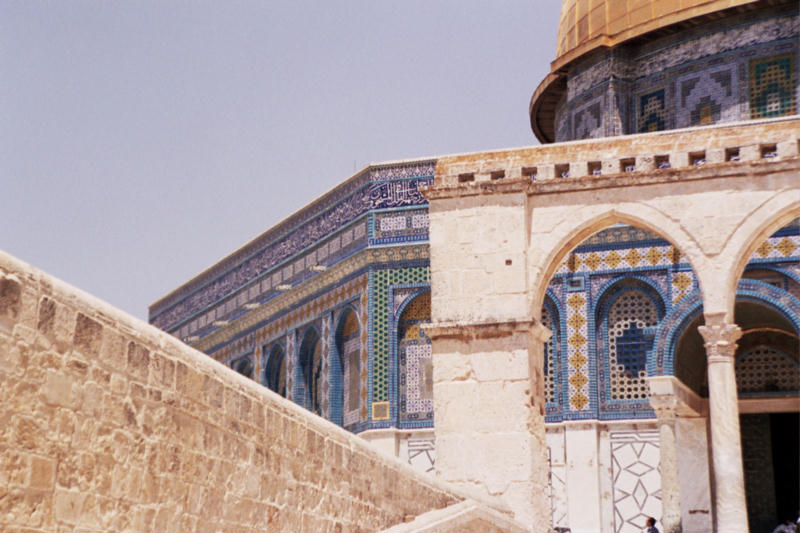 |
Another worshipper. |
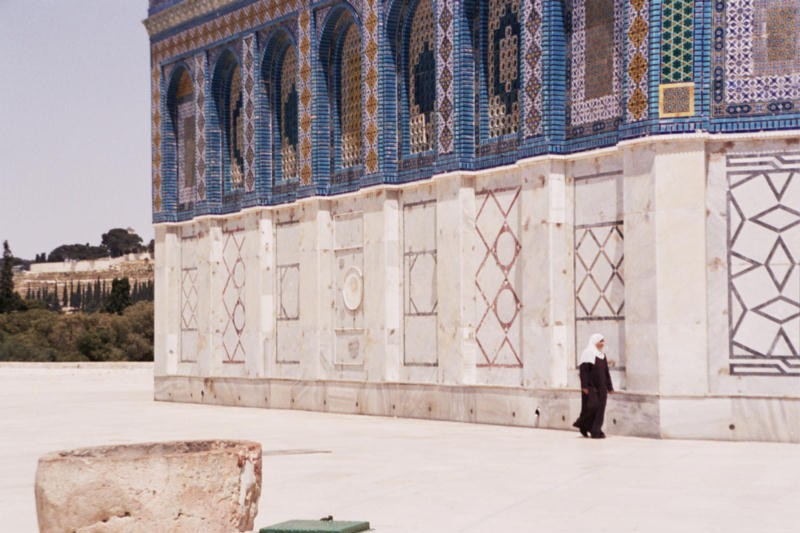 |
Israeli Police, taking five. (remember them) |
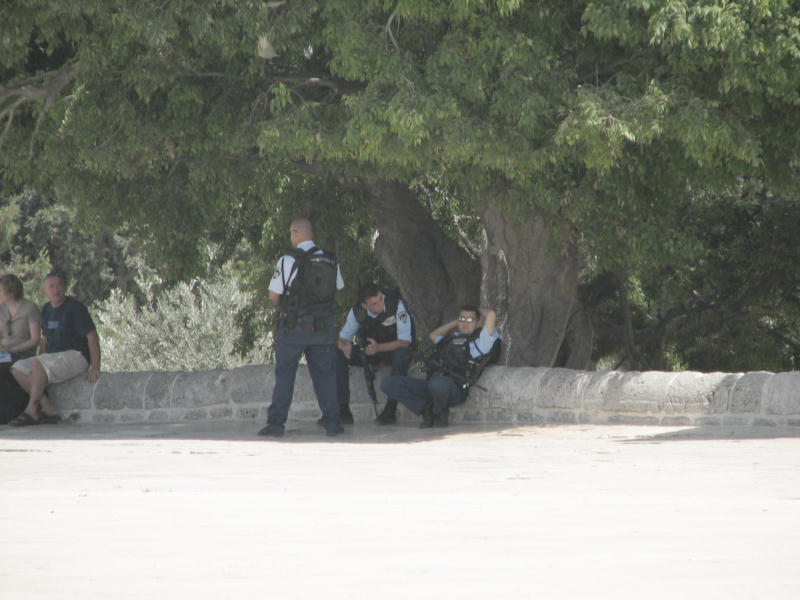 |
Dome of the Chain. Stands at the approximate center of the Temple Mount (or, the center of the world, according to one story). The 13th-century interior tiling surpasses even that of the Dome of the Rock. But, on this day it was being used by lots of shrouded ladies and little children, so we didn't venture "inside" to have a look-see. |
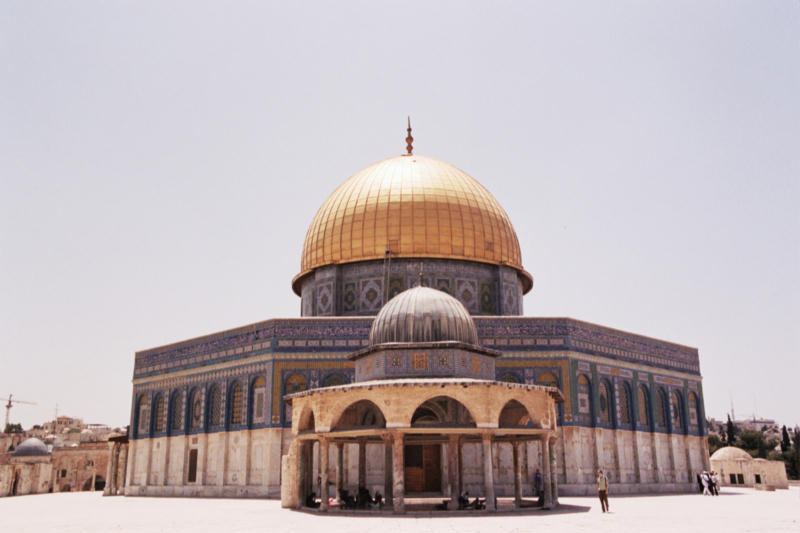 |
Looking east from the Dome of the Chain towards the Mount of Olives. The Russian Orthodox Church at Gethsemane. (lower left) |
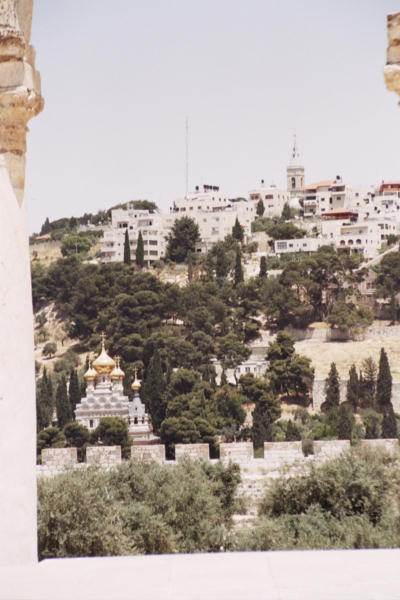 |
Looking north to some more arches. |
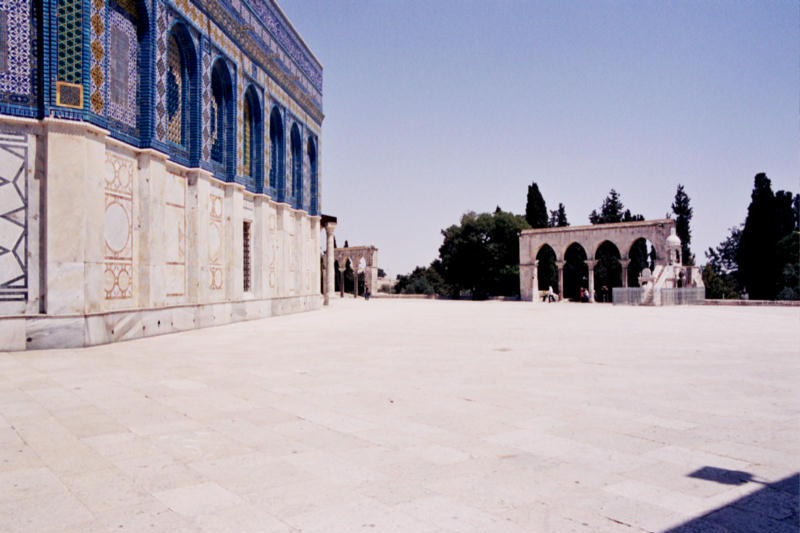 |
Guess what? |
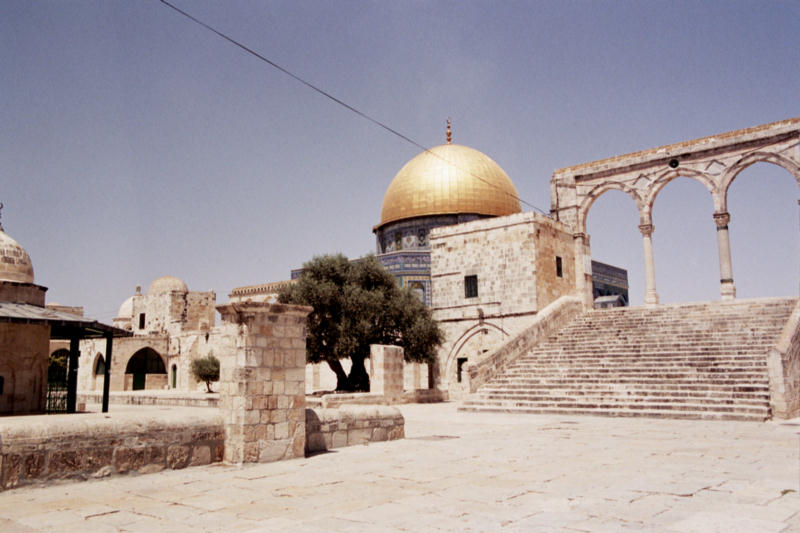 |
Guess Who? |
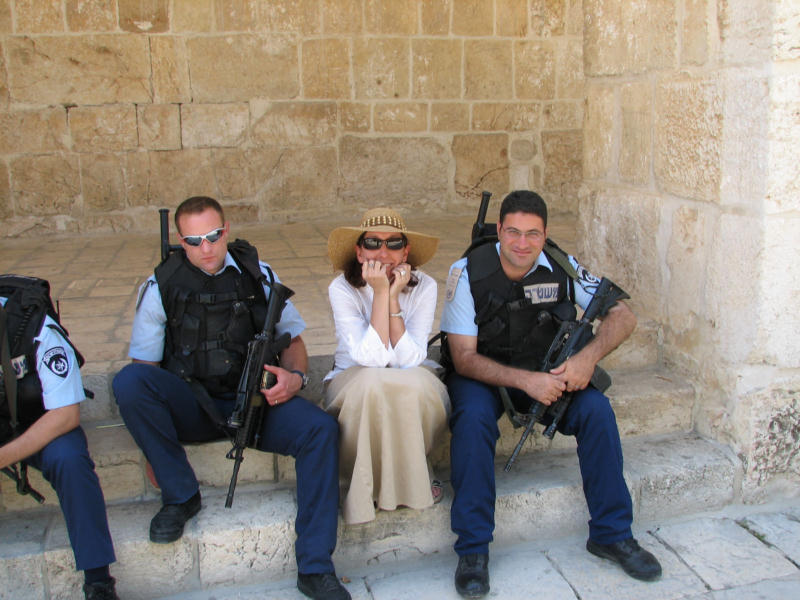 |
The Christian Quarters. Once off the Temple Mount, we head to the Church of the Holy Sepulchre. Looking back at the Dome, we notice the juxtaposition of a satellite dish on the Dome. Then Rick realizes he's been lost here before. |
 |
We "make it to the Church of the Holy Sepulchre on time" ... ... to be greeted by a busload of pilgrims. |
 |
[Just inside the church's massive doors lies The Stone of Unction where the anointing and wrapping of Jesus's body has been commemorated since medieval times.] |
The stone itself (plus several pilgrims) |
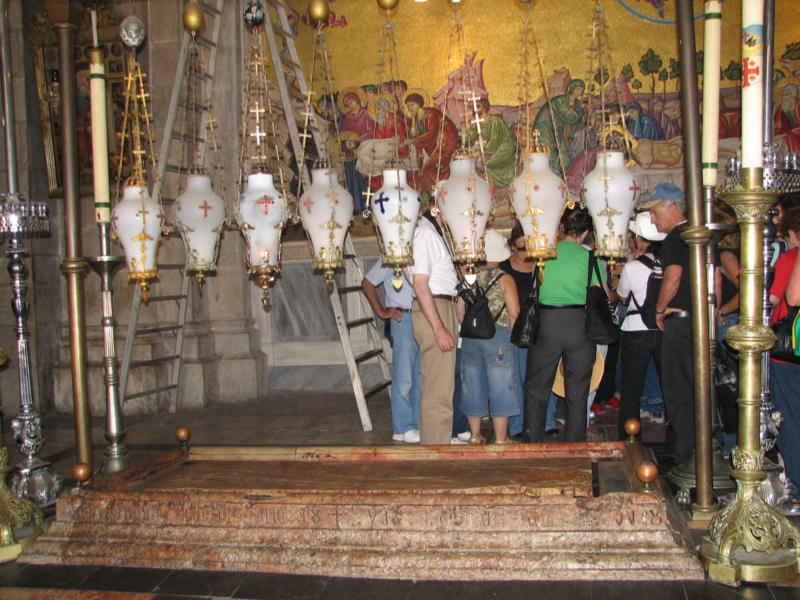 |
Calvary Hill. Not exactly what the movies show. |
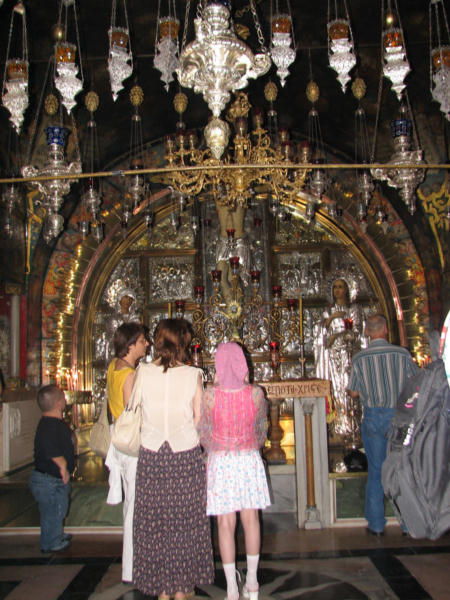 |
[A VERY steep stone staircase to the right leads up to Golgotha ("Place of the Skull" in Hebrew and translated into Latin as Calvary). The Rock of Golgotha can be seen through the protective glass around the altar (left and right). This is the 12th Station of the Cross. |
The original stone hilltop of Calvary Hill. |
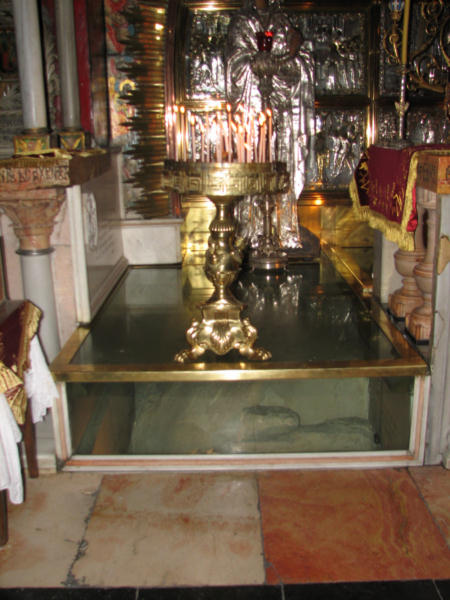 |
And, if you are nimble, and so inclined... |
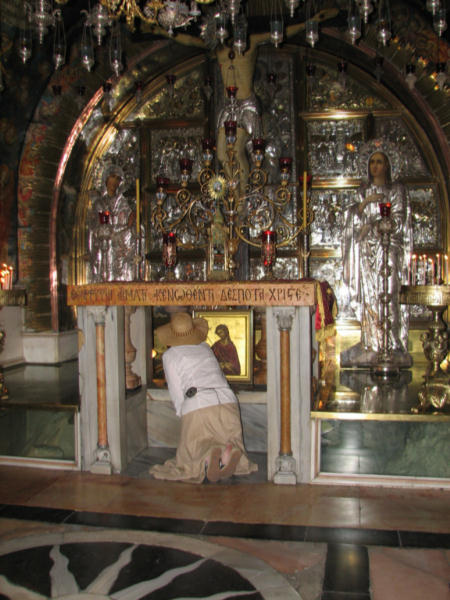 |
...you can touch the Rock of Golgotha through a hole in the glass. |
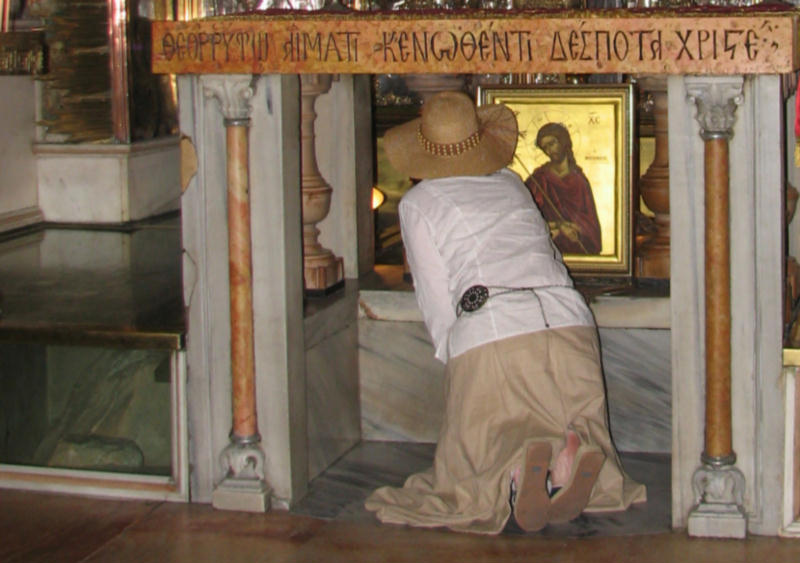 |
A special moment. AHH-HA. |
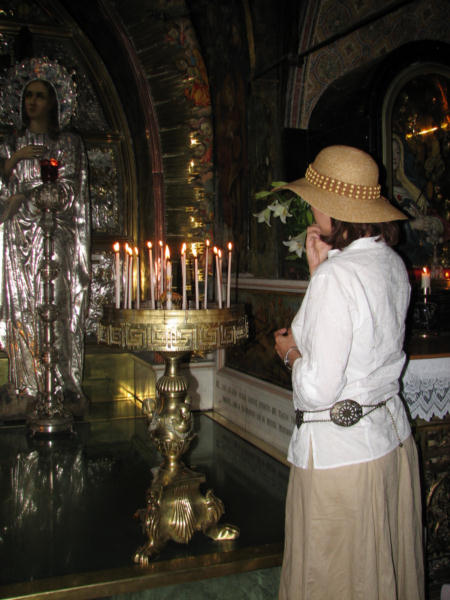 |
[The Altar of the Stabat Mater, commemorating Mary's sorrow as she stood at the foot of the cross. It marks the 13th Station of the Cross.] |
The open dome above the Holy Sepulchre. |
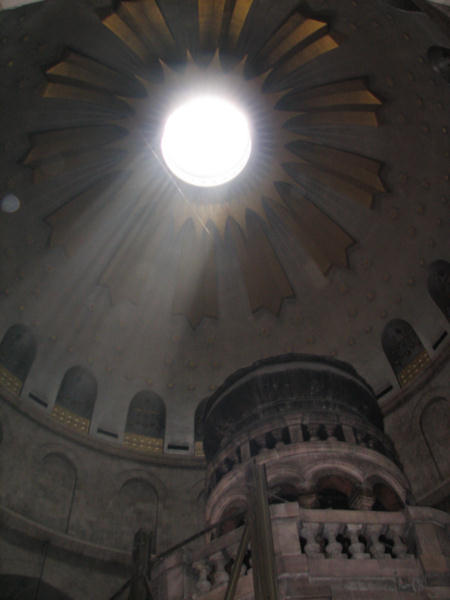 |
[The original shrine had Constintine's builders digging away the hillside to leave the presumed rock-hewn tomb of Jesus isolated and with enough room to build a church around it. In doing so, the Rock of Golgotha was also found. After being destroyed and rebuilt several times, the current Holy Sepulchre shrine was built in 1809. ] |
The back of the Holy Sepulchre. |
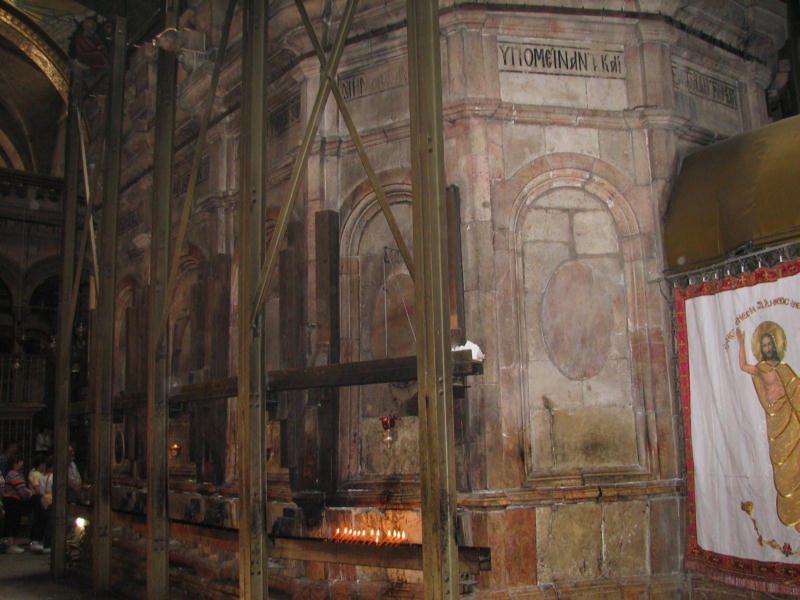 |
Again, the back of the shrine which serves as a Coptic chapel. |
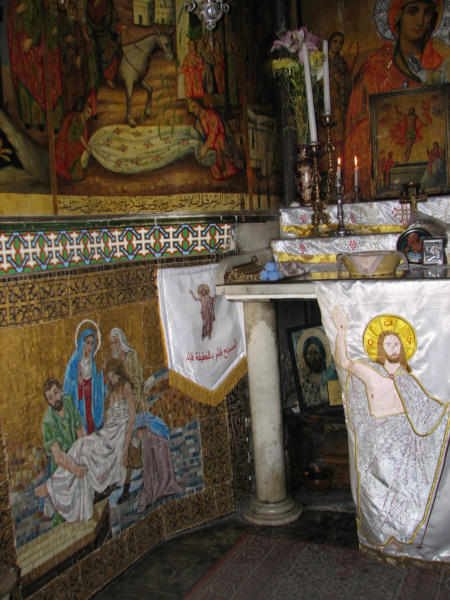 |
The shrine entrance. No photograph can possibly do its beauty justice. |
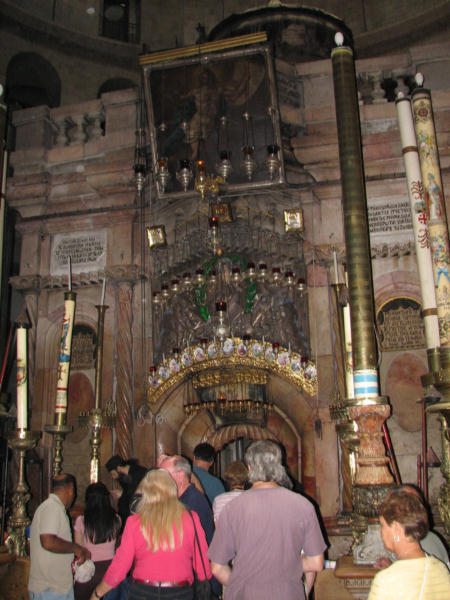 |
Except, maybe this one. The most photographed man in Jerusalem. (note his blue jeans.) |
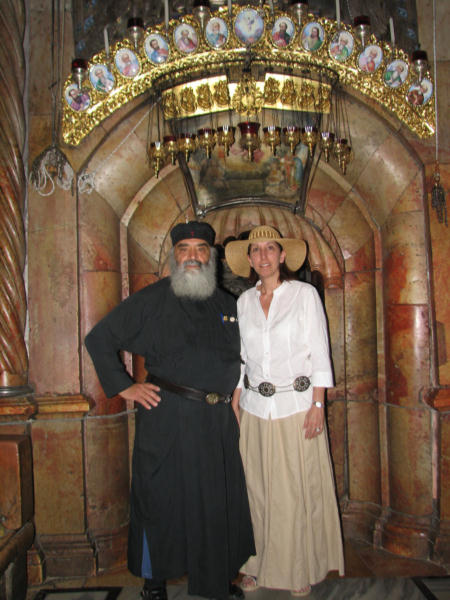 |
[The Holy Sepulchre shrine contains two chapels. The outer Chapel of the Angel has a low pilaster incorporating a piece of the stone said to have been rolled from the mouth of Jesus's Tomb by angels. A low door leads to the tiny inner Chapel of the Holy Sepulchre. It is the 14th (and final) Station of the Cross.] |
Inner Chapel of the Holy Sepulchre. This marble slab covers the place where Jesus's body was laid. [Note: We are told the slab was intentionally cracked to deter looters.] |
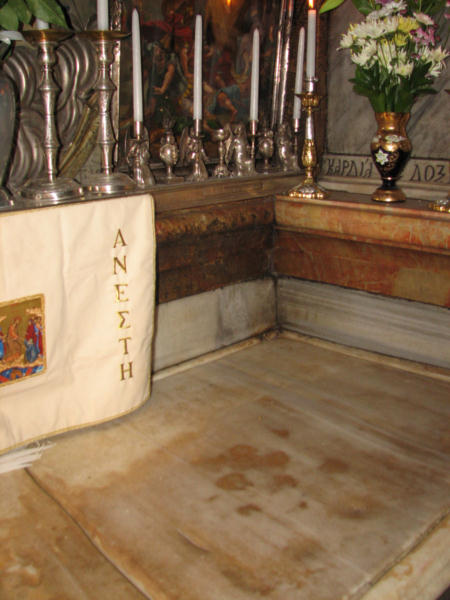 |
Top Of Page |
Just the five of us having dinner in Tel Aviv. |
 |
I'm sure Natalie LOVES this picture. She DID have some Saki. Tomer with a smoke (something he doesn't normally use, but, this was wedding week). |
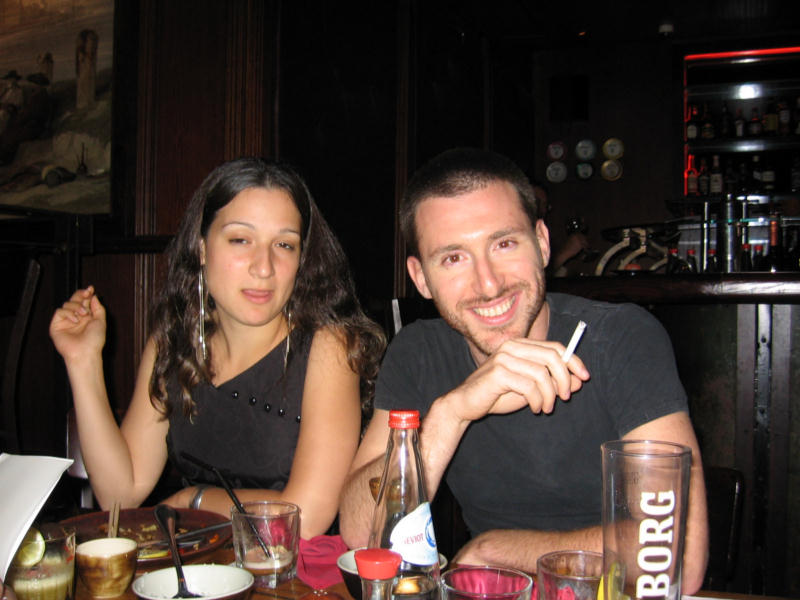 |
Both Monica and Natalie used to work FOR this man at another one of his ventures. And, both used to work WITH this lady, at that same place. Their friendship got us some freebies here and a very good dinner at a very nice place...Yakuza. |
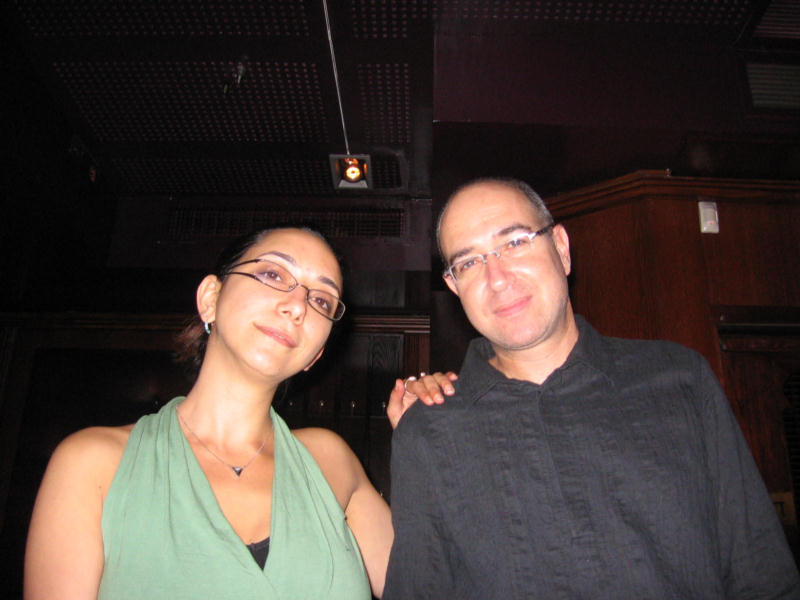 |
Joan bought Rick a new toy for the trip. |
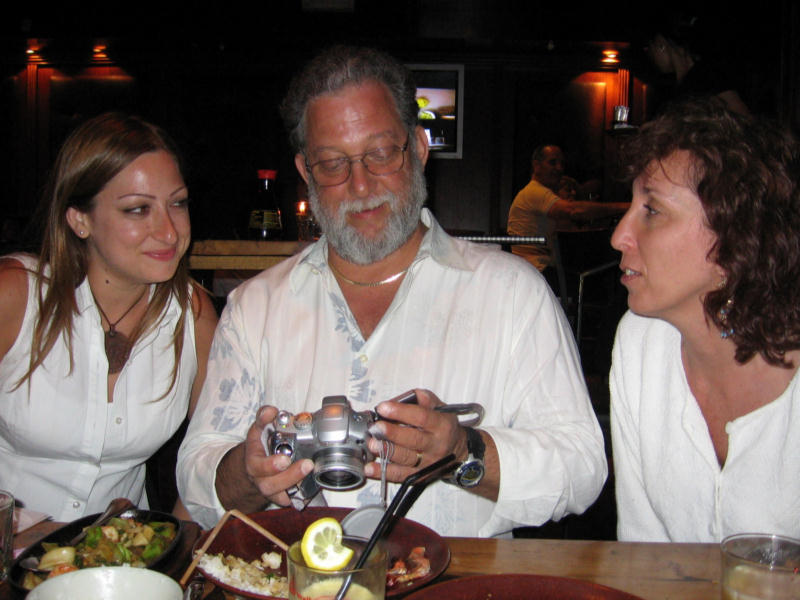 |
I guess he figured-out how to use it. Monica thinks so. |
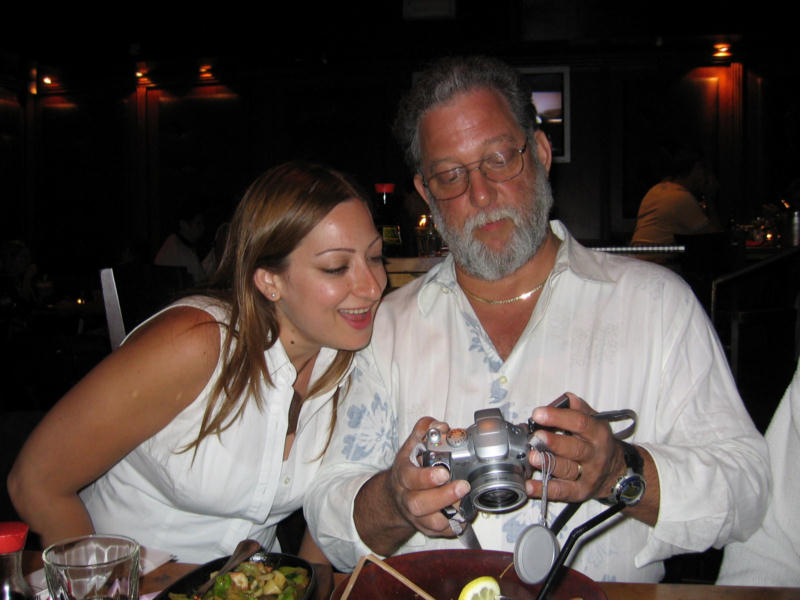 |
Natalie has one of those toys too. |
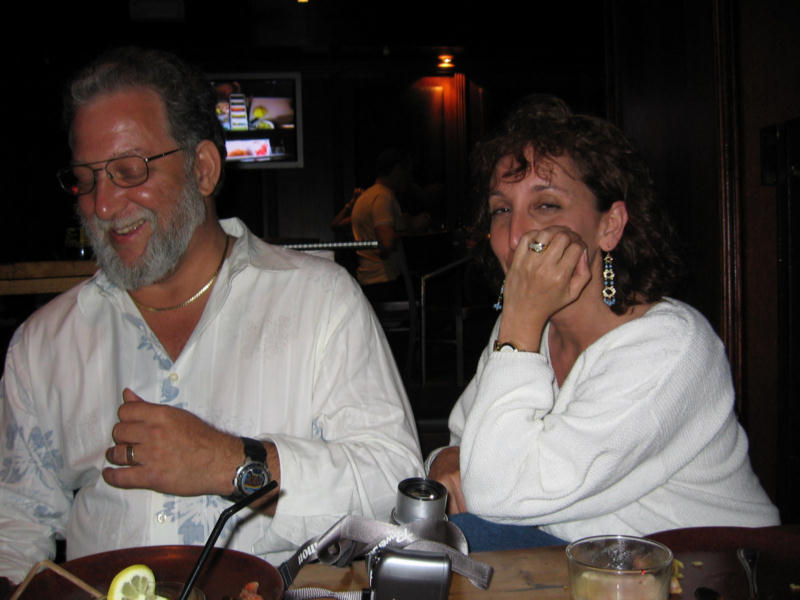 |
Rick and Joan get to see the wedding invitation... for the first time. [Ours arrived at home on about this same day.] |
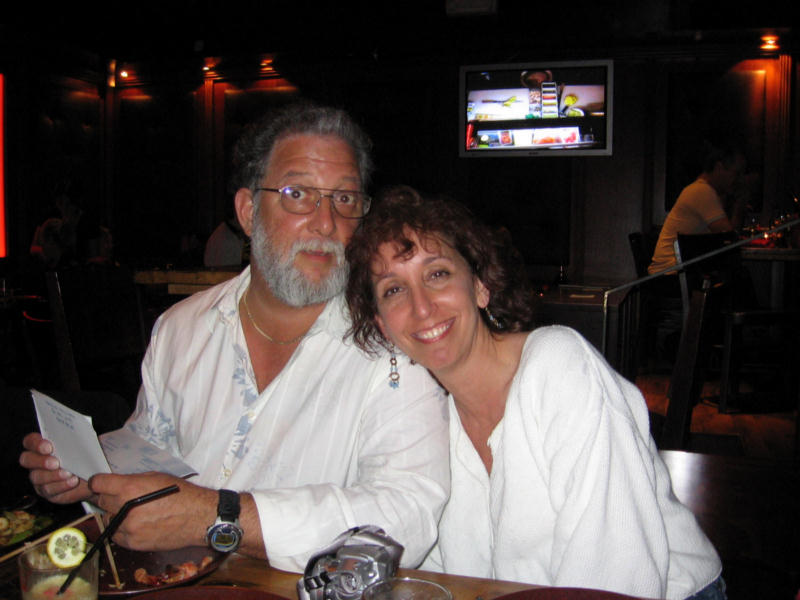 |
After a bit of a walkabout, we land at one of Rick's old watering holes. The Stagecoach, Tel Aviv. It's still there, but "I remember it differently". You can never go back." |
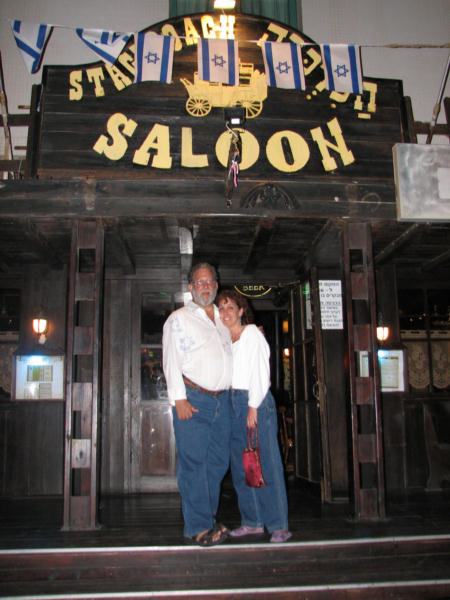 |
Top Of Page |
Unearthed remains dating back to the 20th century BCE, establishes Yaffo as one of the oldest ports. According to the Old Testament, Yaffo was founded by Noah's son Japhet in the wake of the flood. And Jonah (of the whale) caught that ill-fated boat to Tarshish here. Even Peter (New Testament), while staying at the house of Simon the Tanner in Yaffo, had his vision (and thus Christians eat pork and shellfish). EVERYBODY in history conquered Yaffo: The Egyptians (1468-BCE), King David (around 1000-BCE), King Harod, the First Crusaders, Salah al-Din, Richard the Lionheart, the Muslims, Louis IX, the Mamelukes (1267), Napoleon (around 1800) and lastly the United Nations (1948). Restoration efforts, of the then ruins, began in the 1960's. Today, only those making a living as a full-time artist may live within the old city walls. |
We were to meet at the Clock Tower by 08:30 for a 09:00 guided walking tour. They failed to tell us that meant 08:30 ISRAELI TIME... ... OR else, the hundred year old clock needs an adjustment. |
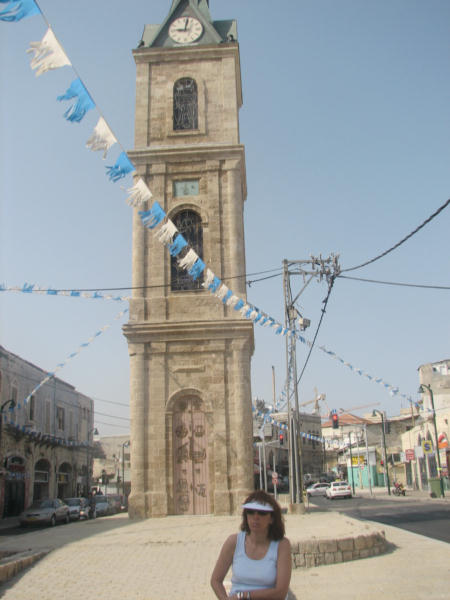 |
Heavily restored, the clocktower now serves as a symbol of modern Yaffo. |
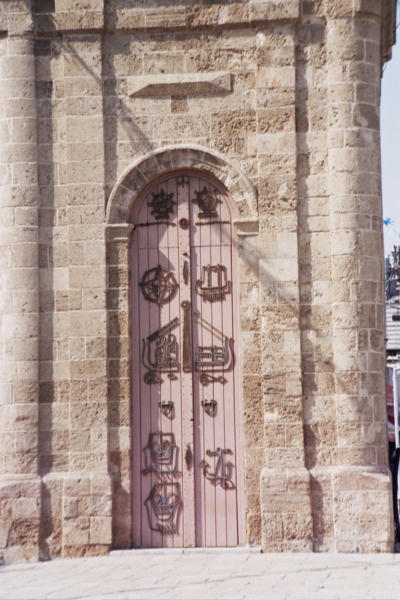 |
A guy from Cleveland, on our tour. He works for Smurfit-Stone (of St Louis). Small World! |
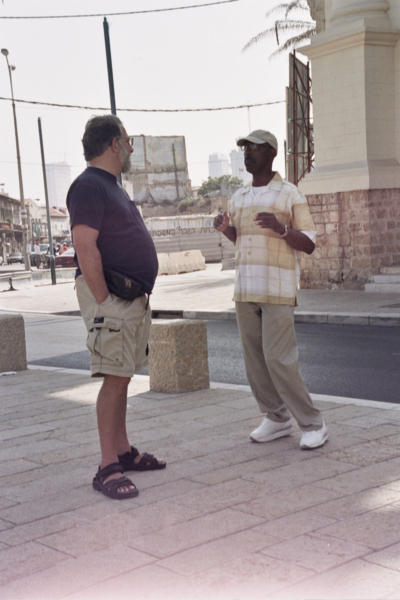 |
Oaky! Now, we're walking, we're walking. Through the Open Flea Market (Shuk Ha-Pishpeshim). |
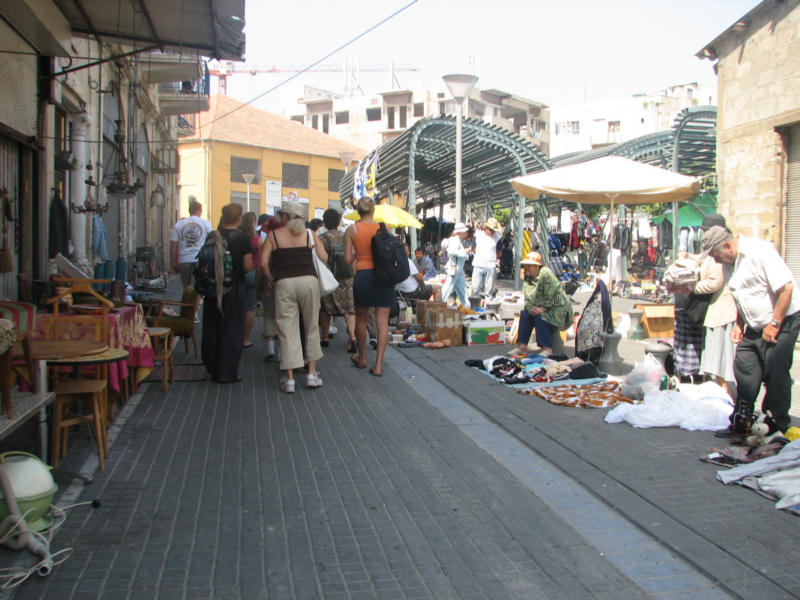 |
Modern Yaffo is known for two things: Artists and Furniture. Sometimes the two mingle and the result ain't always pretty. |
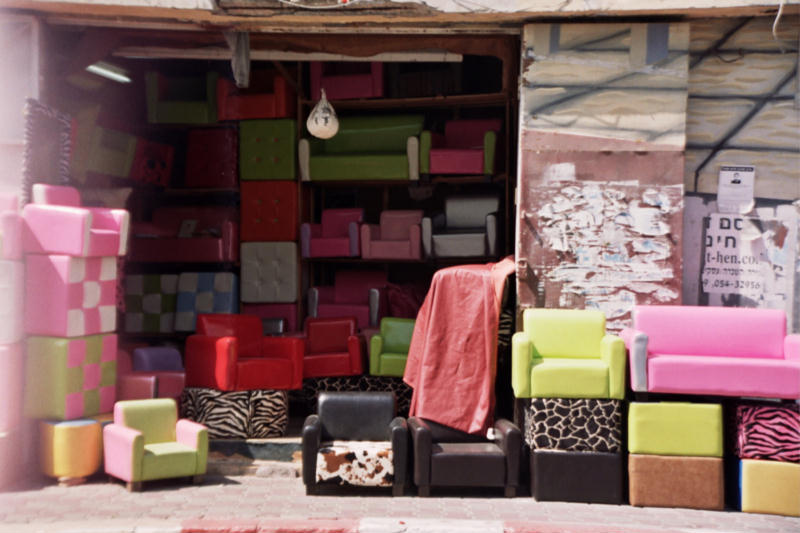 |
I rest my case. |
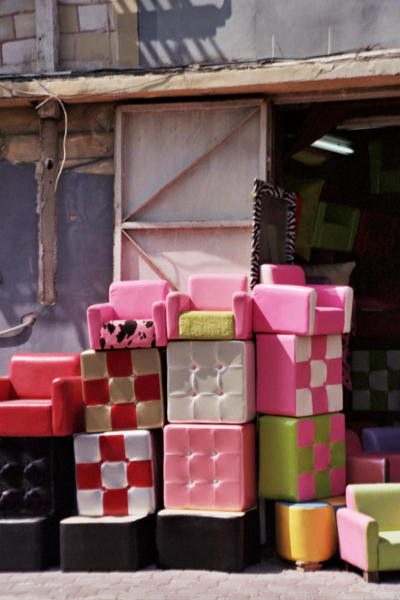 |
Since 1948, the city has been revived. Some of what the contractors haven't gotten to yet, the artists have. |
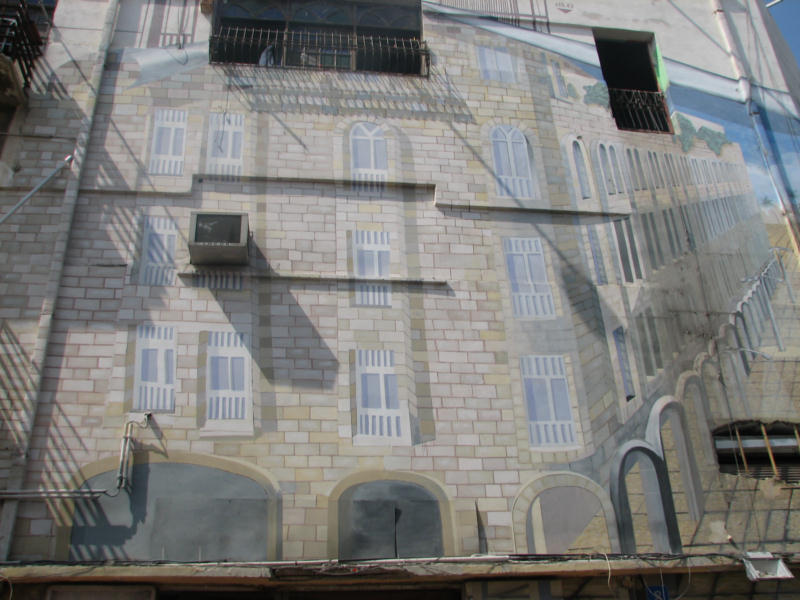 |
And some of what the artists HAVE "gotten to" ... |
 |
... is quite ... er ... "artistic". |
 |
Street signs (right) and addresses (left) are all hand-made. |
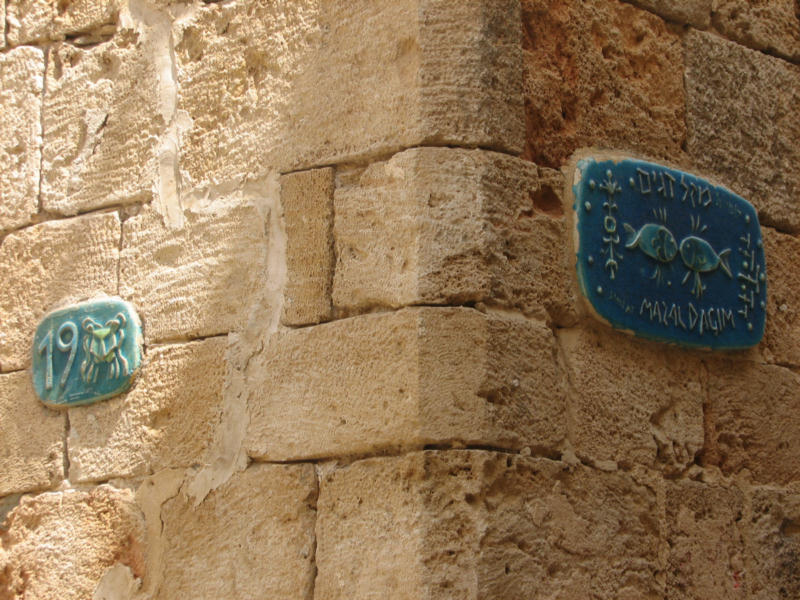 |
[Don't be fooled! What looks to be tuckpointing (on the left)... isn't. These stones haven't budged since they were laid (see corners in the middle). The "tuckpointing" most likely covers added electrical wiring or irrigation tubing.] |
And we're walking, we're walking. Through the narrow streets. |
 |
Ha-Pigsa Gardens contain an excavation of an 18-Century BCE Hyksos town. That would place it from around the time of Joseph ... 3700 years ago. |
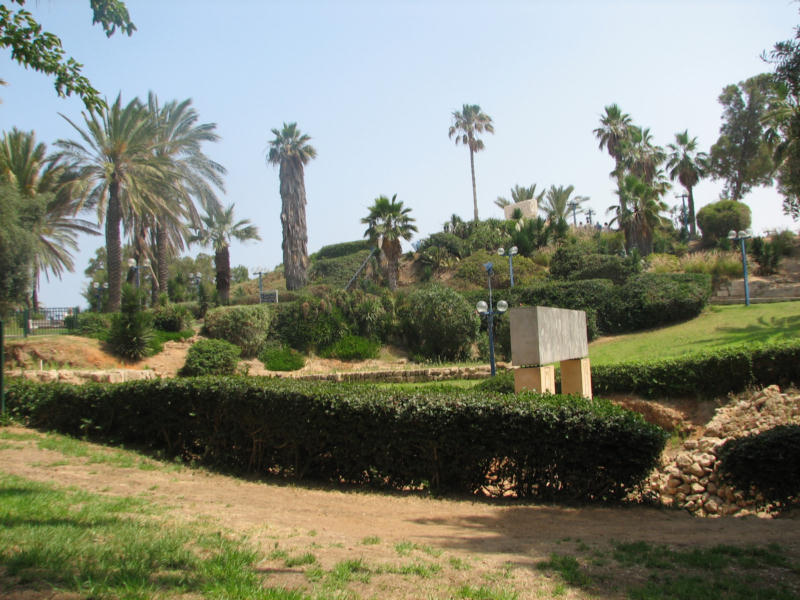 |
A great vantage for looking at Andromeda's Rock (think Poseidon, chains, Perseus and his winged white horse) in the Port of Yaffo (said to be "the worst in the world to navigate"). |
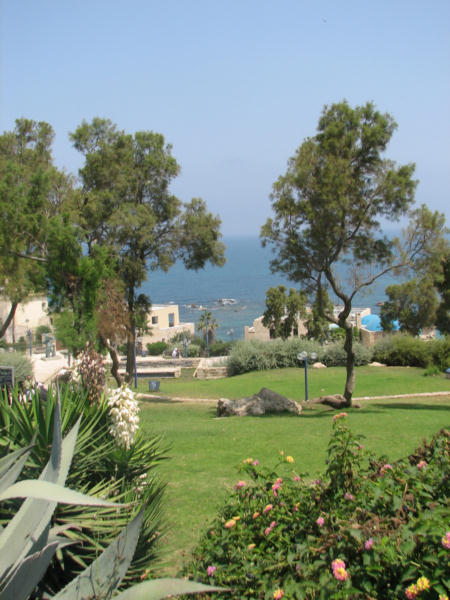 |
The curious Statue of Faith depicts three Old Testament stories. Even when told what the stories were I didn't see a story-statue connection. It's very ... er ... artistic. |
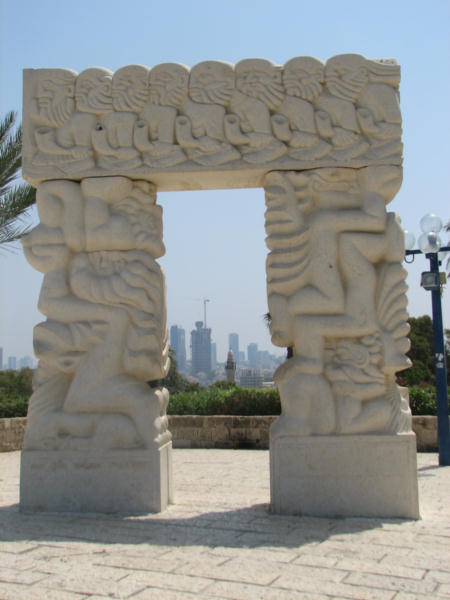 |
A nice photo op... |
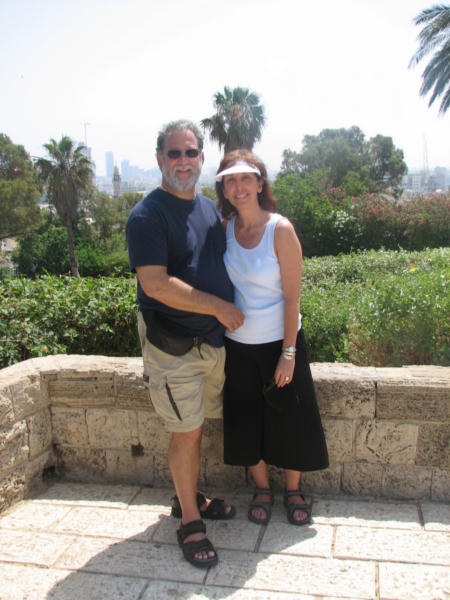 |
...with Tel Aviv in the background. |
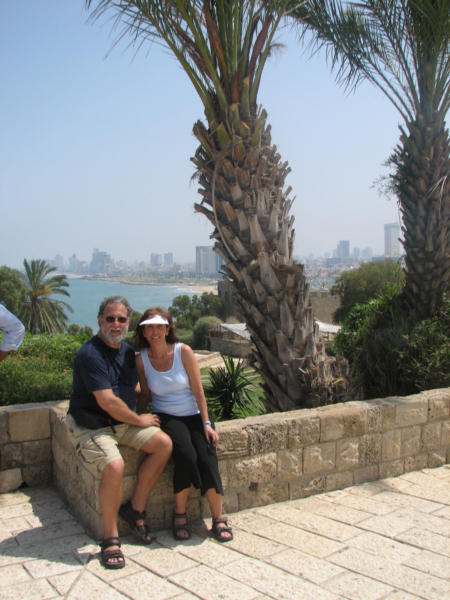 |
The narrow "streets" of Yaffo. |
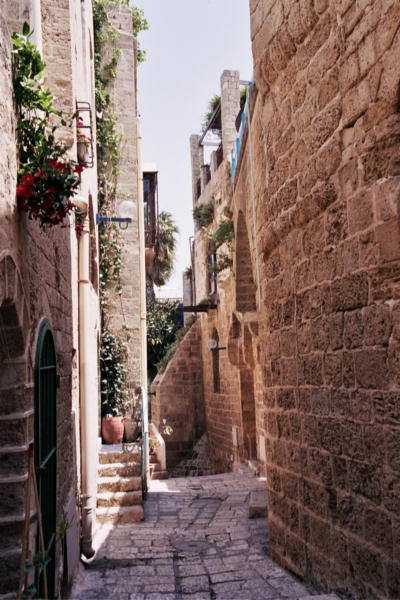 |
The lighthouse-keeper (third generation). |
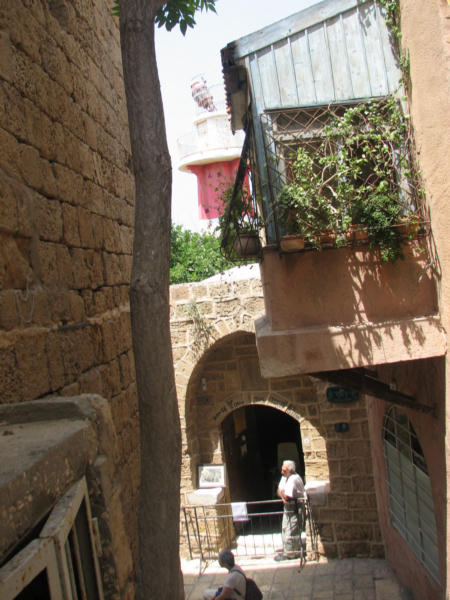 |
Ummmm, not sure. |
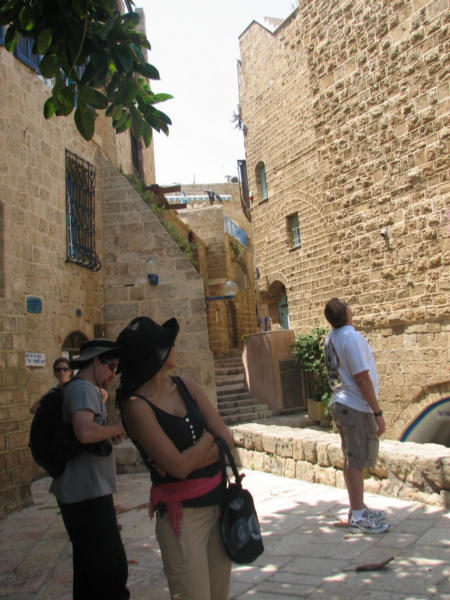 |
As we explore, I'm wondering if anyplace close there's a cardiologist. |
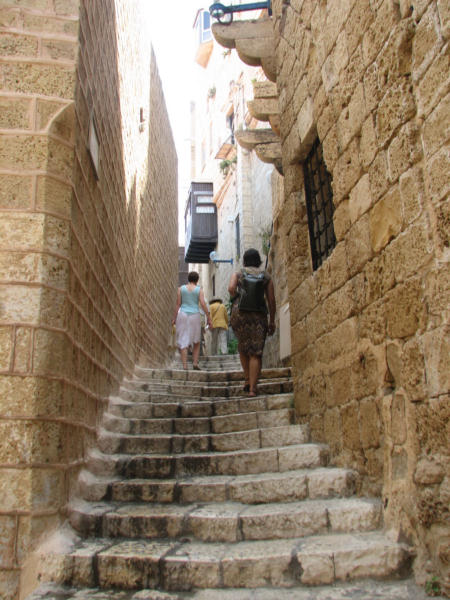 |
Top Of Page |
We're going SHOPPING in Tel Aviv! |
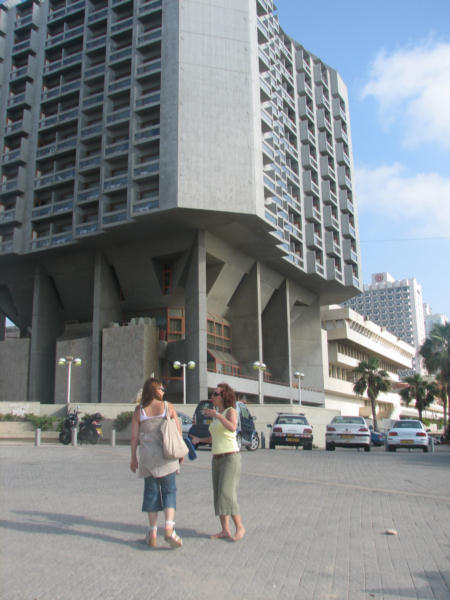 |
Street vendors. Very Tidy! |
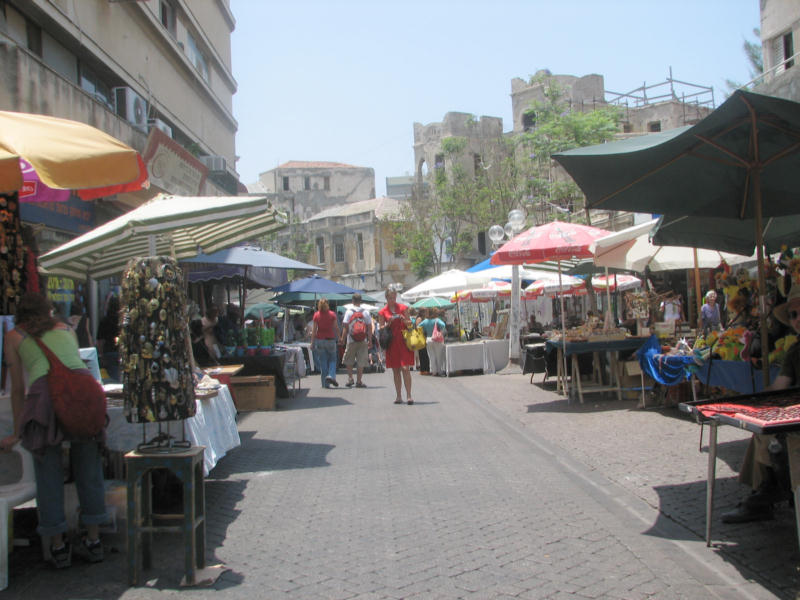 |
Noans doing what she does, when she's not shopping. |
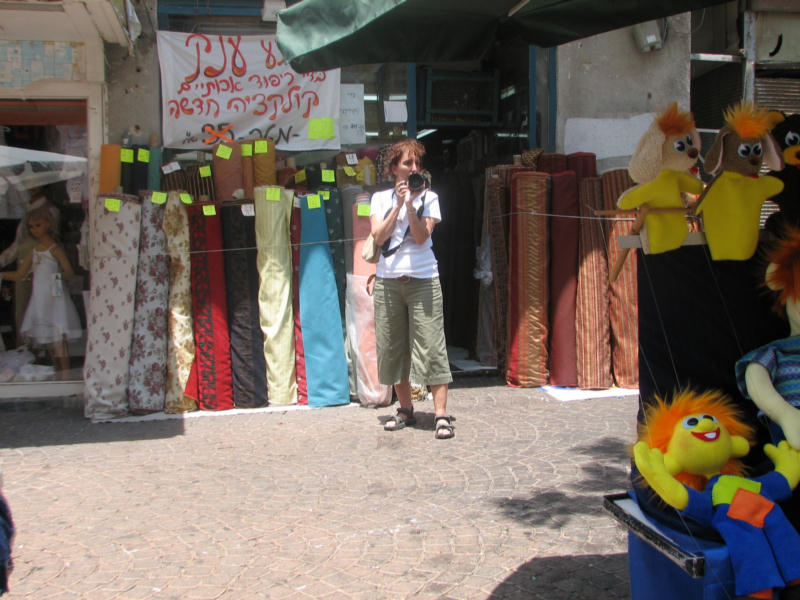 |
Budweiser, Bazooka, Coke, McDonalds, Blues Brothers, Superman ... everything Israeli. |
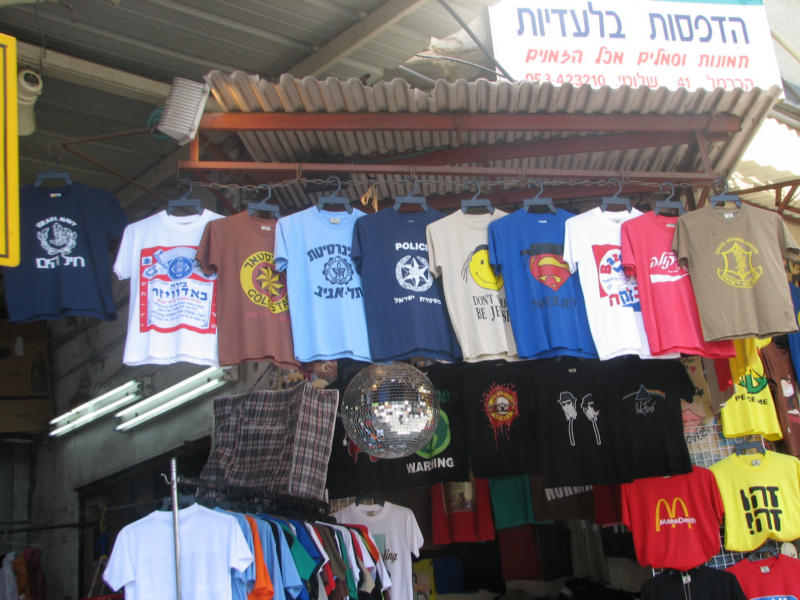 |
There's cameras everywhere!. |
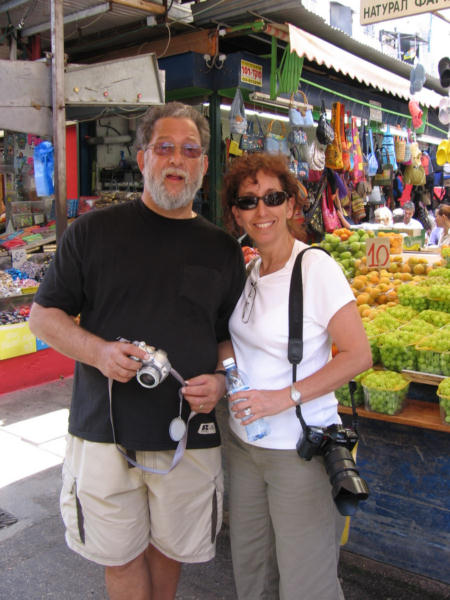 |
Serious silver shopping. |
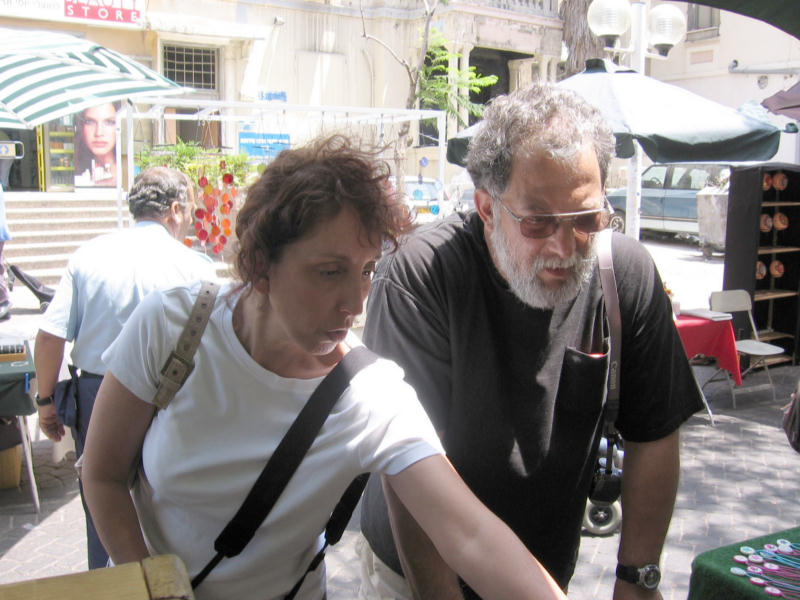 |
Ahhhh, it's jewelry. That's why. |
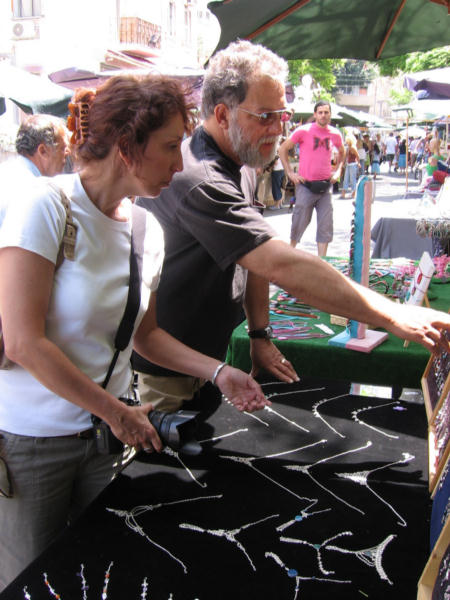 |
Awwwww, our happy little tourguide. |
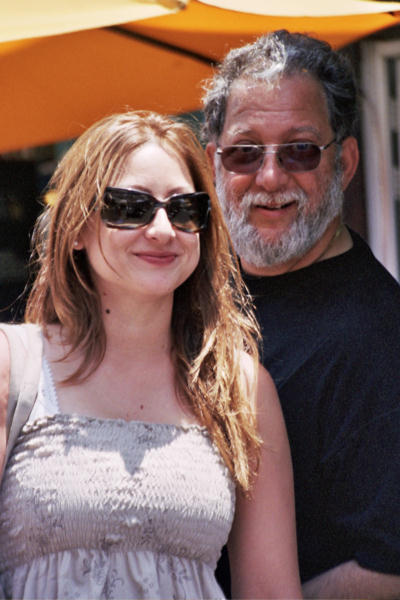 |
Now into the "other market"! |
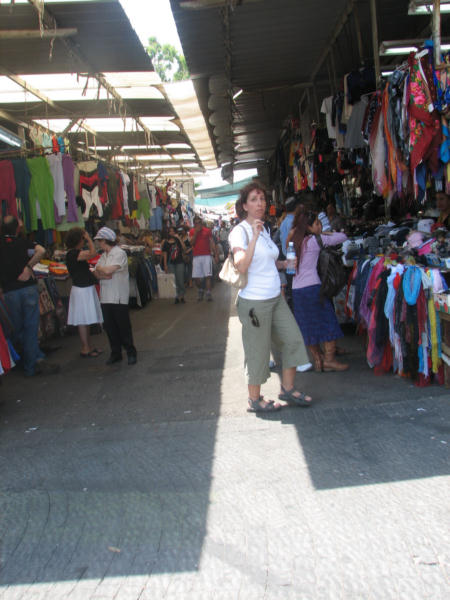 |
I wondered if it was the product, the camera or something else that "grabbed" his attention. |
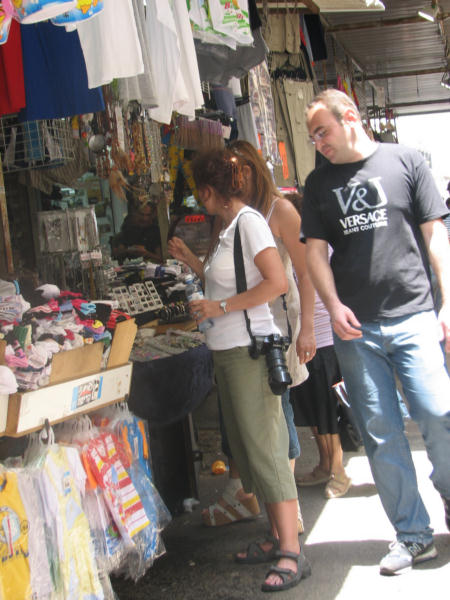 |
Monica LOVES this picture! |
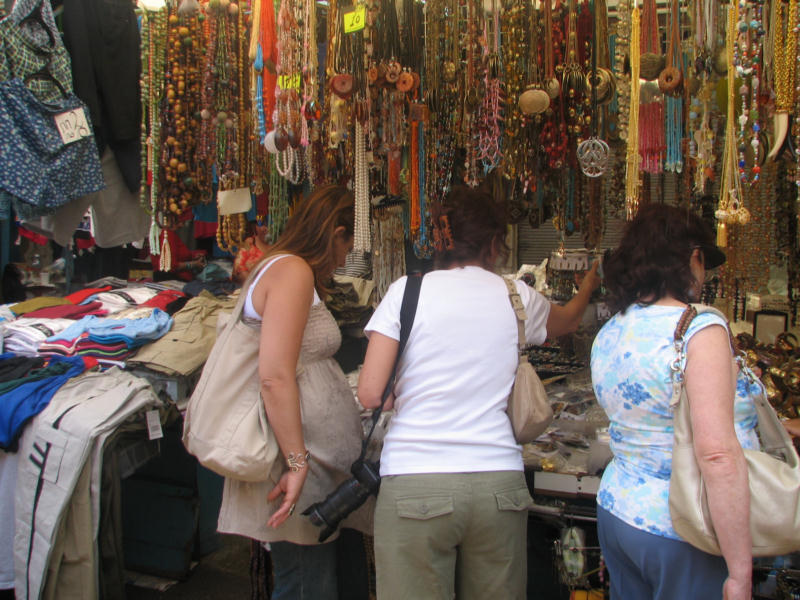 |
And she bargains for Joan. I think it was "128-Pieces For A Dollar" day. |
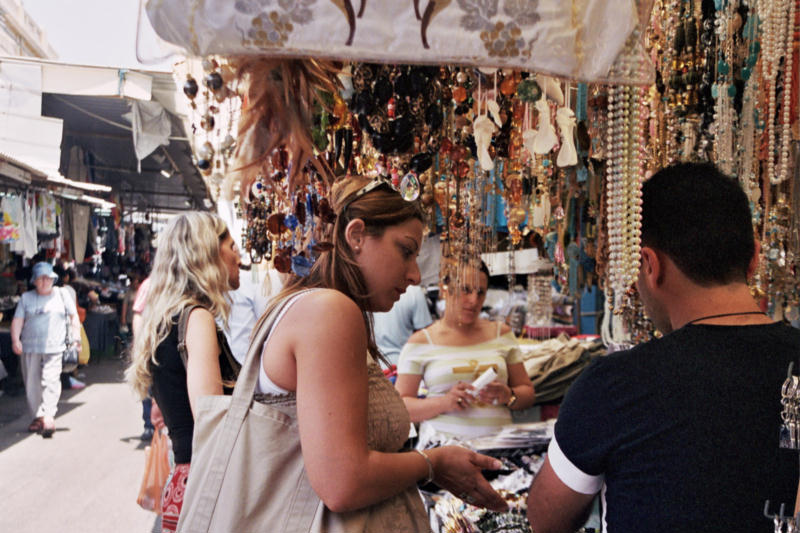 |
A One-Man-Band. He "looked" about 102-years-old. |
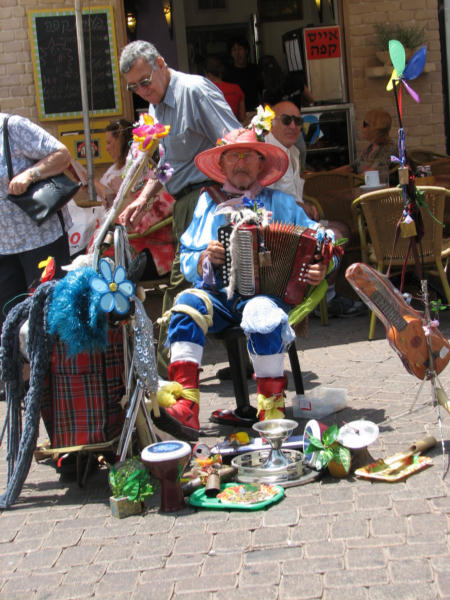 |
Top Of Page |
In Hebrew, the city's name (Beit Lehem) means "House of Bread". In Arabic, the city's name (Beit Lahm) means "House of Meat". In either case, the city is the backdrop of history's quieter religious moments: Rachael's death, the love between Ruth and Boaz, the birthplace of the shepherd-poet-king David, and of course, the pastoral birth of Jesus. Today, the locals are almost entirely Arab Christians. And, for the first time in history, the Palestinian flag flies over the city. As such, we had to change taxis in Jerusalem into one with a Palestinian owner/driver, licensed to travel between Israel and the West Bank. We also passed thru security (going and coming back), each time the driver telling the Israeli soldiers that we were "tourists". You see, WE were the "people of concern", not our Arab driver (who lived in Israeli Gilo, and proud enough of it to tell us twice). It was a trip most Israelis discouraged us from making , or upon hearing we went to Beit Lehem just shook their heads in disbelief. But, it was well worth making and we were NEVER made to feel uncomfortable. |
Immediately upon entering Manger Square Plaza, to the east you see the very out-of-place brand new building. Not sure what they did there, but inside was lovely...and they had clean restrooms. |
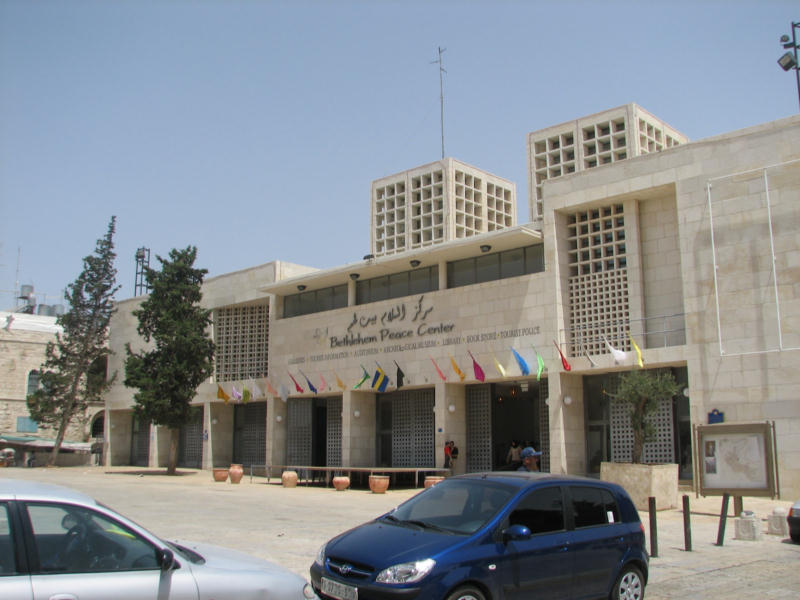 |
Looking north is the very well maintained central mosque. We have no pictures looking west, but along the western side of the plaza is a row of brand new stone buildings that serve as a shopping center, of sorts. It's where we did our souvenir buying. Unabashed Advertising: Visit Bethlehem Arts Gallery, ph.011-972-22-744-360, |
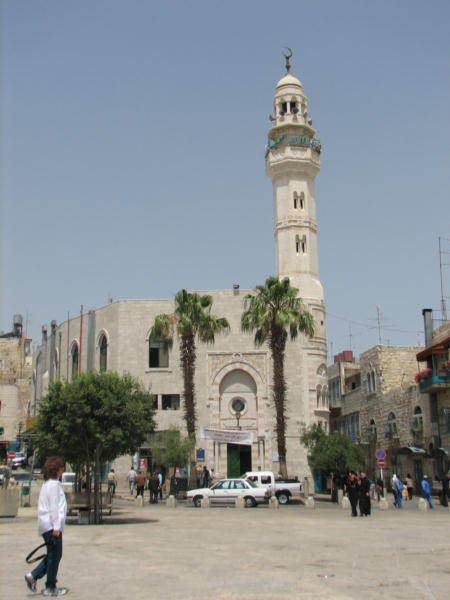 |
Looking south is the reason for being... The Church of Nativity. This is without-a-doubt, the least maintained building on the plaza. Go figure. |
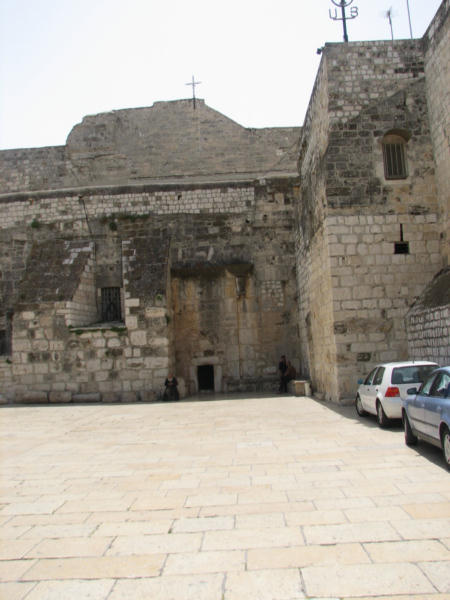 |
The entrance to the church has been "humbled". Looking closely, the large archway has been blocked-up. This forces visitors to bow (crawl?) upon entering. Good for forcing calvarymen to dismount first, too. |
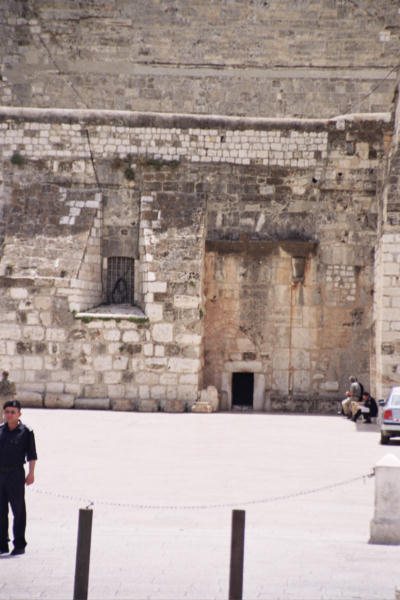 |
Once inside it's mostly dark (and grim), with spotty patches of light from bare 60-Watt lamps. To Joan's left are trap doors in the floor... |
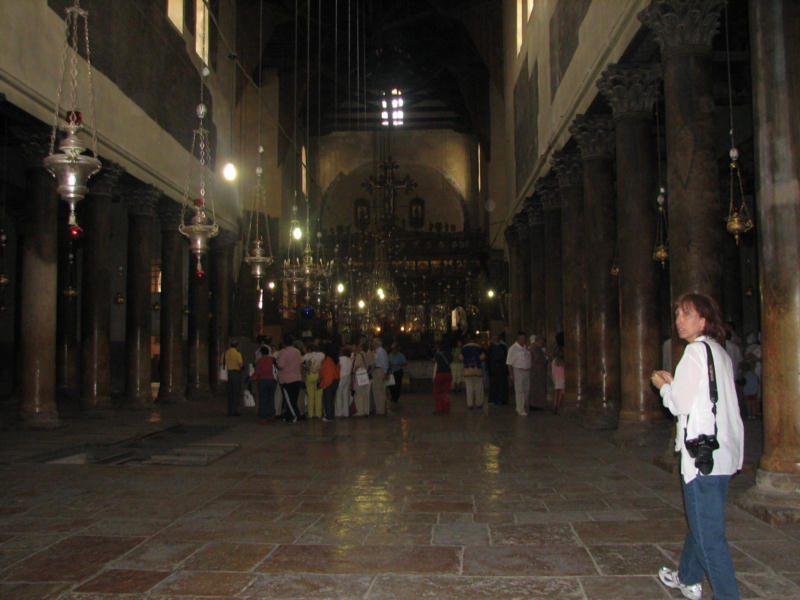 |
[Masquerading as a fortress, this basilica is the oldest continuously used church in the world. Built by Queen Helena between 326-339, it was partially destroyed by fires and rebuilt in 525 and again in 614. By the 15th-century it had become undeniably decrepit.] |
...which display the original mosaic floor. |
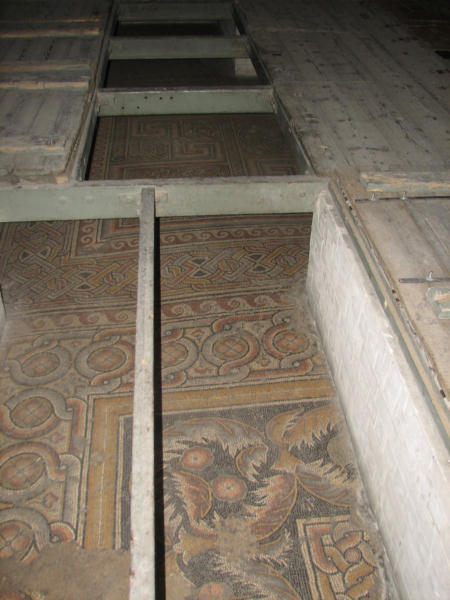 |
[Fragments of mosaic floors are almost all that remains from Helena's church.] |
Hand painted columns have survived the years and fires, only just almost. |
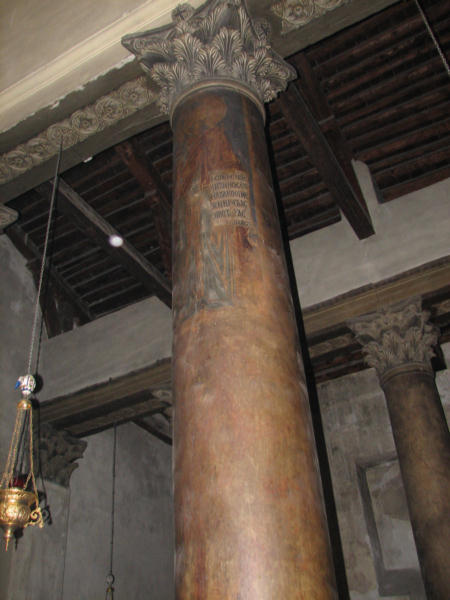 |
[The reddish limestone columns date from Justinian's reconstruction (525). 30 of the 44 columns carry Crusader paintings of saints and the Virgin and Child.] |
The Roman Catholic altar sits directly above the Grotto of Nativity and the Manger Altar. |
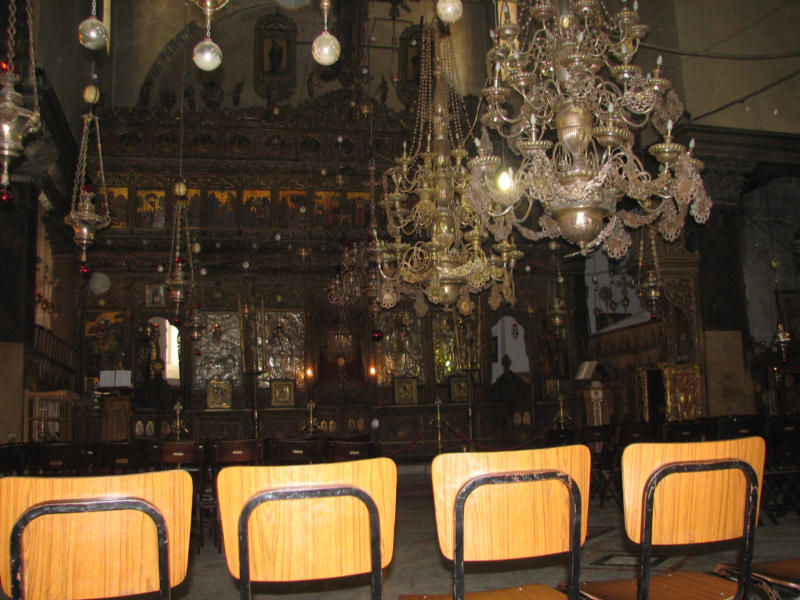 |
[In the 1840's the church was restored and in 1852 shared custody of the church was granted to the Greek Orthodox, Roman Catholic and Armenian churches. The Greeks care for the grotto, the Roman Catholics care for the Nave and the Armenians, well, they got a little altar off to the left, and little else.] |
Two Palestinian Police Officers. They were very polite to us during our visit. |
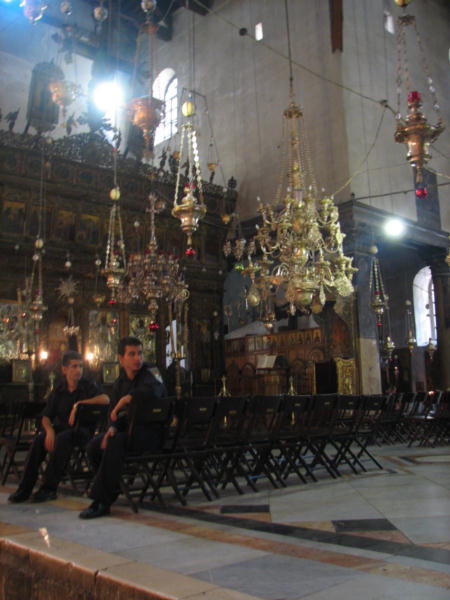 |
An Armenian mass was being conducted "off on the side". There were no chairs for people to participate in the mass... |
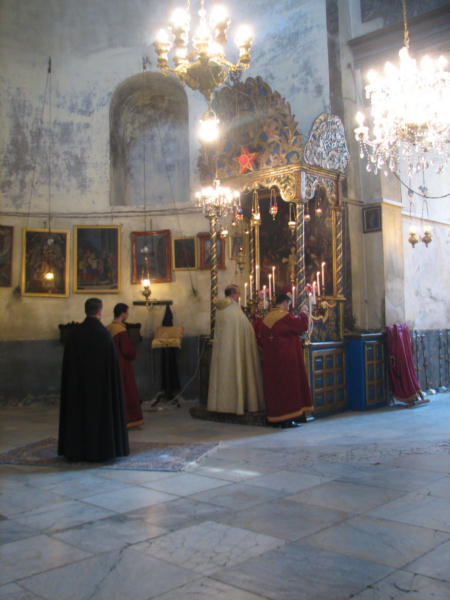 |
...but they carried on, just the same. Even delivering what seemed to be a sermon (to nobody). |
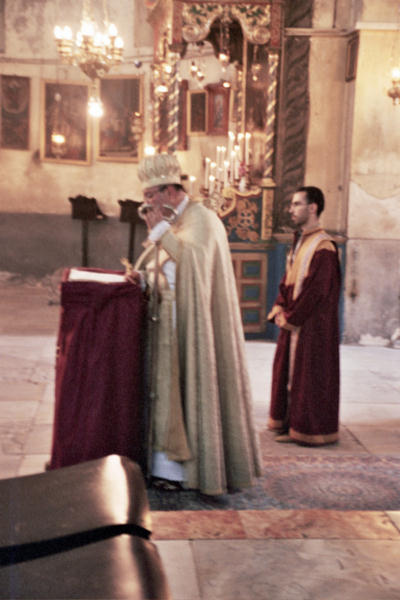 |
I have NO idea what these are... |
 |
... but they were beautiful. |
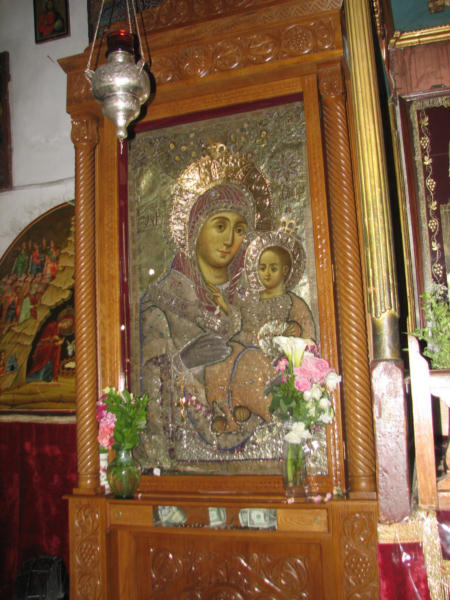 |
Seemed everything that hung from the ceiling had hanging from it a red Christmas tree ornament. |
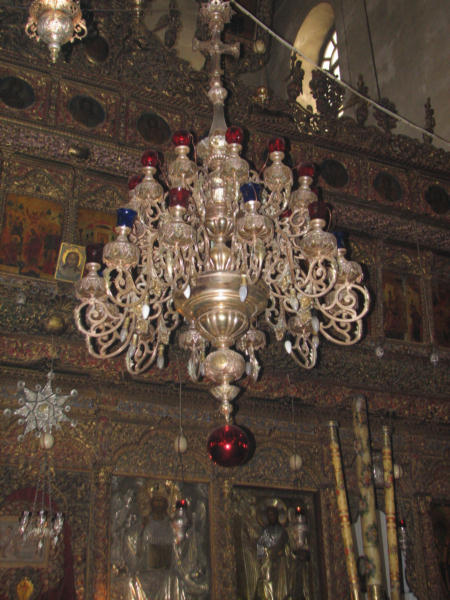 |
Below the Roman Catholic alter, in the grotto. Not the Vatican Collection, but along the same lines. |
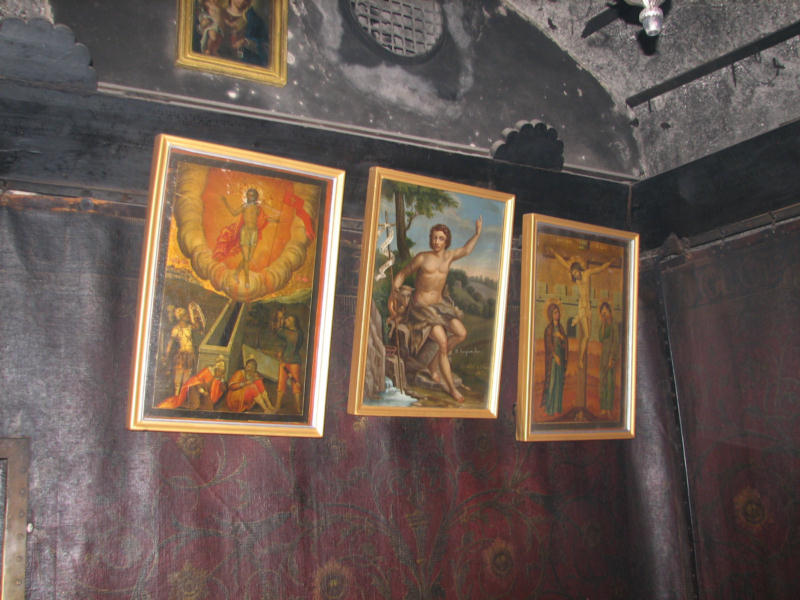 |
The Grotto of Nativity. |
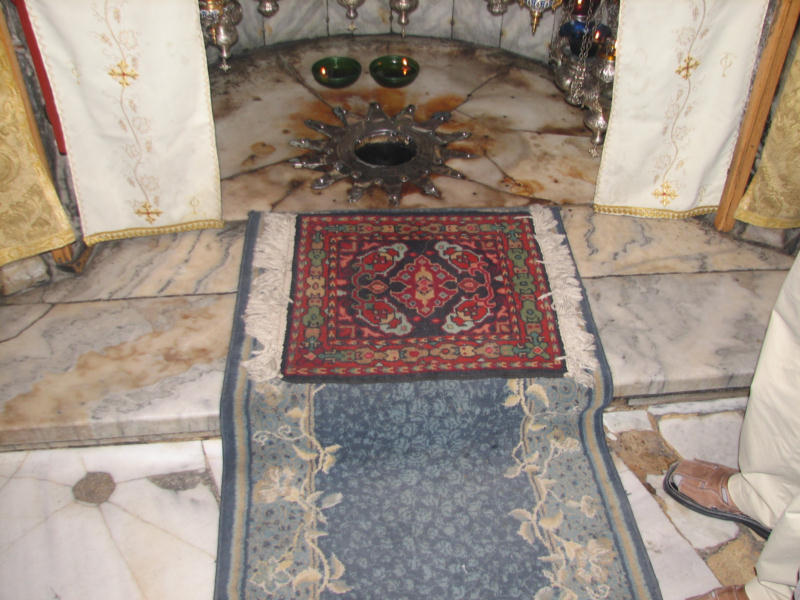 |
[A silver star is set in the floor over the spot where Jesus is said to have been born.] |
A bit of Ah-Ha. |
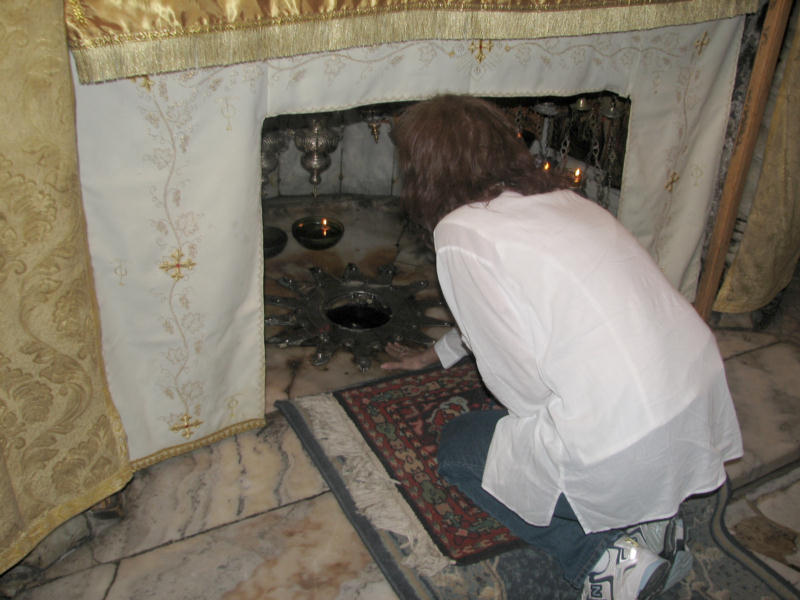 |
And, 6-feet from the Grotto of Nativity, The Alter of the Adoration of the Magi (Manger Alter). |
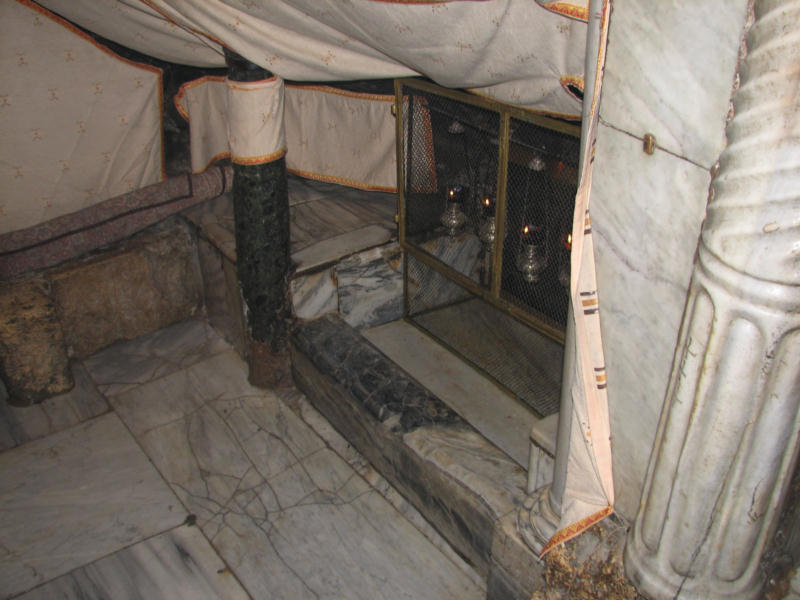 |
Once again outside and what we thought made for an unusual picture: a Muslim Arab coming out of the church. |
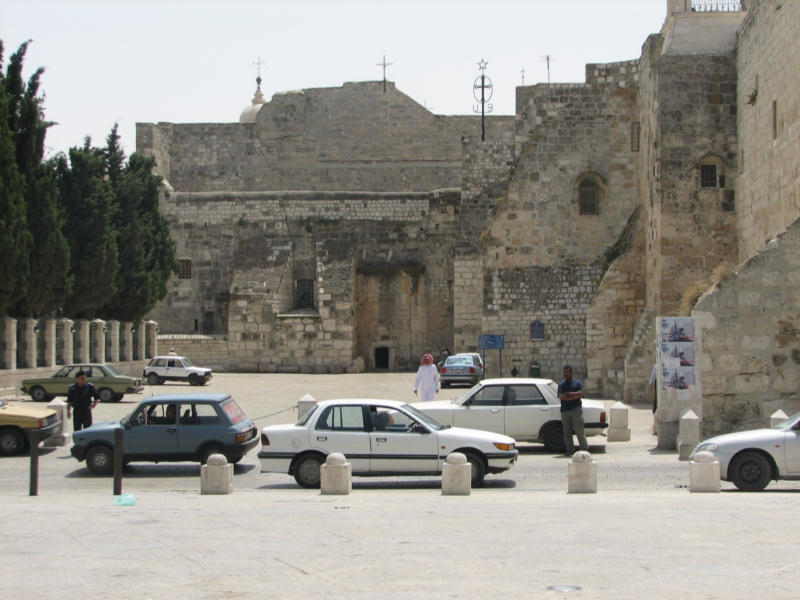 |
Headed back to the taxi with gifts in hand. |
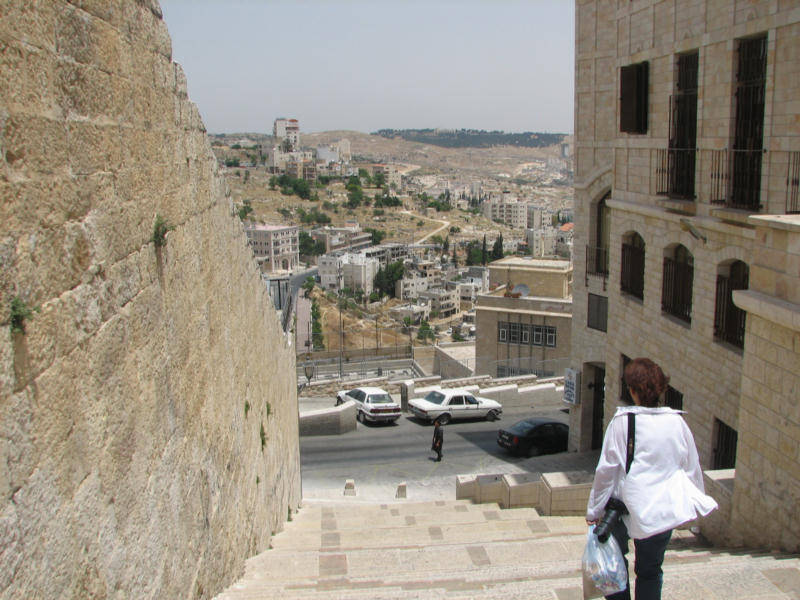 |
Top Of Page |
While Joan and Rick headed to Bethlehem, we left Natalie and Monica in Jerusalem and in the hands of our taxi driver, Yossef Swed. call: 011-52-251-1099 for day rates (and tell him we sent you) |
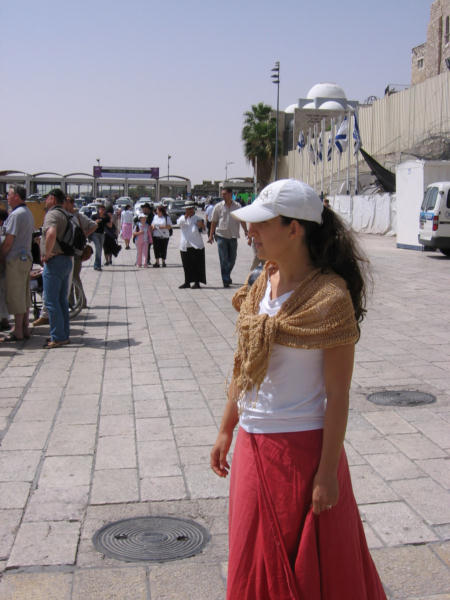 |
They headed for Ha'Kotel for... |
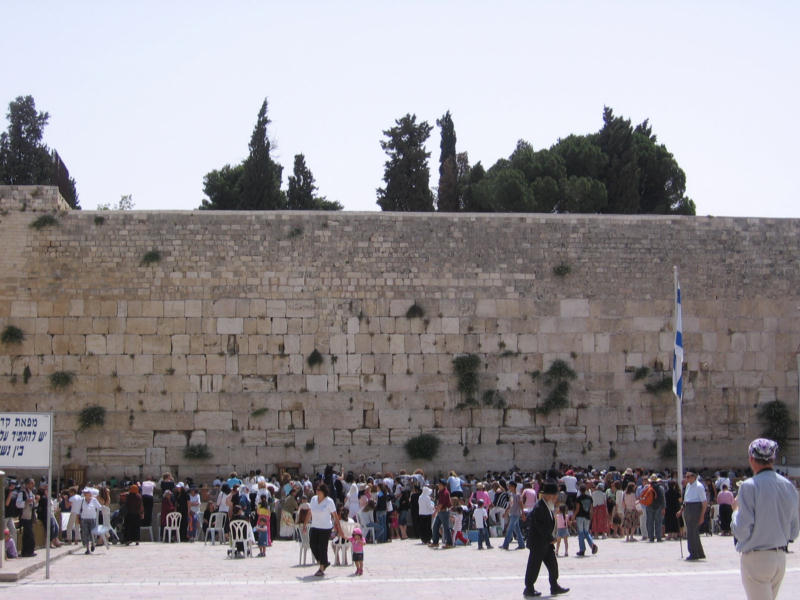 |
...some pictures of each other... |
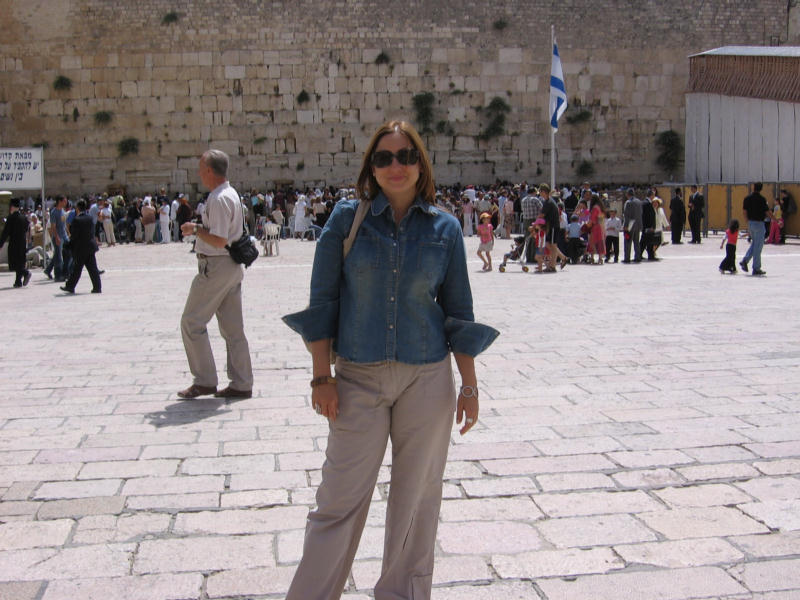 |
...some pictures together... |
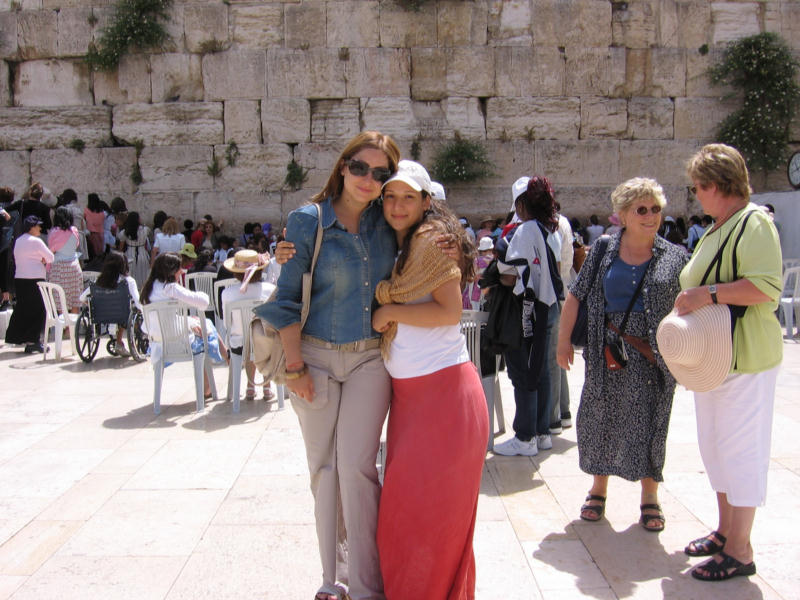 |
...some of others... |
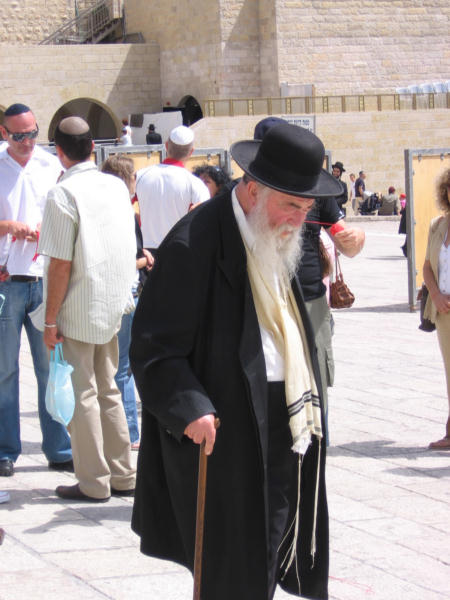 |
...of where Rick had been blessed just a couple days before... |
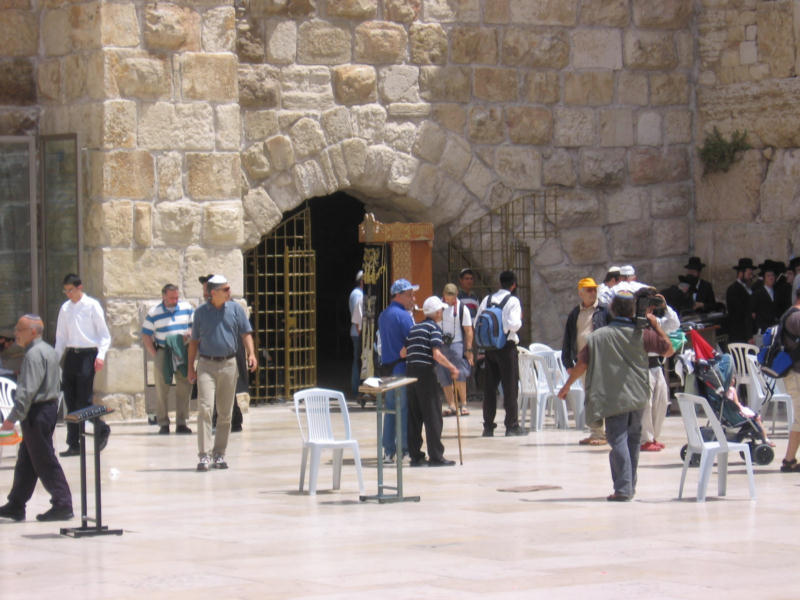 |
...another Bar Mitzvah... |
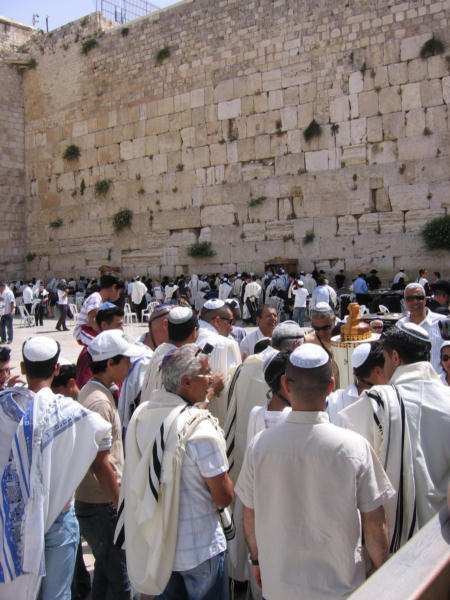 |
...and for what people go there for in the first place. |
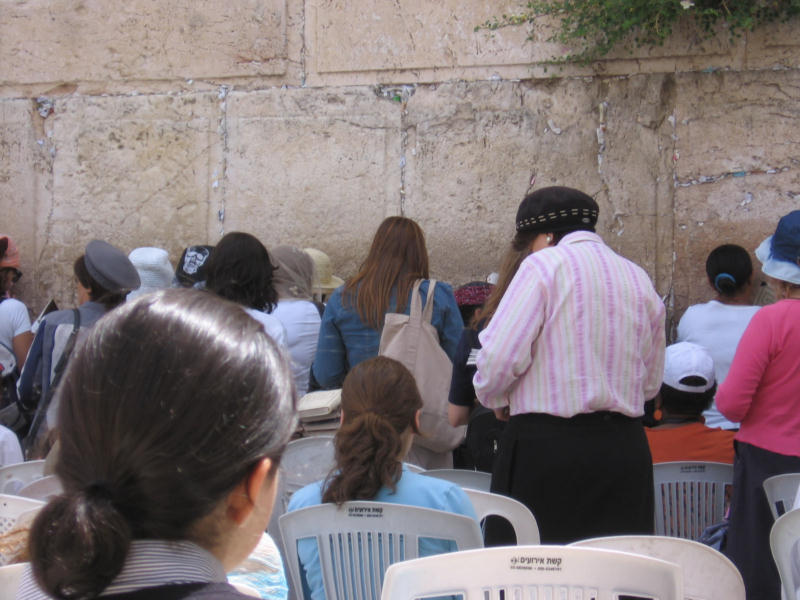 |
In addition to pictures... |
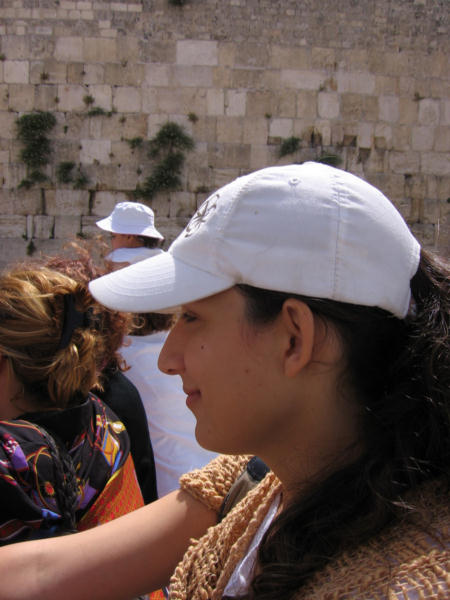 |
...and more pictures. |
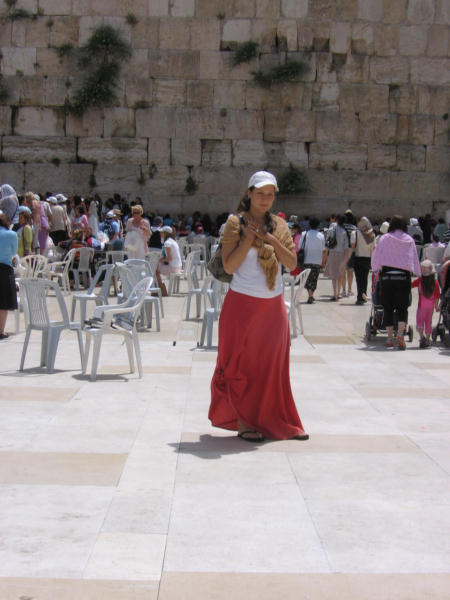 |
Then Yossef took them to the park... |
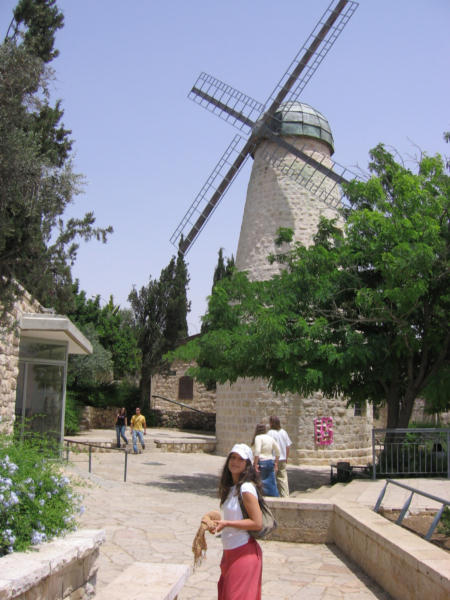 |
[In 1860 Sir Moses Montefiore build the first new homes outside of the Old City. Because it was his intention to make the "New City" self-sufficient, he also built a windmill to grind flour. Unfortunately, there was/is rarely enough wind to turn the sails.] |
..and they took some pictures... |
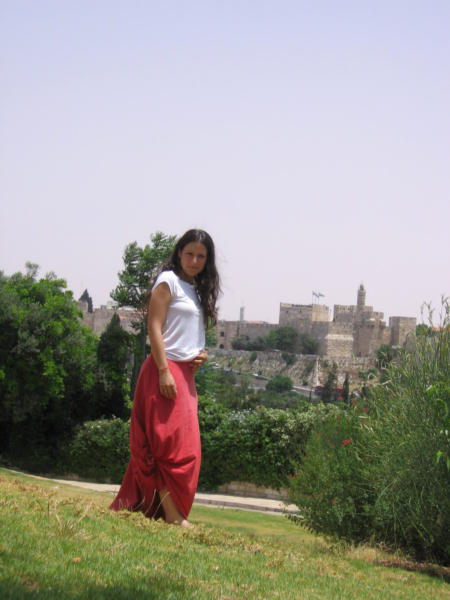 |
[The Old City and Tower of David in the background.] |
...of each other... |
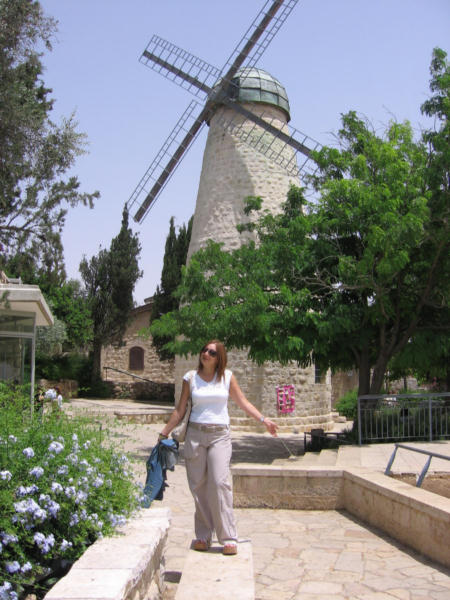 |
...napping... |
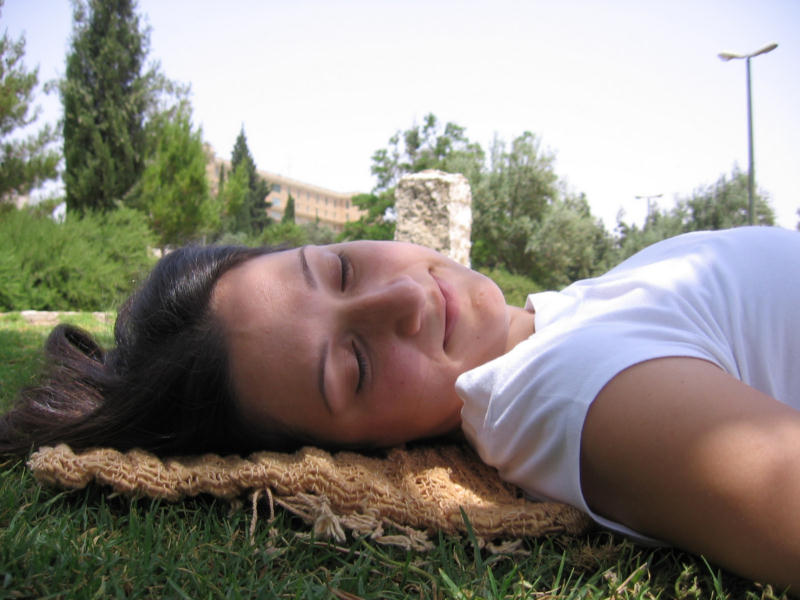 |
...pretending to nap... |
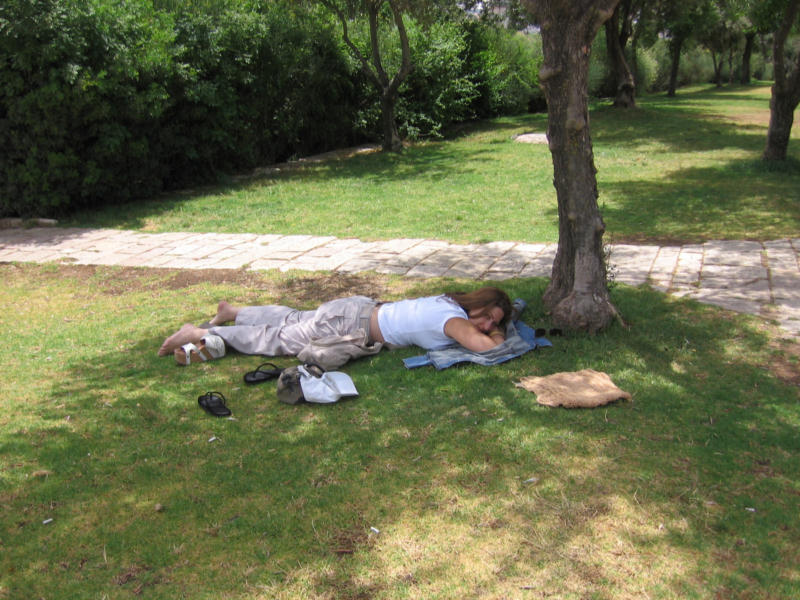 |
...and playing with the ants |
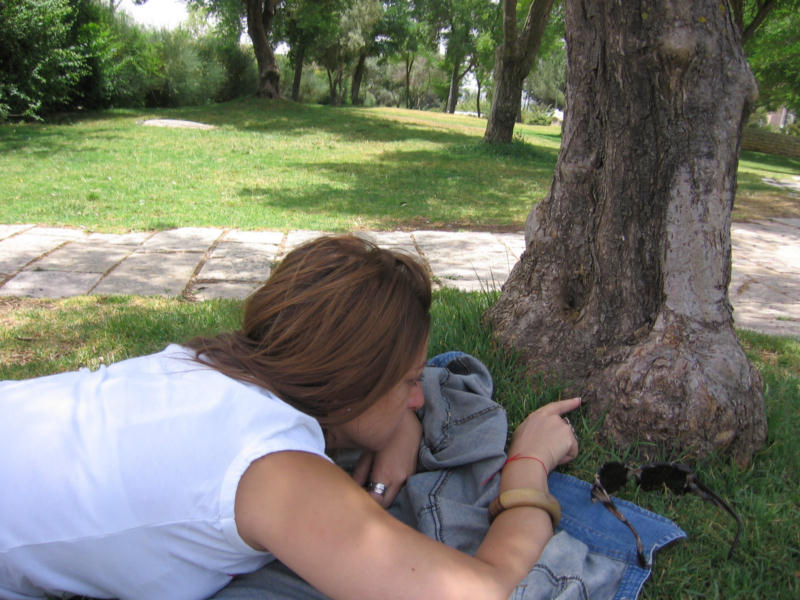 |
Top Of Page |
Rising on the eastern side of Jerusalem, The Mount of Olives offers views of the Dome of the Rock and the Old City. Today best known for Jesus's Agony and betrayal in the Garden of Gethsemane, this has always been a holy place to Jerusalemites. In 2400-BCE Jebusites dug tombs on its slopes. The Valley of Jehoshaphat (aka The Kidron Valley), where it is said mankind will be resurrected on Judgement Day, lies between the Old City Walls and the Mount of Olives. |
Entrance to the Tomb of the Virgin Mary (circa 12th century) |
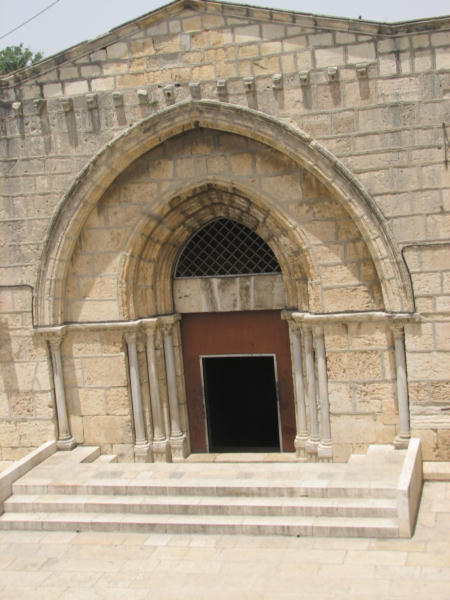 |
Steps lead down to Mary's Tomb |
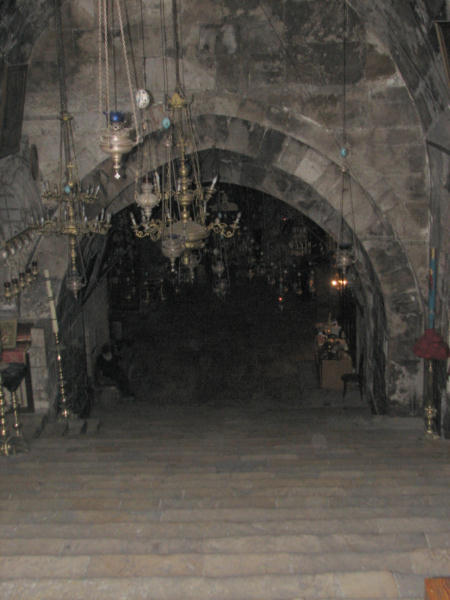 |
[47 steps lead down to the tomb. Half-way down, in side niches, are the tombs of Saint Anne and Saint Joachim (Mary's parents).] |
A mihrab installed after Saladin's conquest (1187). |
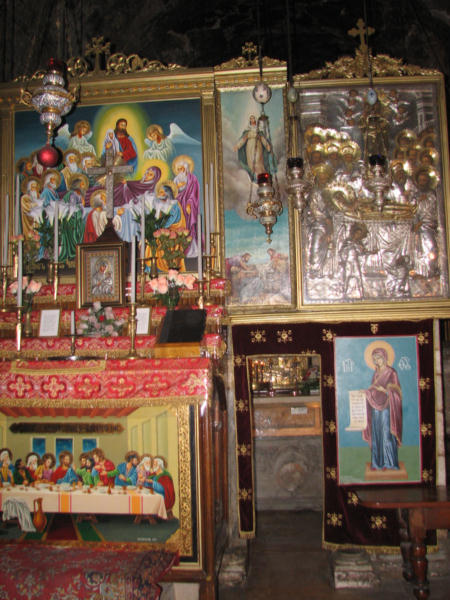 |
[Because Muhammad saw a light over the tomb of "his sister Mary" during his Night Journey to Jerusalem, the tomb is also a holy Muslim site. The mihrab was erected so the Muslim who come here to pray know which direction faces Mecca.] |
The Tomb of Mary |
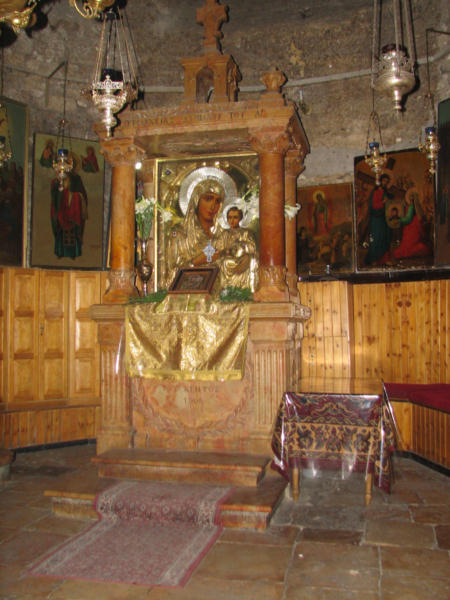 |
Back outside... |
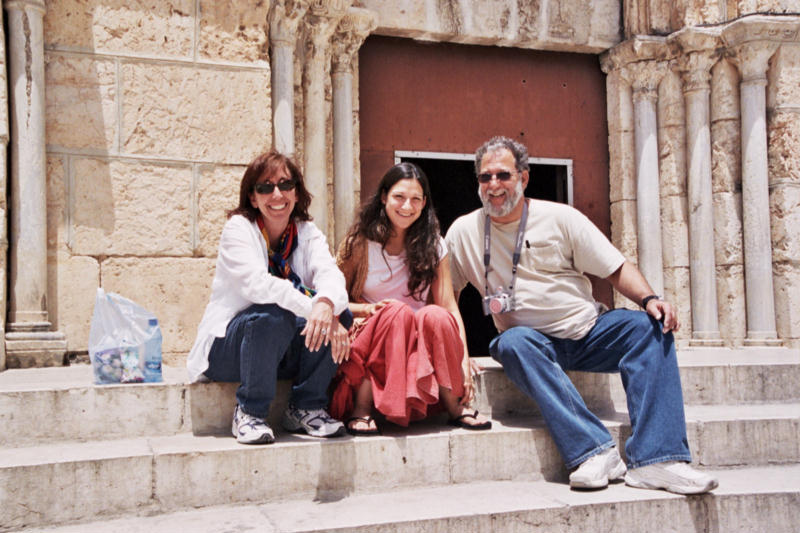 |
...it's picture time. |
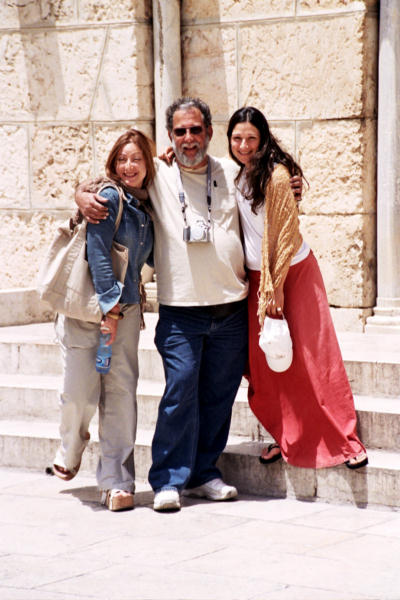 |
After a short (but harrowing) ride to the top of the Mount of Olives, we look west out across the Jewish Cemeteries to the Old City. We're now standing under that "group of trees to the left" mentioned earlier from within the Old City). |
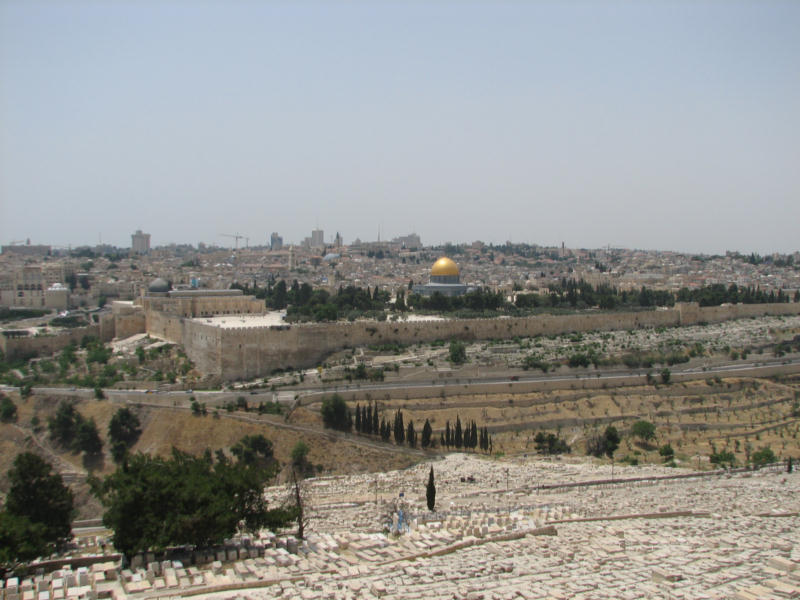 |
[The road we drove had also been taken by Jesus as he rode from Bethphage to Jerusalem on Palm Sunday. Today, above the grotto at Bethphage, The Church Of The Paternoster has been built to commemorate where Jesus revealed the "inscrutable mysteries" to his disciples and the first recitation of the Pater Noster (the Lord's Prayer)] |
Looking north towards the Russina Orthodox Church, Gethsemane, The Church of All Nations and the Kidron Valley. |
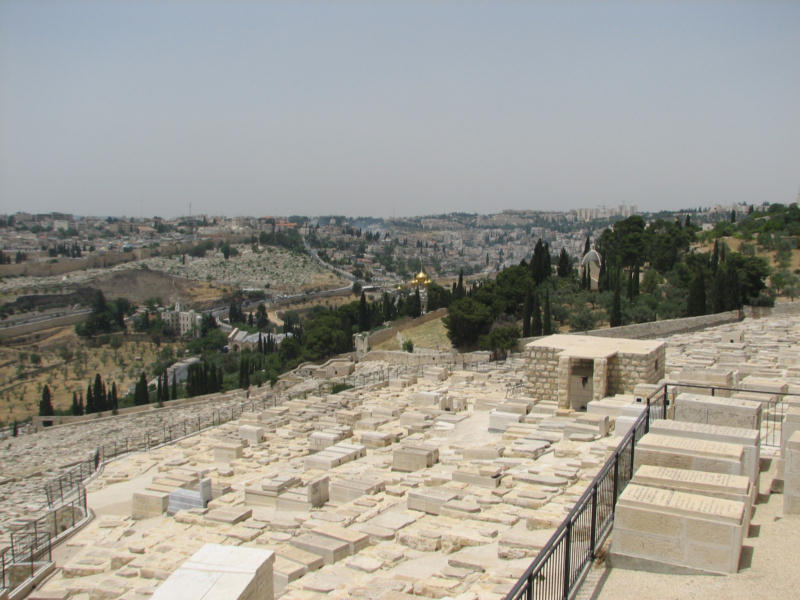 |
Church of St Mary Magdalene. |
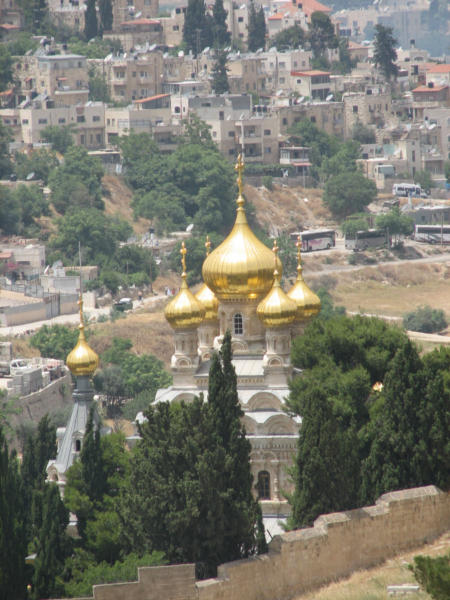 |
[This Russian Orthodox Church, with seven typically Muscovite gilded onion domes, was built by Tsar Alexander III in 1885 in memory of his mother, whose patron saint was Mary Magdalene. In 1920, after her murder in the Russian Revolution, the remains of the Grand Duchess Elizabeth Feodorovna were brought here for burial.] |
The immense Jewish Graveyard, the largest Jewish cemetery in the world. |
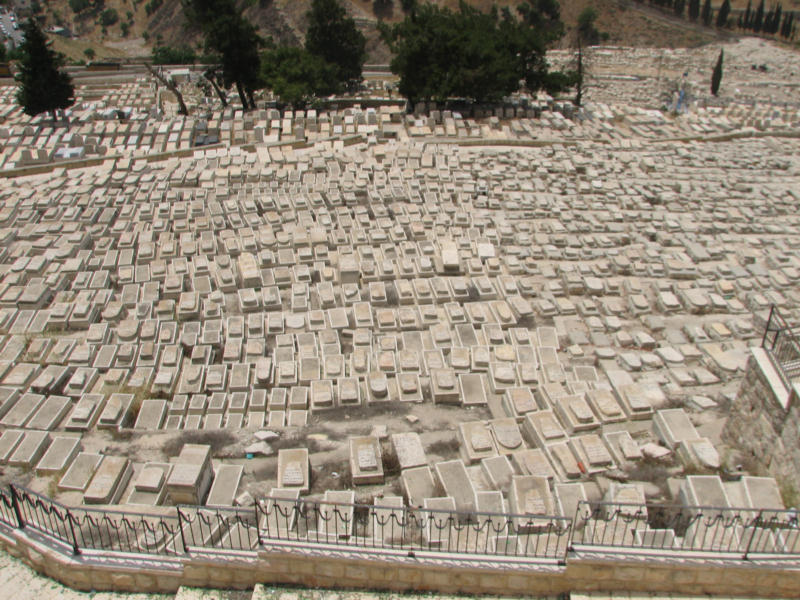 |
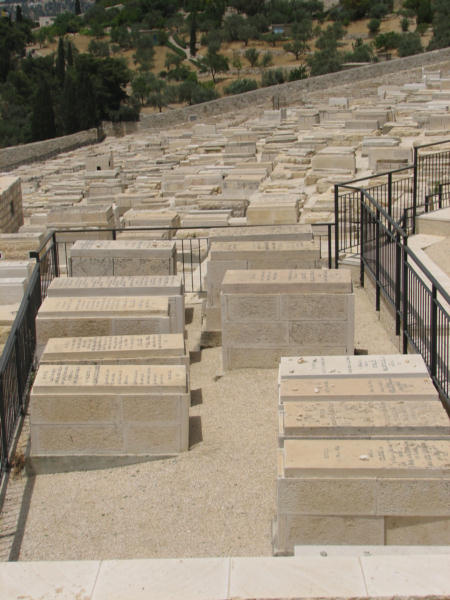 |
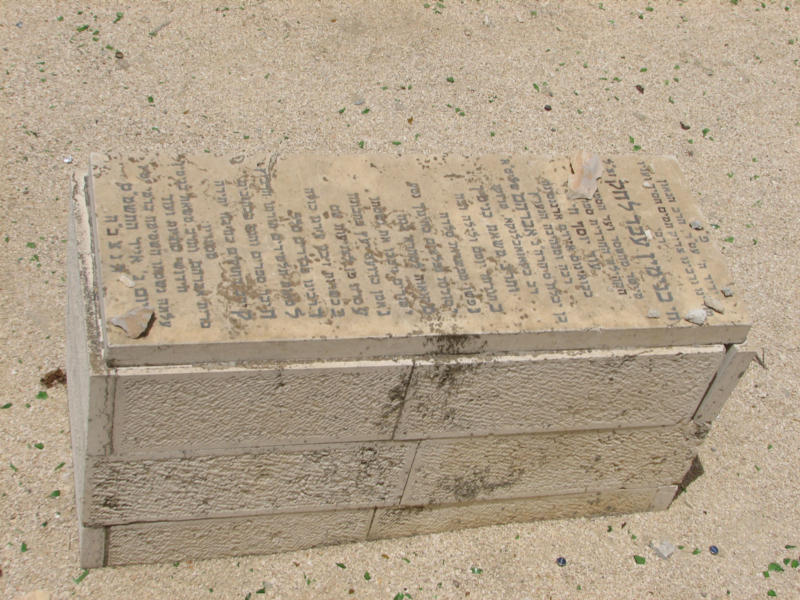 |
Monica, Yossef the driver and Natalie. |
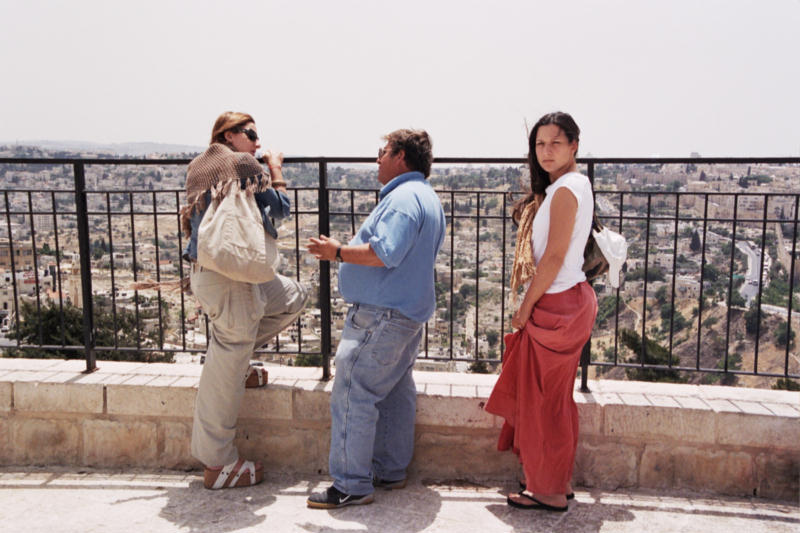 |
Yossef tells us he has some "cakes" for us in his trunk. We rather expected icing and all. They were "crackers". But welcome crackers, at that. We were staving and ate all of his little cakes. |
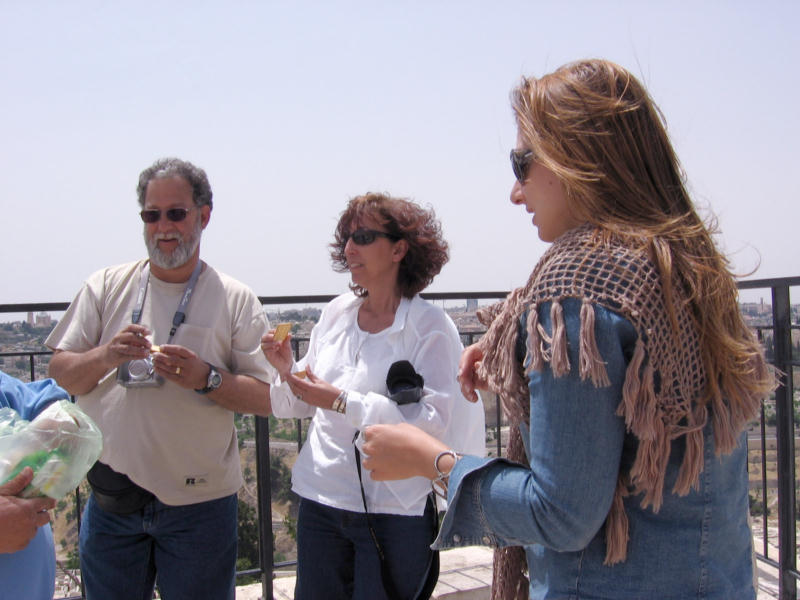 |
It was rather windy. |
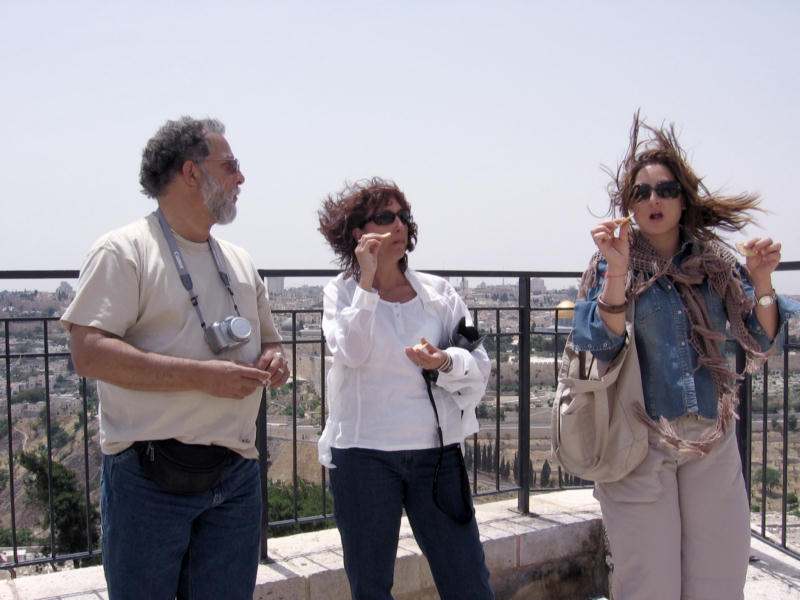 |
Eating cakes and taking it all in. Ah-Ha. |
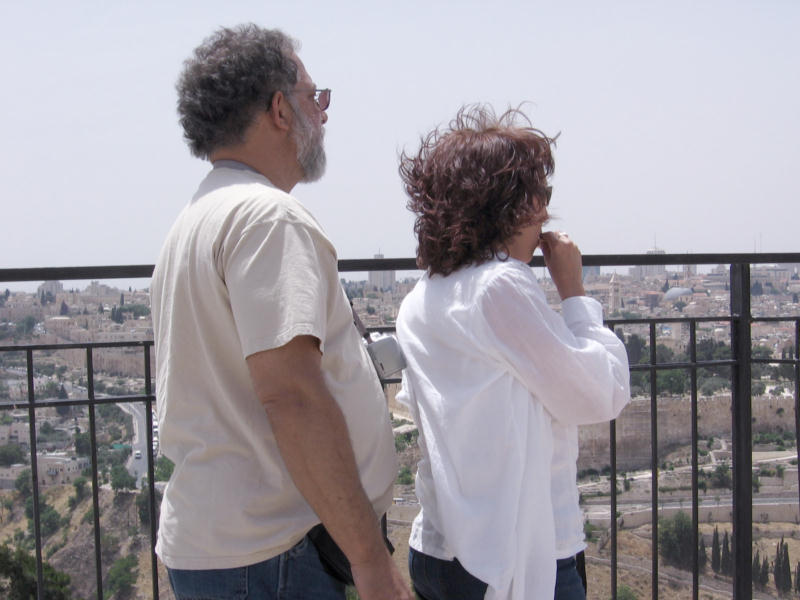 |
Let her eat cakes, too. |
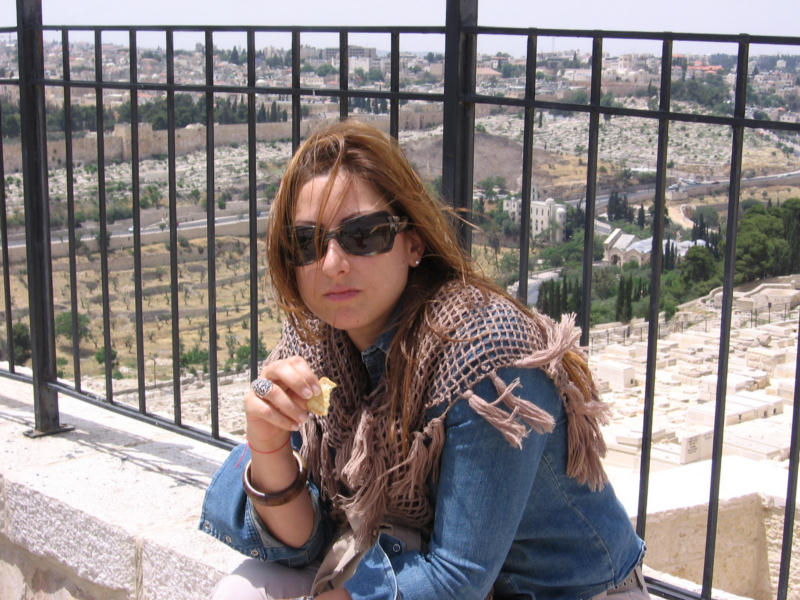 |
Garden of Gethsemane and Church of All Nations. |
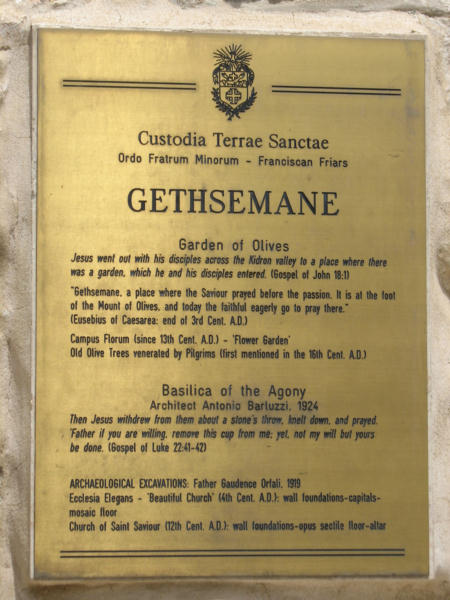 |
[The garden is where Jesus spent his last night in prayer and then was betrayed by Judas.] |
Centuries-old olive trees |
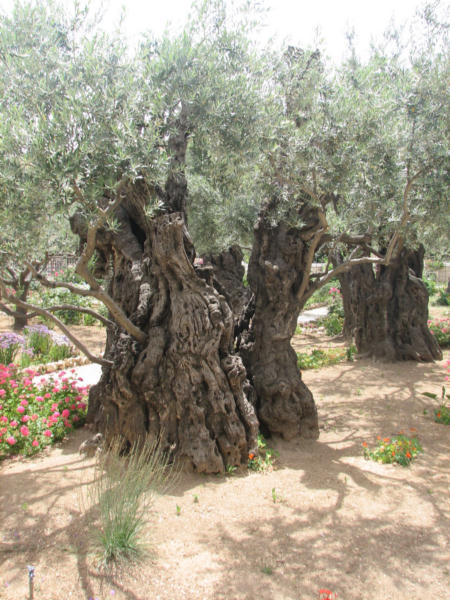 |
A wider view. (more later) |
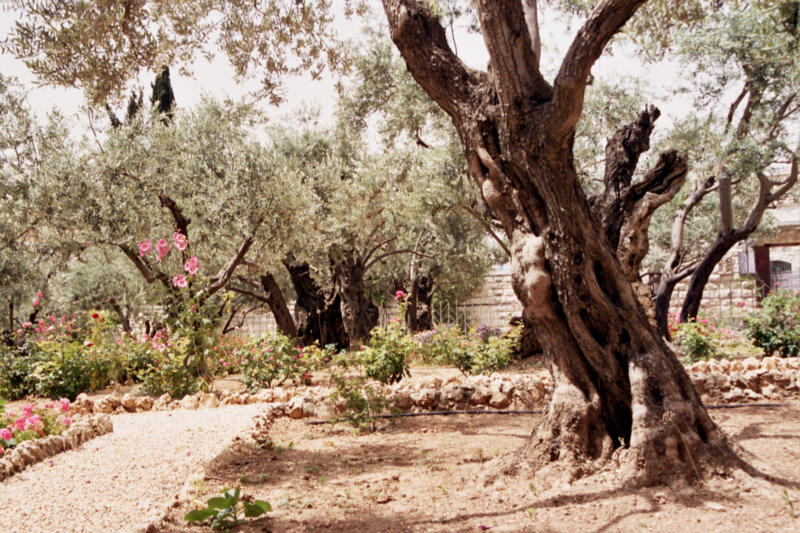 |
The Church of All Nations. |
 |
[Although the site has been venerated since the 4th century (church destroyed in an earthquake), the present building was built over a Crusaders church (consecrated in 1170) with donations from 12 nations in 1924. Designed by Antonio Barluzzi, mosaics decorate all 12 domes, one for each contributing nation.] |
The church faces west across the Kidron Valley towards the Old City and the bricked-up Golden Gate. |
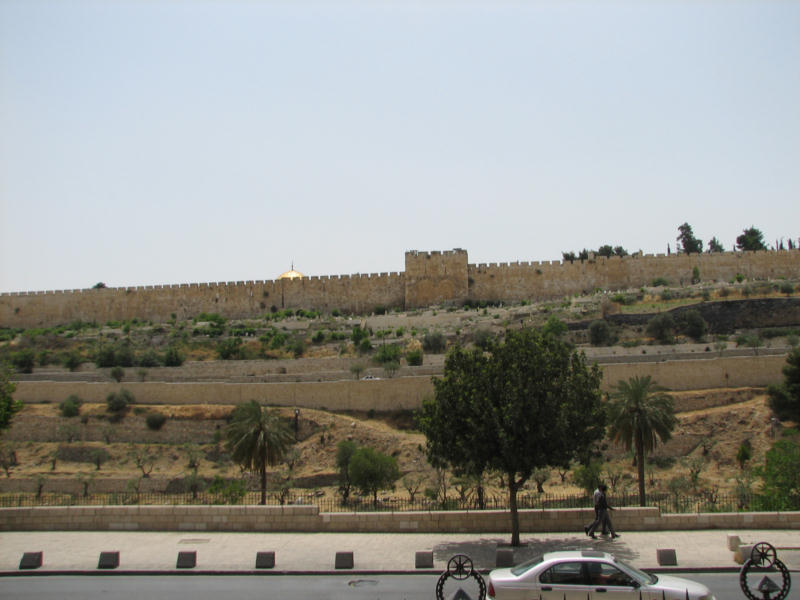 |
[Sealed since the 1600s, Golden Gate is thought to lie over the Closed Gate of Solomon's Temple, the entrance through which the Messiah will purportedly pass.] |
A magnificent gold and red facade portraying Jesus bringing peace to all nations. Inside, mosaics and sculptures depict Jesus' last days, including the proverbial kiss of death. |
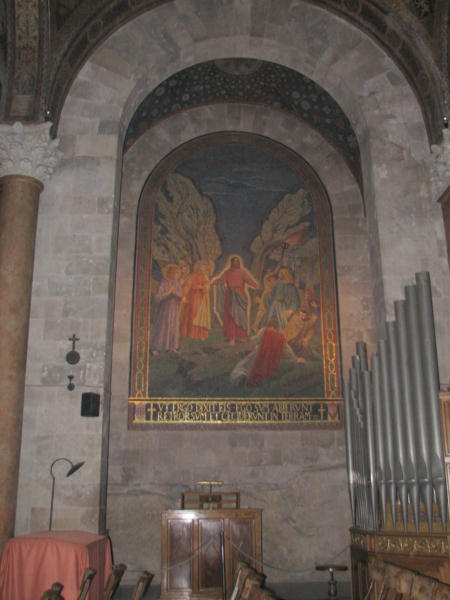 |
The Rock of Agony. |
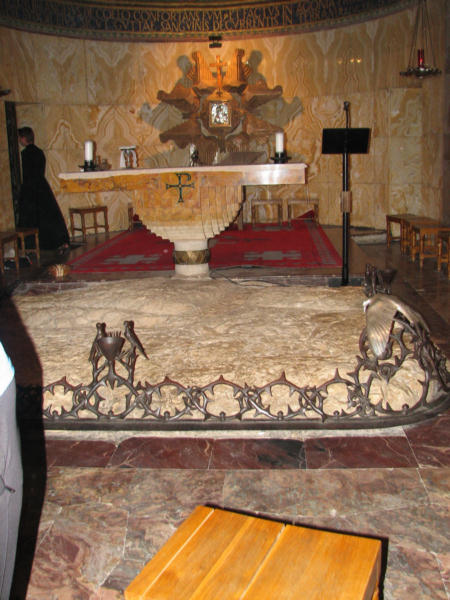 |
[Built over the rock on which it is believed Jesus prayed the night before he was arrested.] |
Back through the garden. New growth on ancient trees. |
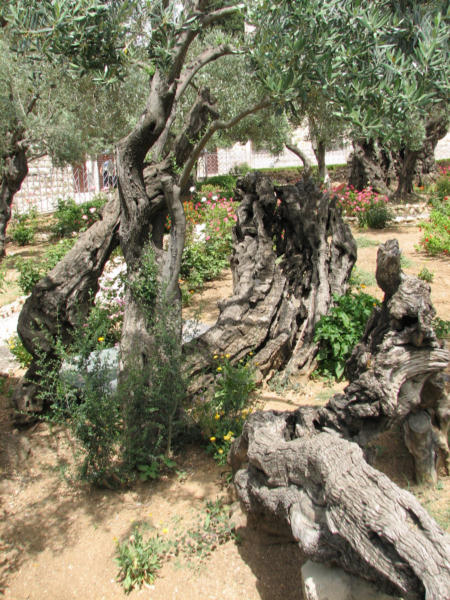 |
We stop for a photo. Note: The photographer who volunteered to take this shot was none other than the Italian gardener who has taken care of the garden for the past 12 years. He asked Rick if he could take a picture of "your family" on our way to the Church of All Nations and Rick declined. On our way back from the church, he asked again. Rick accepted this time, since he had been so nice to show us his olive trees. |
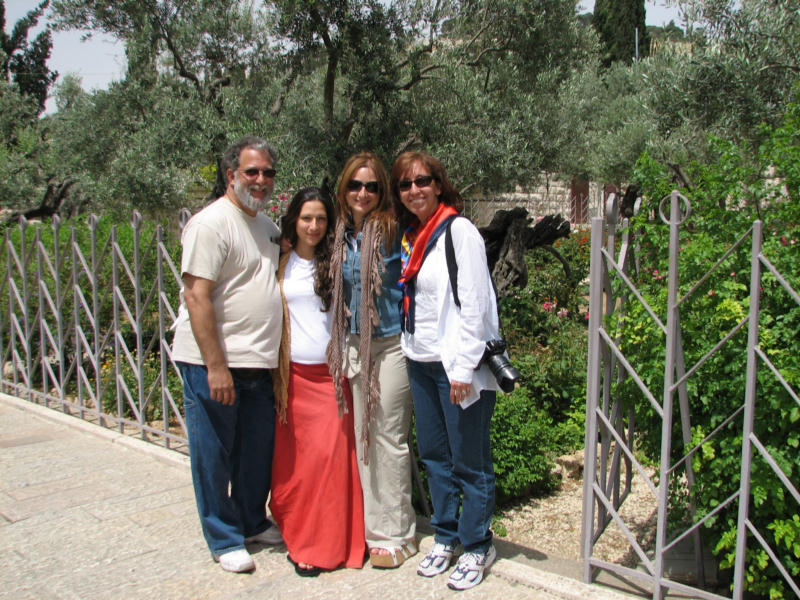 |
Then he asked if we would like a picture of him too. Rick has such a soft spot (and it was a digital camera so there would be no film wasted.) Note: Turns-out the gardener had actually been quite motivated. You see, while this picture was being taken, he took liberties with Natalie's, er, backside. (Note her elbow and general look of disapproval.) This man will forever be known (in my family) as: Jesus' Groping Gardener of Gethsemane, Giuseppe. |
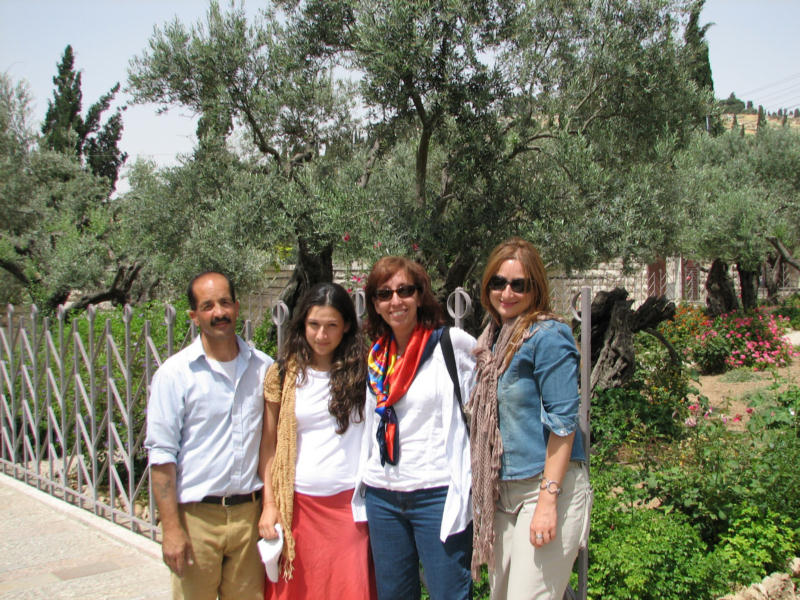 |
"Taxi Driver For Tourists, Yossef"... getting some rest before we head back for Tel Aviv (cross-country in 45-minutes). |
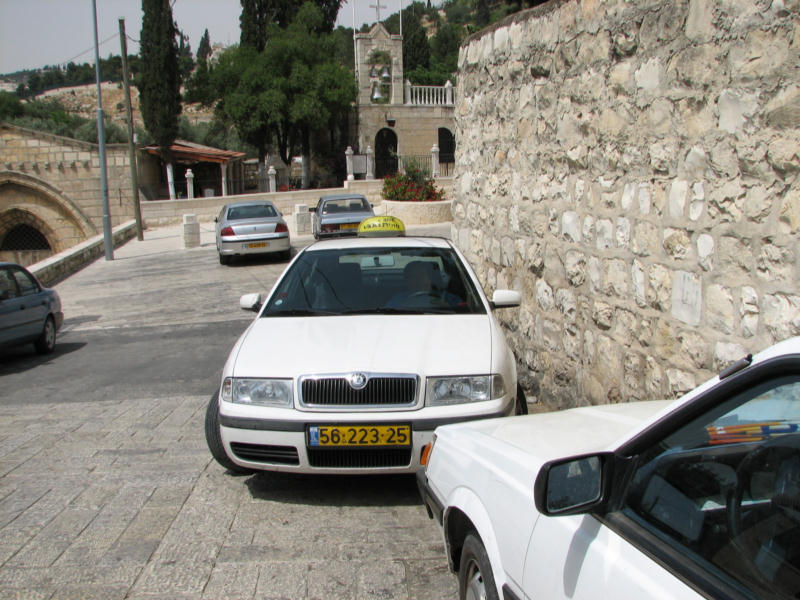 |
After a brief meal stop at Latourn (half-way home, pre-1967 border, winery, silent monks, tank museum), we stop to play. |
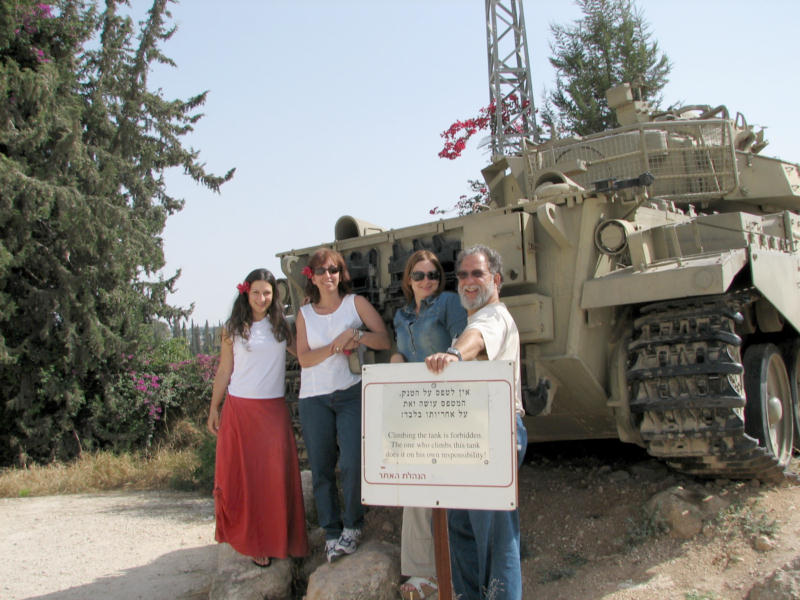 |
Of course we did so on our "own responsibility"... |
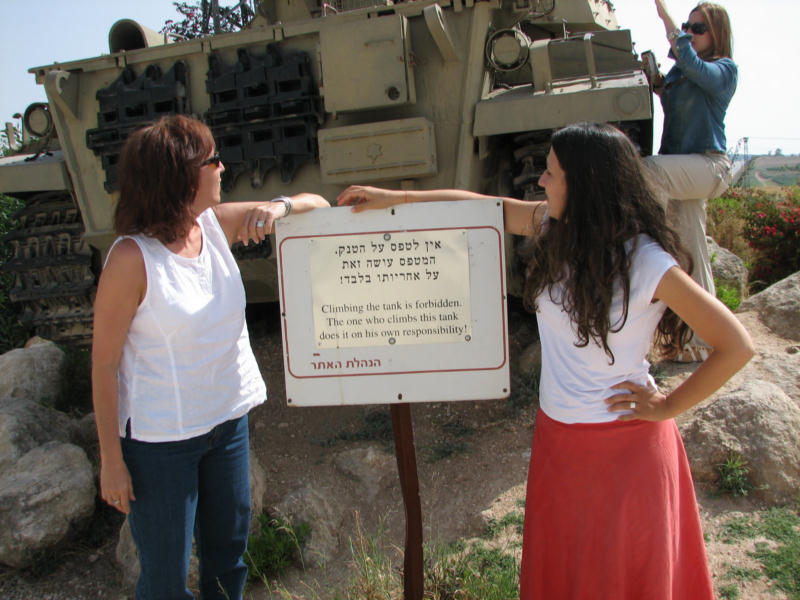 |
...and nothing "bad" happened. |
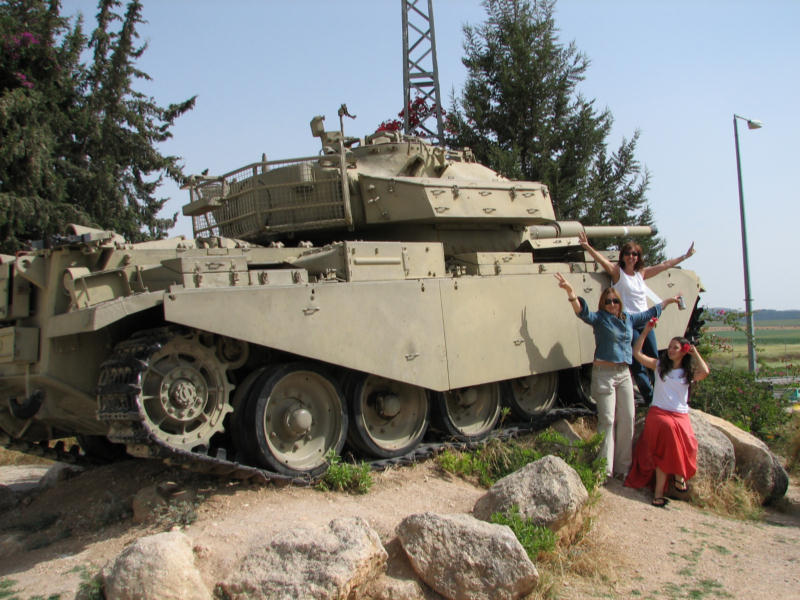 |
Top Of Page |
At Rina's, with the Family, for Shabbat Dinner. |
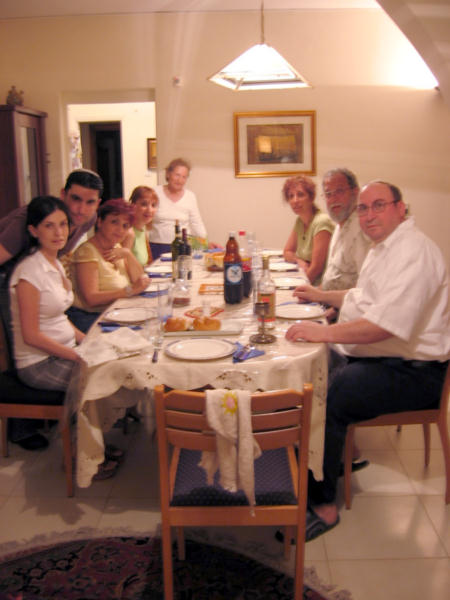 |
Dinner begins with blessings. |
 |
It may be blurry, but some people must have talked to each other beforehand to discuss wardrobe. |
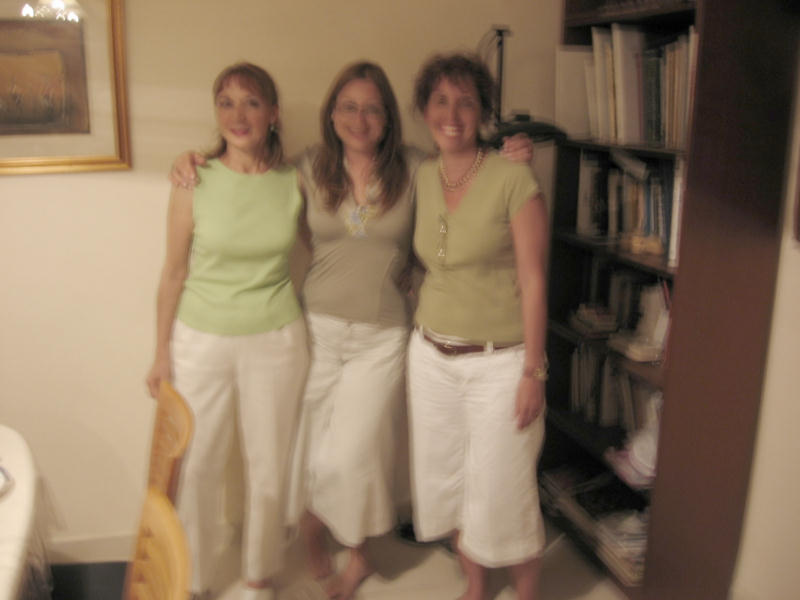 |
The Persian women. Including the BEST PERSIAN COOK EVER! |
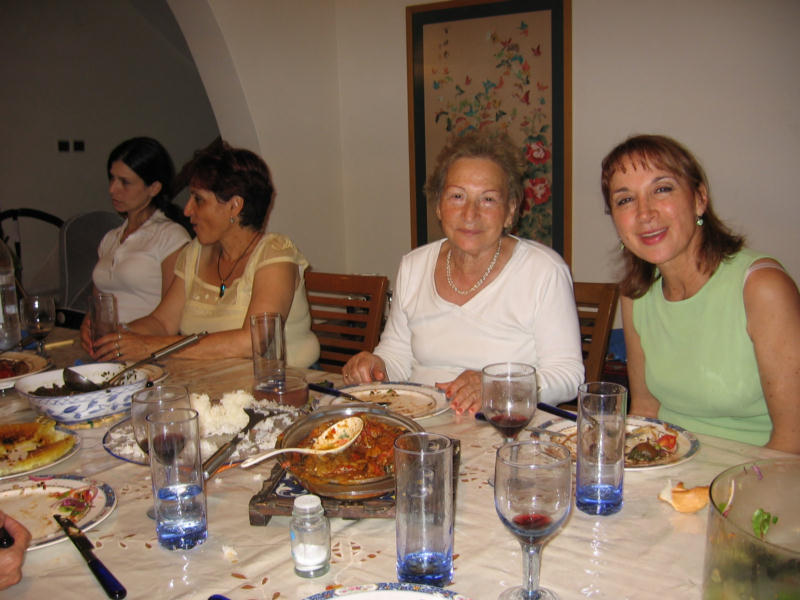 |
Mamanina made Rick's all-time favorite...Taa-Deeg and Fessenjoon (also known as shul-shul in the family). Yum-Yum |
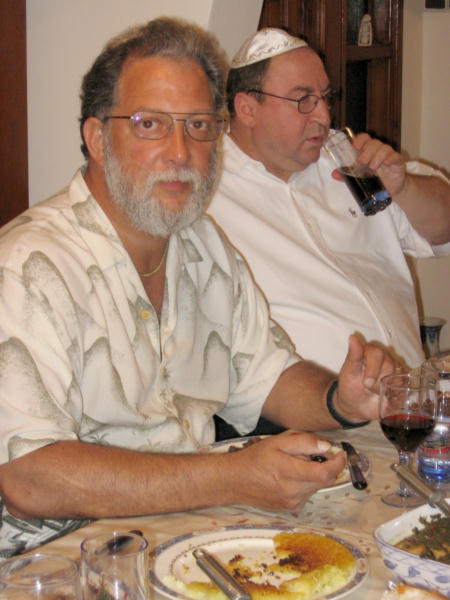 |
I don't remember what we discussed, but I still have a partial bowl of Fessenjoon to finish. Without a doubt, our BEST meal in Israel. |
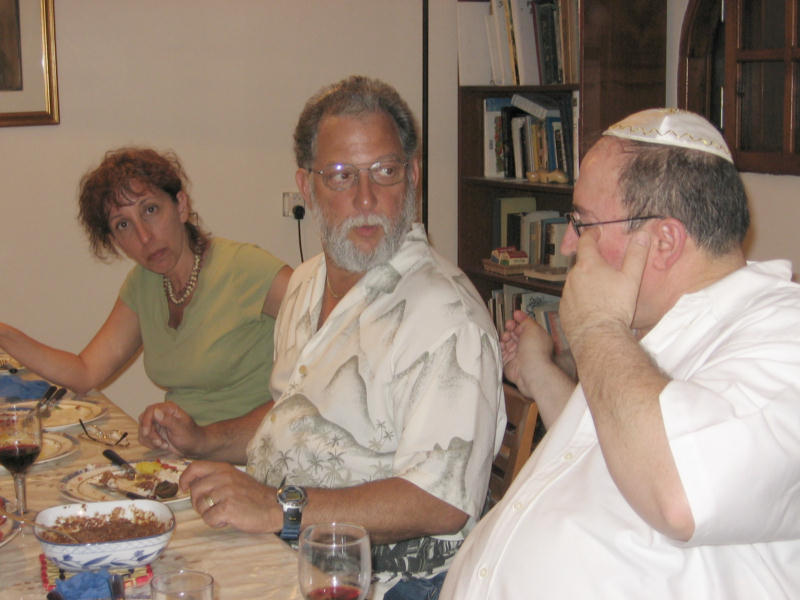 |
Rina's son Daniel and his wife Orly. |
 |
After Shabbat Dinner discussions turn to "the wisdom of having gone to the West Bank". |
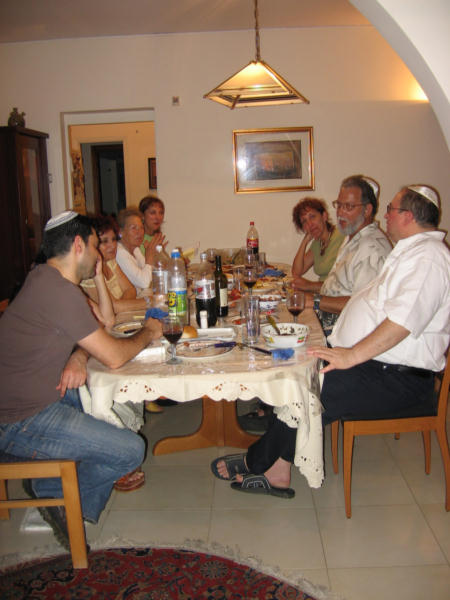 |
Top Of Page |
Tomer, headed to the reception after Temple. We have NO pictures from Temple. In fact, no cameras were even allowed inside of the Temple. |
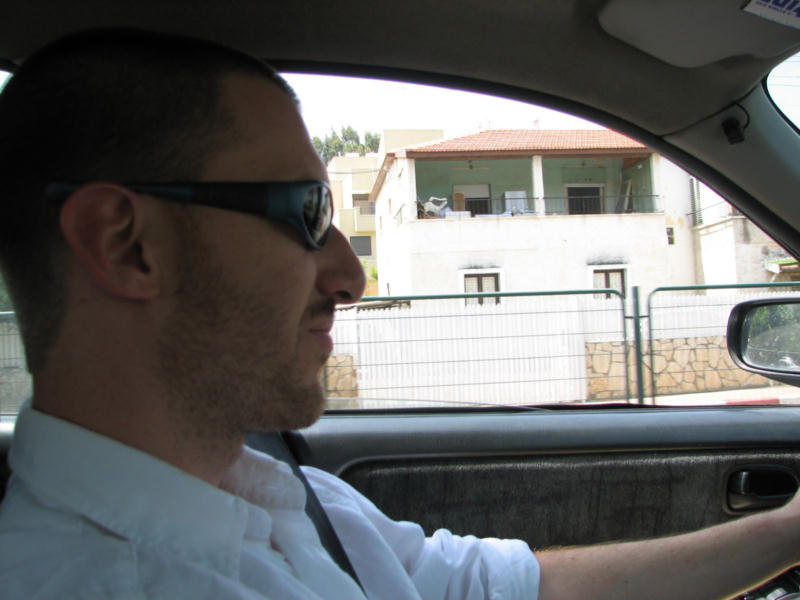 |
The REAL party animals arrive... |
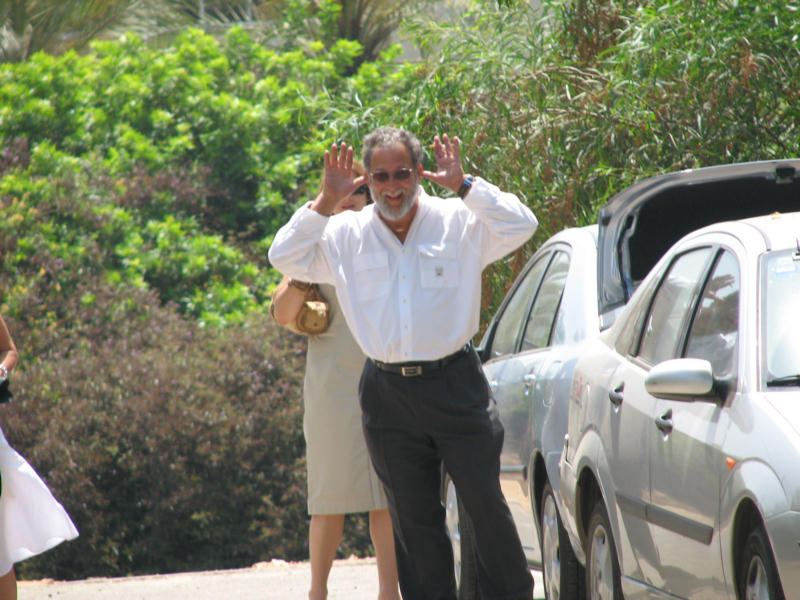 |
...The Mod Squad |
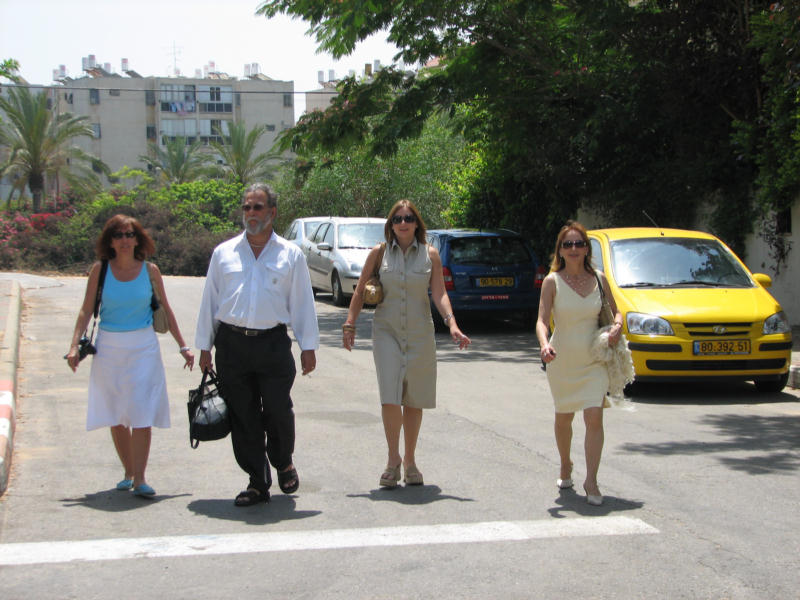 |
Awwwww. |
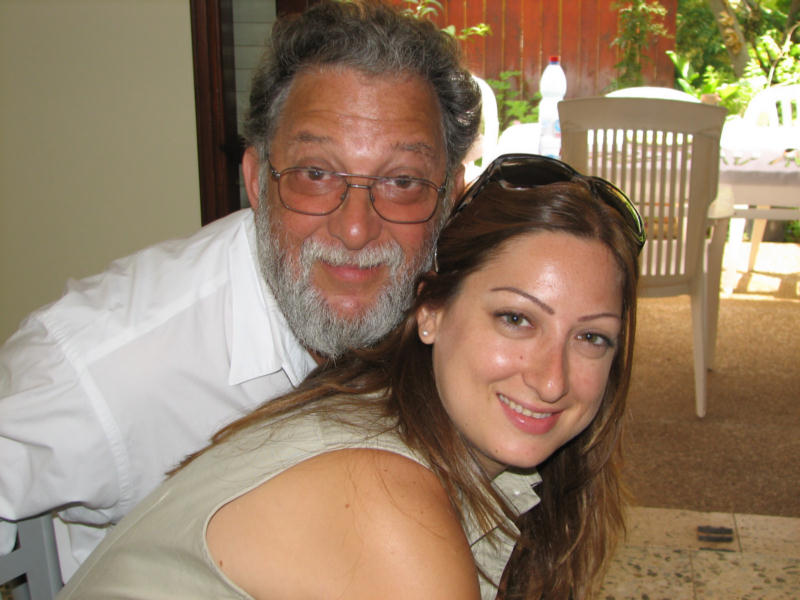 |
Tomer's uncle, Natalie and some rather well behaved kids. Hmmmm. |
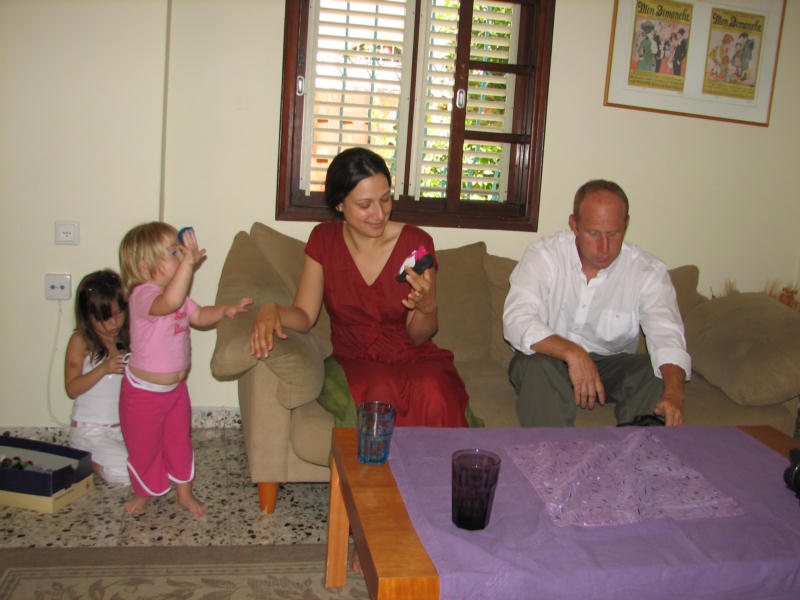 |
Tomer and Edna taking a break after lunch. |
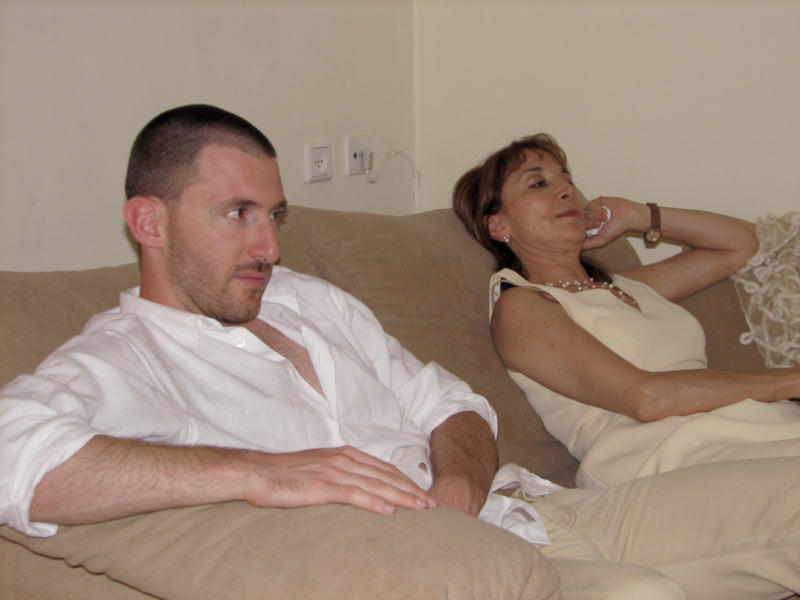 |
The bride to be... |
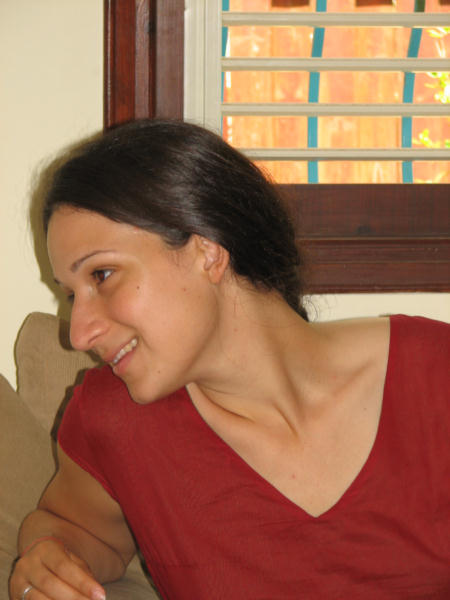 |
...The groom to be. |
 |
Husband & Wife...Soon. |
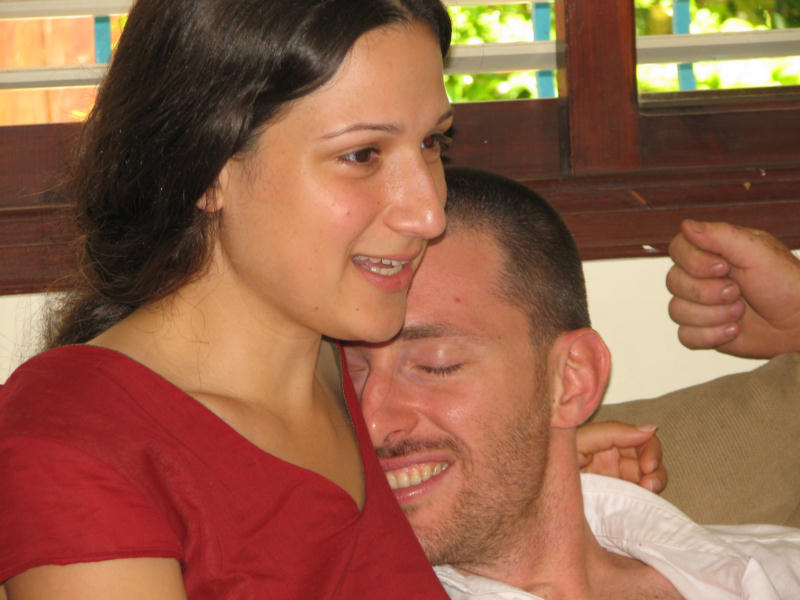 |
Top Of Page |
The bride and groom got a room at the local Hilton for after the wedding. But BEFORE the wedding it was used for prep. They had a hair stylist and a makeup artist come and do hair and faces. Also downstairs, appointments had been made for manicures and pedicures. All was well. Then the power went out. Joan was downstairs in the dark with some lady that didn't speak English; the hair stylist had tools which no longer worked and everybody was wondering what the hell happened. Power to the rooms and elevators came back pretty soon, but Joan remained in a dark subterranean salon with that lady who spoke no English. Then Joan hears Monica calling out "Noans? Noans? You in here somewhere?" Shortly thereafter, things got back to normal. |
Click Here To See The Wedding Pictures |
Top Of Page |
The day after the wedding, Joan and Rick cancel a 7:00-am pick-up time to tour the north. Instead we slept-in and then toured a bit of Tel Aviv. It was the hottest day of the year. So when we got back to the hotel all we wanted was something cold to drink and some air conditioning. But, again today, the power had gone out. We were told it would be just a while, so we headed to the beach for the afternoon. No problem. When we got back three hours later, the air conditioner still wasn't on. "Maybe another half hour", we're told. Nope. We were then told that when the power came back on, the air conditioner for our room died. We elected to change hotels to the Yamit Plaza (for the same price [Thank You, Edna!]). Good decision, too! |
The lobby of the Yamit. |
 |
Nice beach view. |
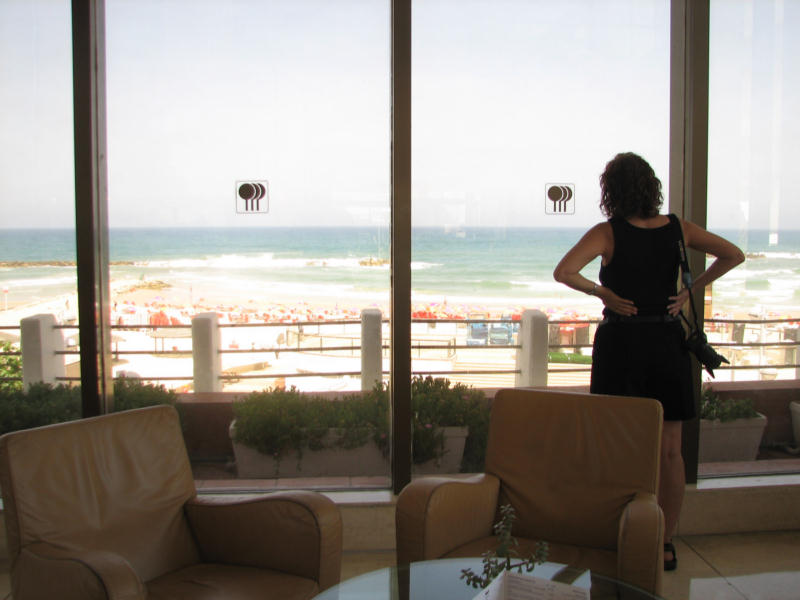 |
Same beach, just two blocks south. |
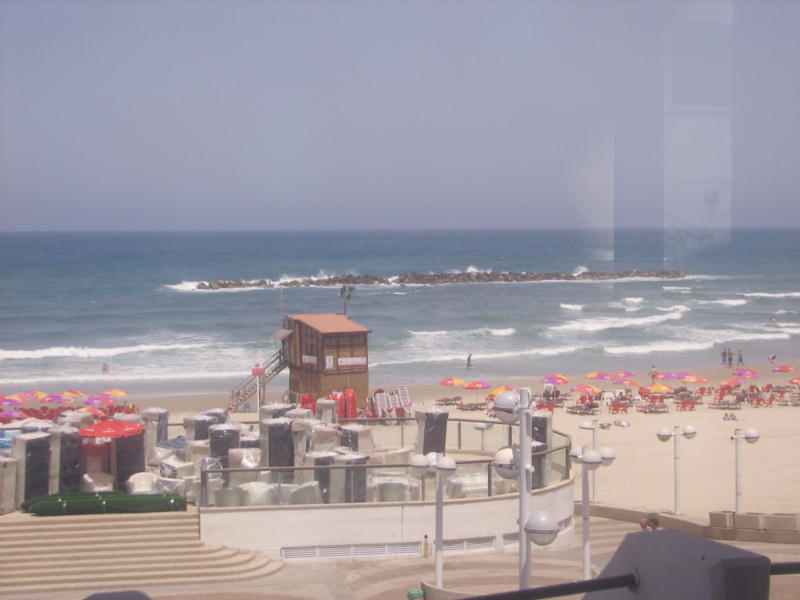 |
Looking north at the Dan Hotel and the Sheraton Hotel. Between the two, the overheated Astor Hotel |
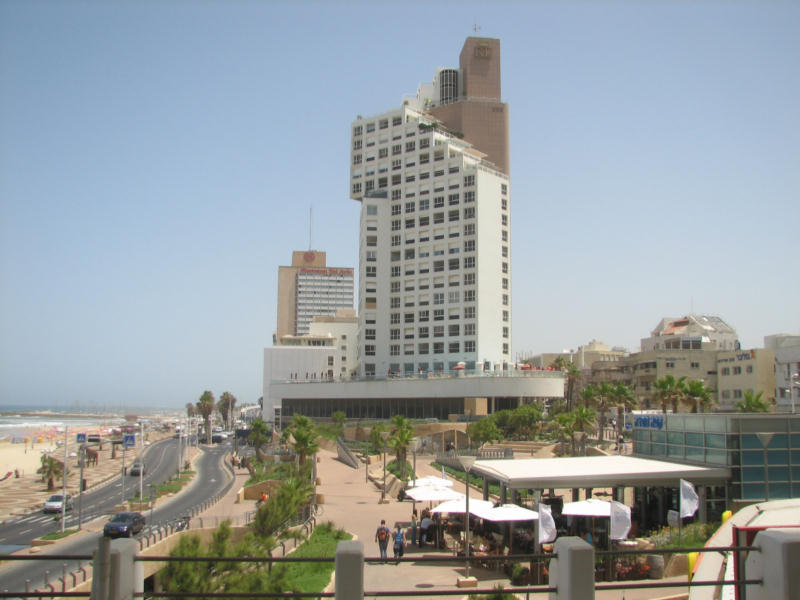 |
And, a lap pool. |
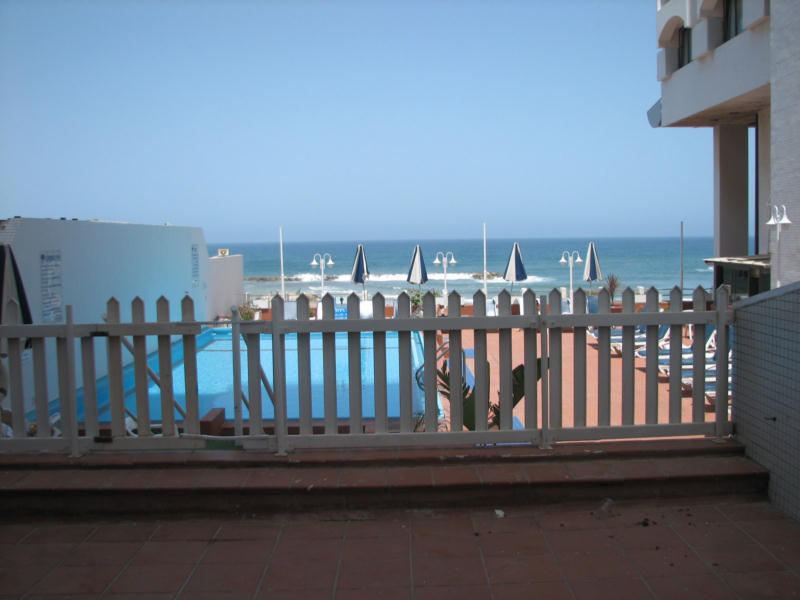 |
Top Of Page |
One of many late nights out with Monica. A rather small 10-pm dinner in Yaffo. |
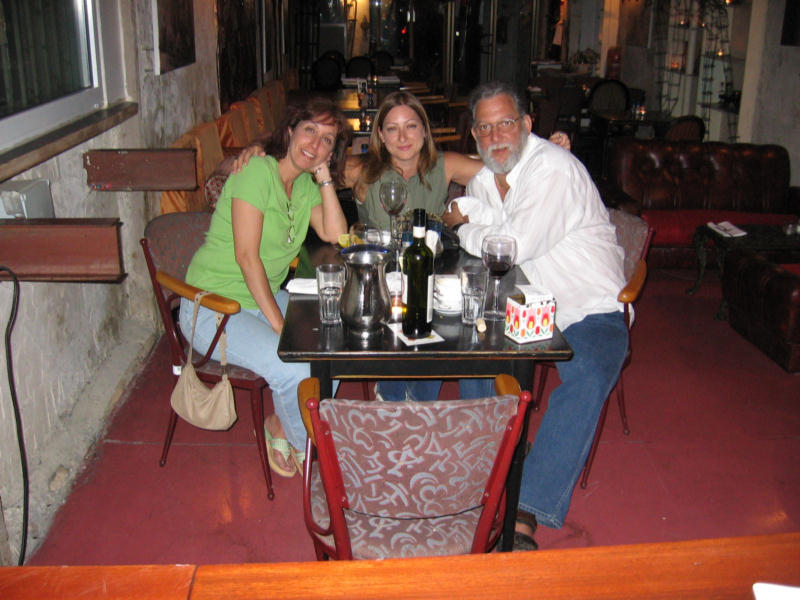 |
Another 10-pm dinner. This time in Neve Tzedek (between Tel Aviv and Yaffo... restored Old Tel Aviv). A very nice Italian restaurant and our second best dinner of the trip. |
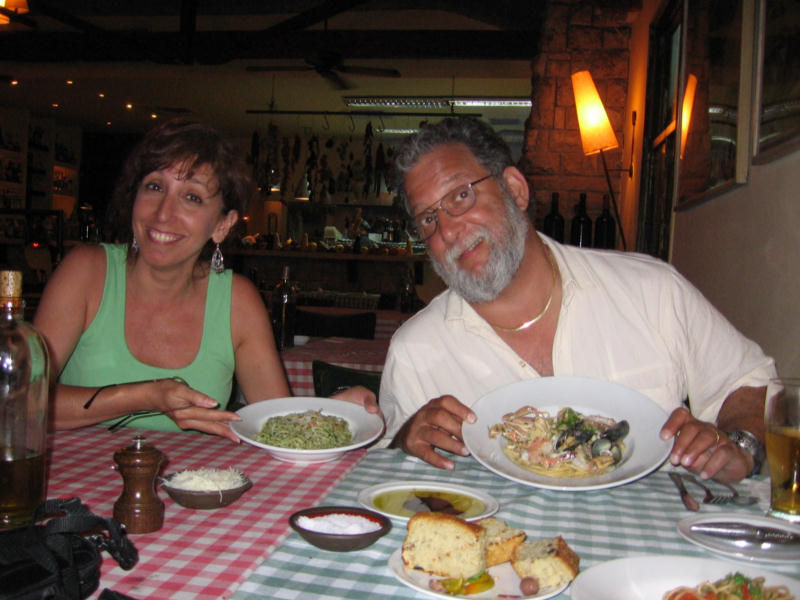 |
Top Of Page |
After conquering a small Phoenician harbor called Strato's Tower in the first century BCE, Augustus Caesar granted the land to his vassal-king, Herod, who returned the favor and re-named the area Casarea and its port Sebastos (Greek for Augustus). Harod transformed the city and port, making the Great Casarea Games of major region-wide interest and the port the largest in the eastern Mediterranean. After Harod died, his incompetent son Archelaus took charge and within a decade the Romans disposed of both Archelaus and the position of vassal-king. In the year 66, Jews and pagans clashed over property rights and riots left 20,000 Jews killed. This in turn led to the Jewish Rebellion which eventually resulted in the destruction of Jerusalem's Second Temple in 70-CE. The Romans celebrated the fall of Jerusalem by slaughtering thousands of Jews in Casarea's amphitheater. Over the course of two centuries, possession of the city changed hands four times. In 1101, King Baldwin I took the city and discovered a goblet, which was subsequently declared to be the Holy Grail and taken to Genoa. In 1265 Mameluke Sultan Beybars conquered Casarea and his successor ordered it destroyed. So it remained for six centuries. |
The Roman-built "High" Aqueduct. (I guess EVERYBODY needs a place to park) |
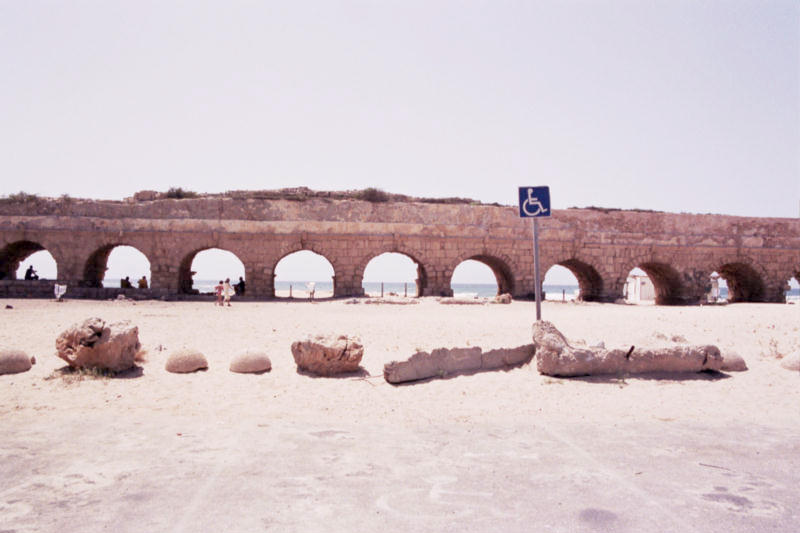 |
[Three aqueducts that provided water to the city have been uncovered. This one channeled water 11-miles from the Shuni Springs of Mount Carmel and traversed a 1200-foot sandstone ridge.] |
The end-of-the-line (er, aqueduct). |
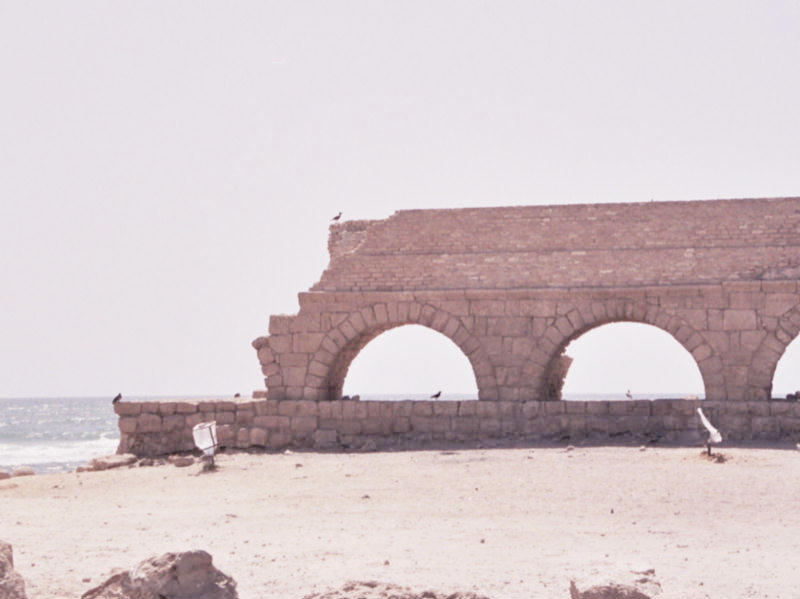 |
View of one of the aqueduct's water channels. |
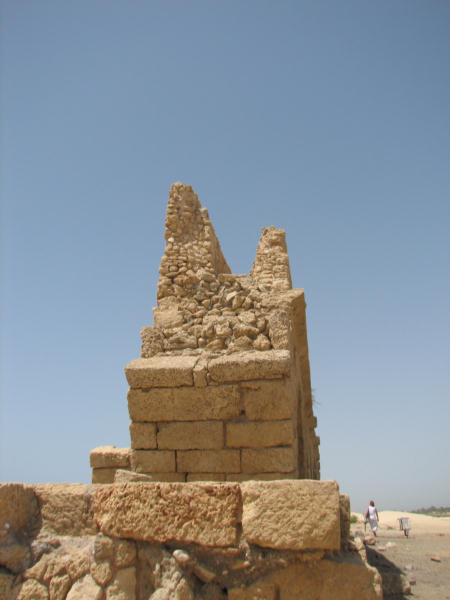 |
Out of the sun: some shade and a frosty one. |
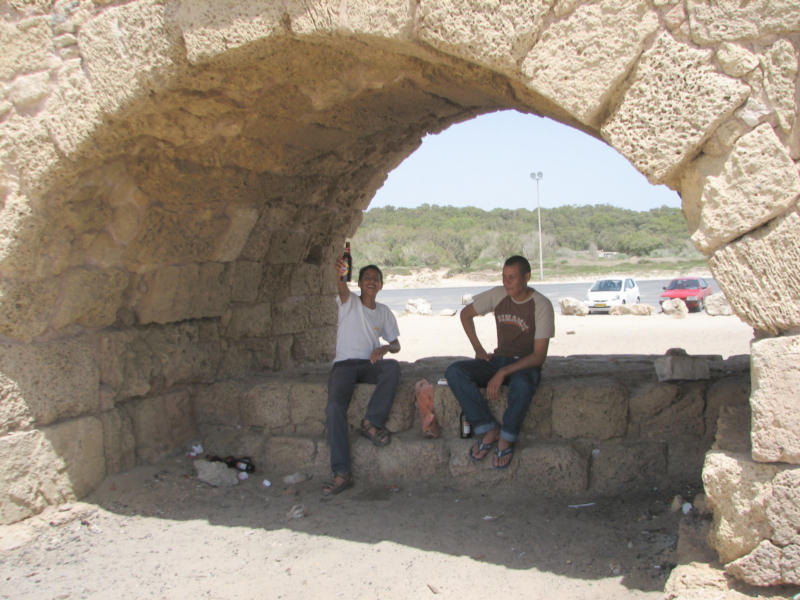 |
Shade, minus a frosty one. |
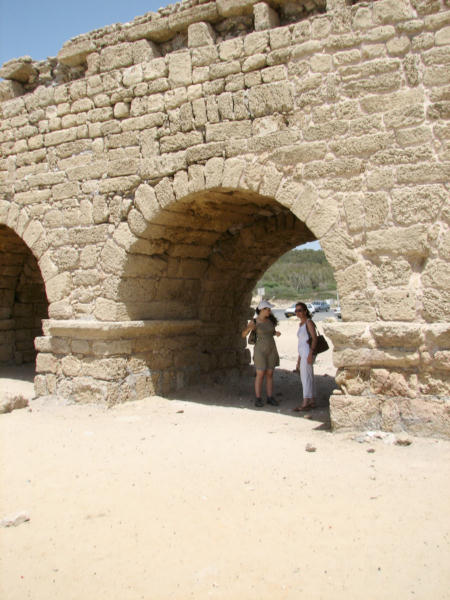 |
Detail of aqueduct's top layer. |
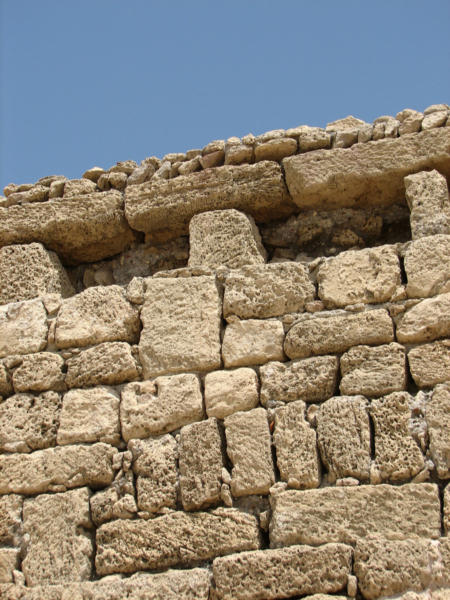 |
A picture of Rick "walkin' the duct". |
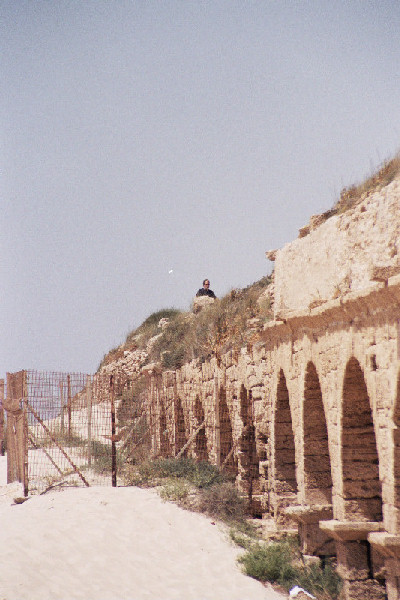 |
Standing on top of the aqueduct one can barely tell what it once was. |
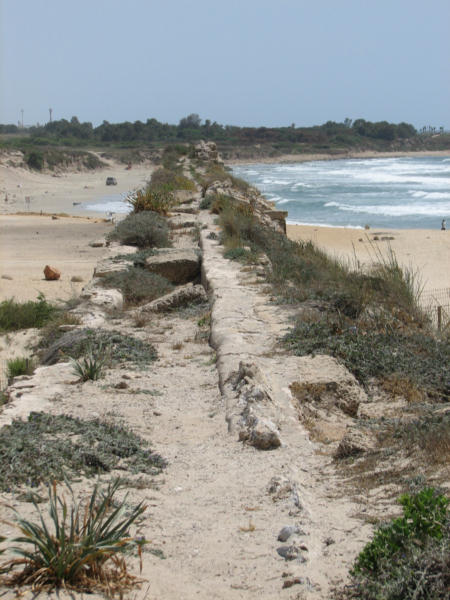 |
Edna doing a bit of Tai Chi. |
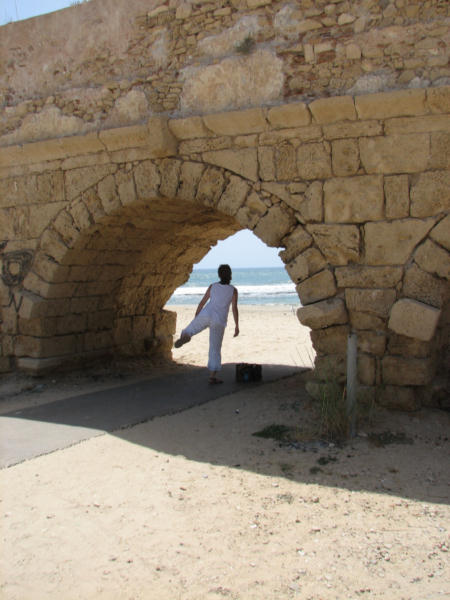 |
The Walled City (East Gate) |
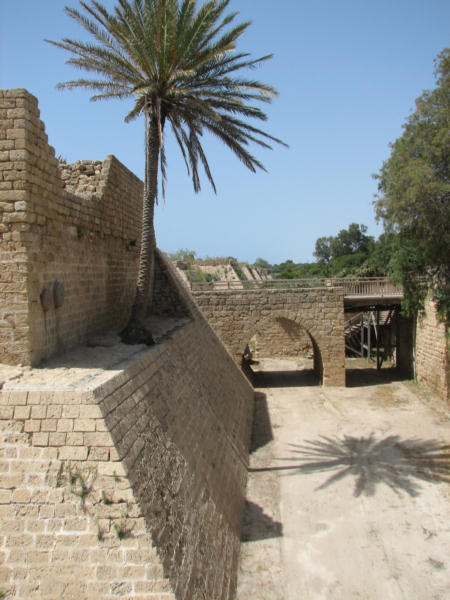 |
[The city has three walls: the original (Harod/Roman-built), a wall doubling the size of the original city (Byzantine era) and a wall halving the size of the original city (built by the Crusaders). By far, the most impressive (and visible) is the Crusader's Wall, built by Louis IX. The moat never held any water but its height and slanted bottom (glacis) provided defenders a double advantage. ] |
The East Gate from the inside, replete with surplus overstocked Roman columns. |
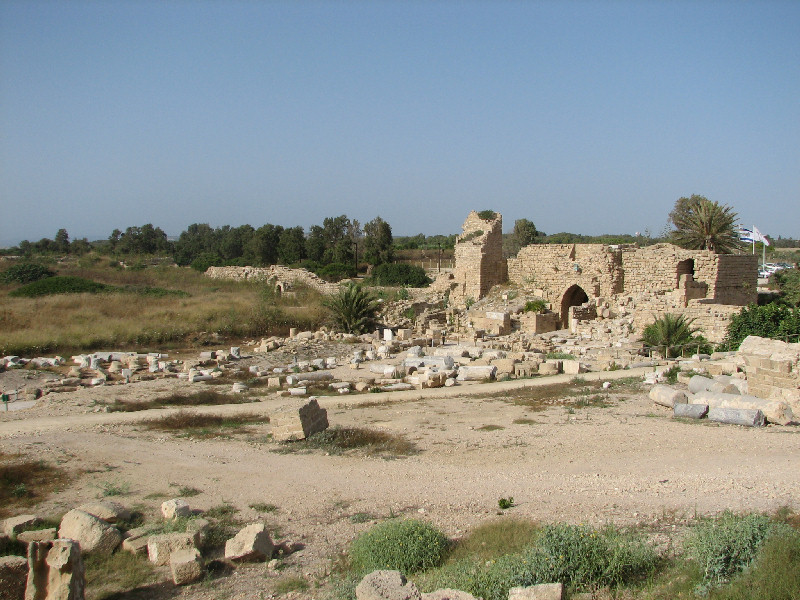 |
The current extreme of the Herodian harbor. (we ate lunch there.) |
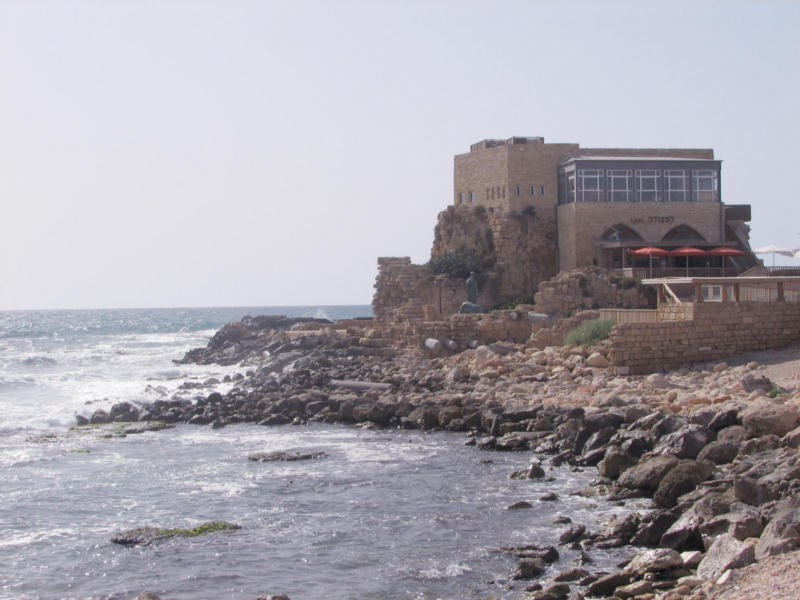 |
Herod's 15,000-sq-meter Amphitheater. One of the largest hippodromes in the Roman Empire. Used for chariot races and sporting events. Spectator and dignitary seats on the left for 15,000 people. |
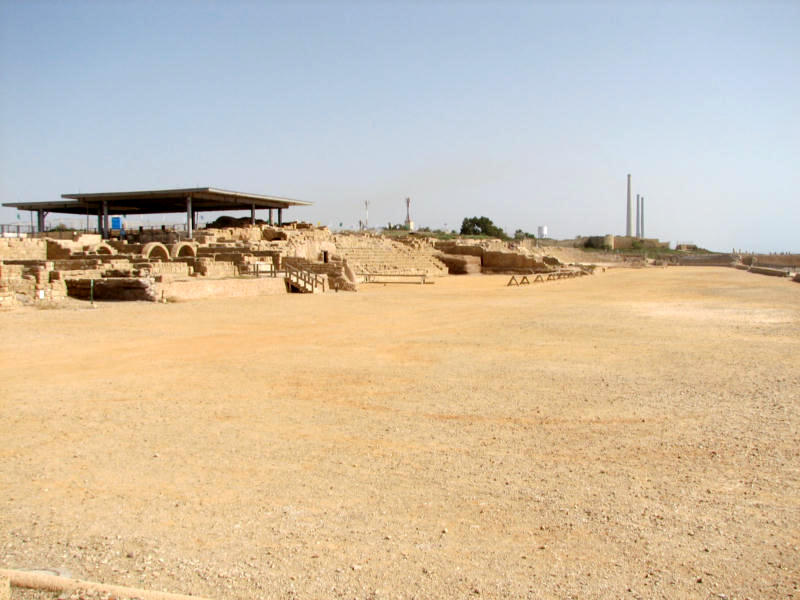 |
Another view. |
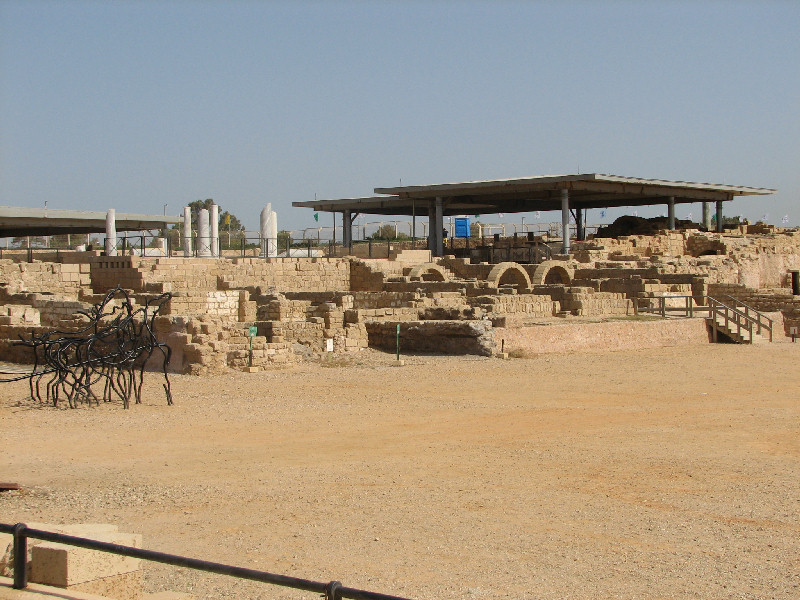 |
The seven starting gates. Exit gates are on the other side of the ramp. |
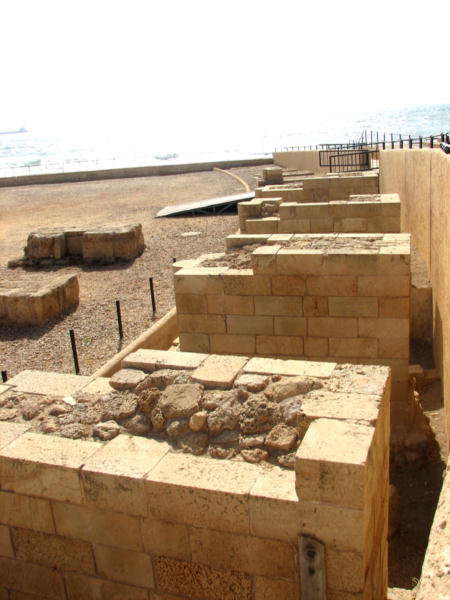 |
A restored mosaic floor in the tax collectors palace. |
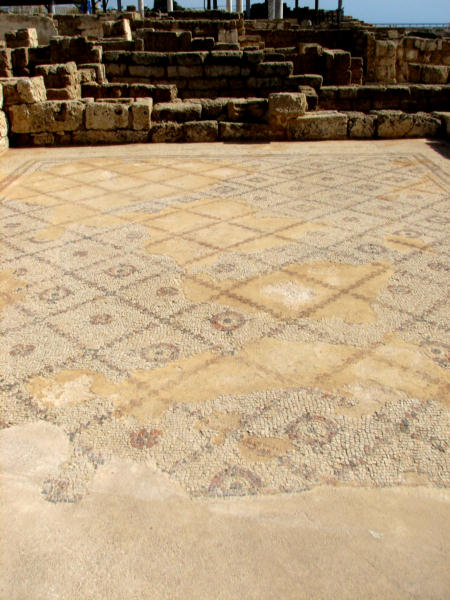 |
The warehouse district. |
 |
Joan trudging through the warehouse district. |
 |
Columns at the Byzantine Bathouse entrance. |
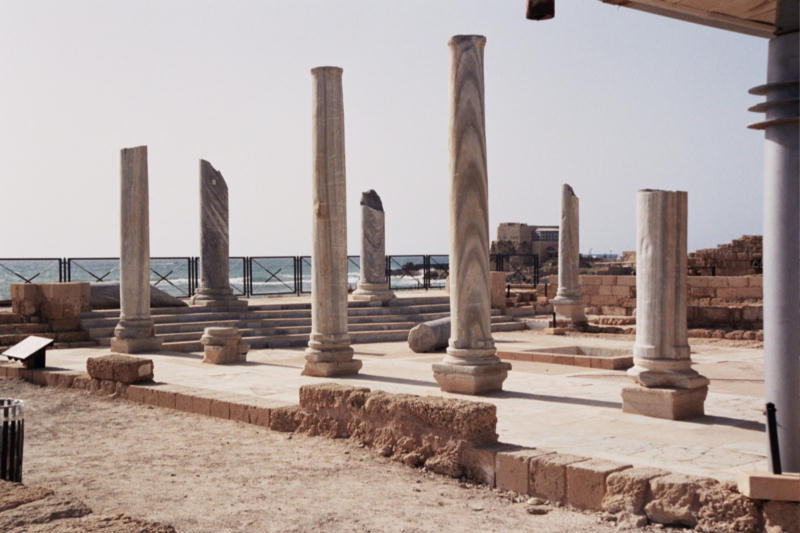 |
[Fed by the city's main aqueduct, the bathhouses offered a freshwater change from the salty sea. The baths included a cold-water pool (frigidarium) and a hot-water pool (calidarium), heated by outdoor furnaces. The marble columns are Roman, but re-used by the bathhouse's medieval contractors.] |
Roman Theater seats 4000 people |
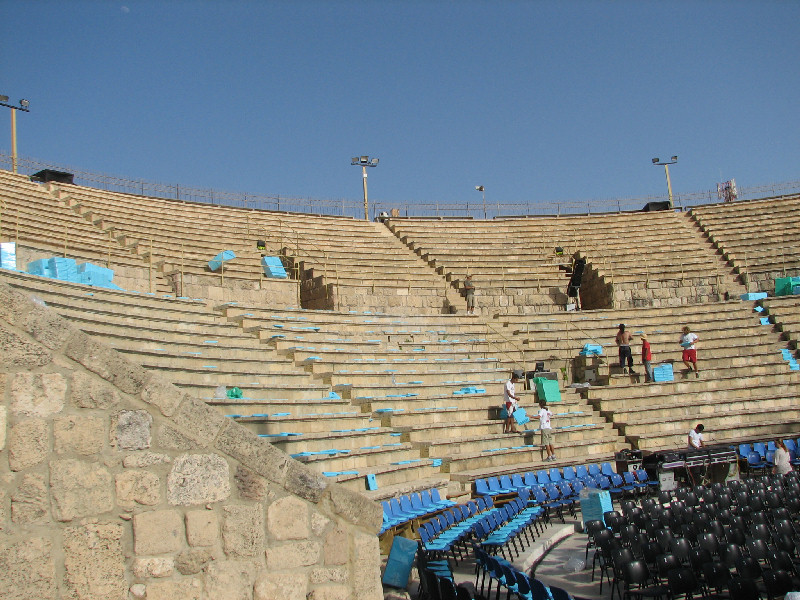 |
[Built by Herod and reconstructed several times in the first century. Now completely restored (1961), the theater has hosted Eric Clapton, the Bolshoi Ballet, Joan Baez and Julio Iglesias. The Israeli Opera performs here regularly throughout the summer. (call 011-972-3-636-13-58 for concert schedule and tickets.)] |
Maybe, 4000 and one. |
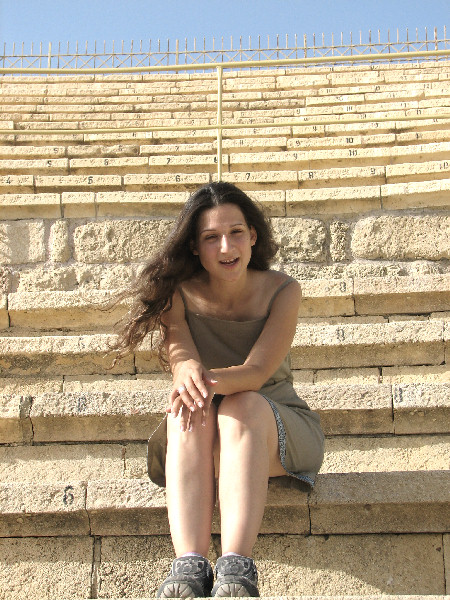 |
Sound check for tonight's concert. |
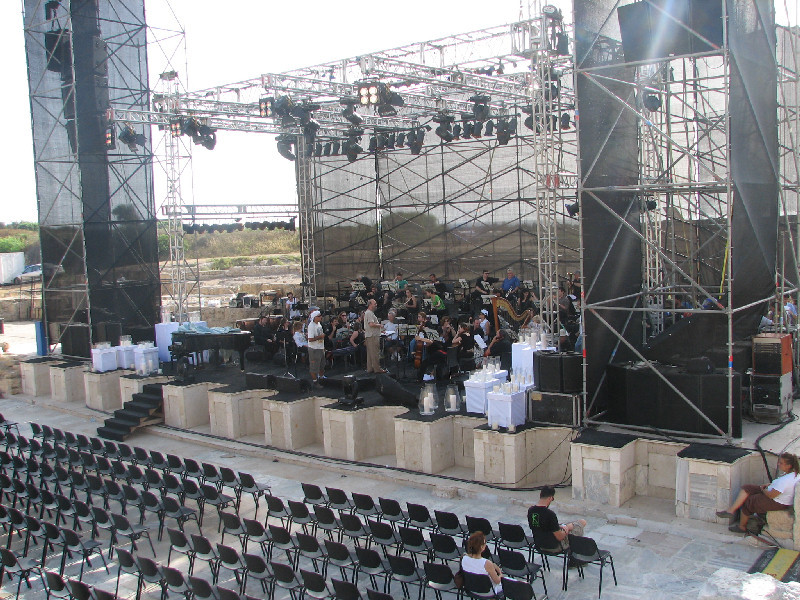 |
Misc restored archways. |
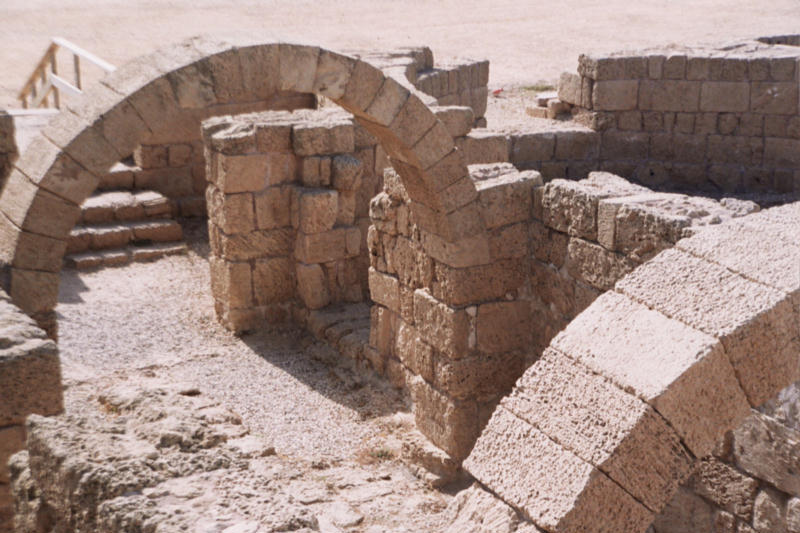 |
Archway leading out of the Roman Walled City |
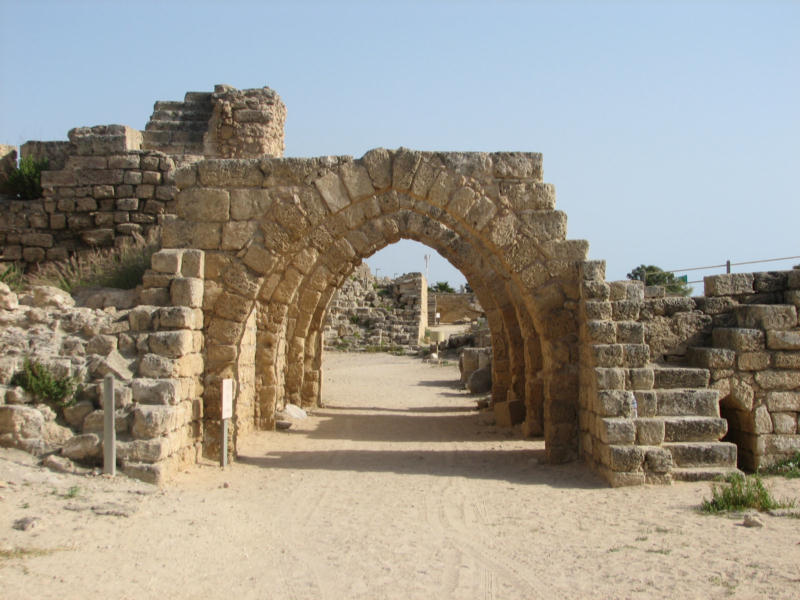 |
Group Shot! |
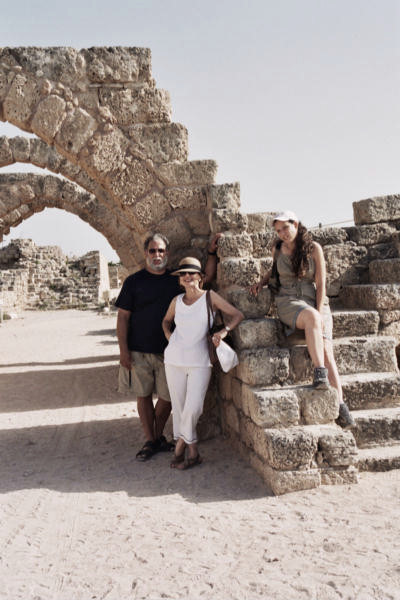 |
Top Of Page |
Well, we were asked where we would like to meet-up with everybody for our last night and we chose this place in the Tel Aviv port area. The first week, Edna had taken us to another location of this chain. It was wonderful. Earlier this week, one night while walking, we found this location on our own. Again, it was wonderful. The third time was a charm. |
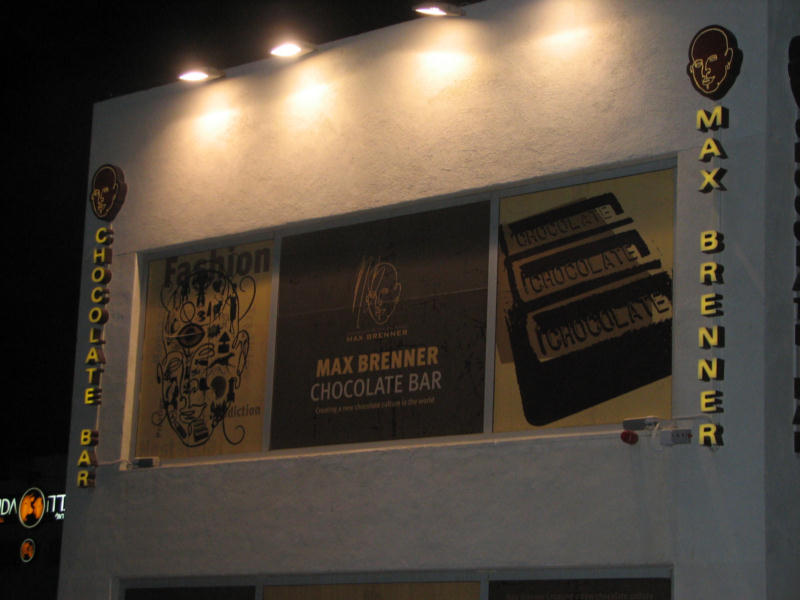 |
They have the most imaginative chocolate concoctions imaginable. Joan took her's on waffles with a side of ice cream. |
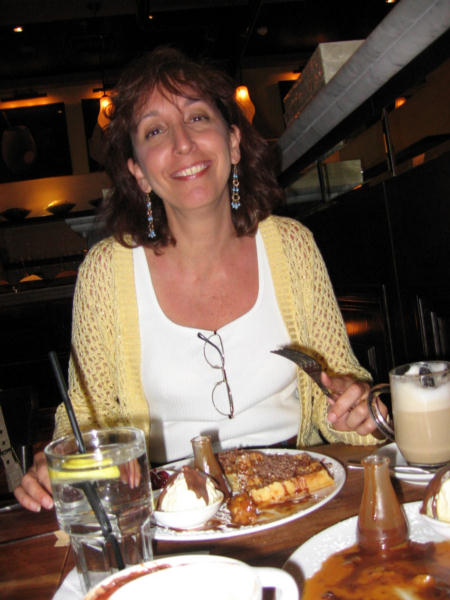 |
Rick had his on bananas and a bunch of other stuff. |
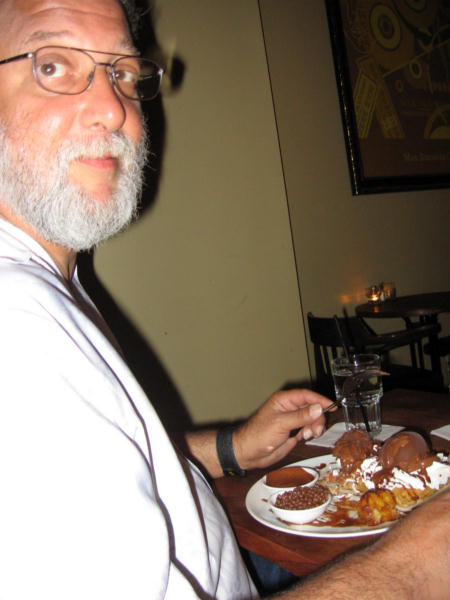 |
OKAY! It LOOKS disgusting. But it was good. |
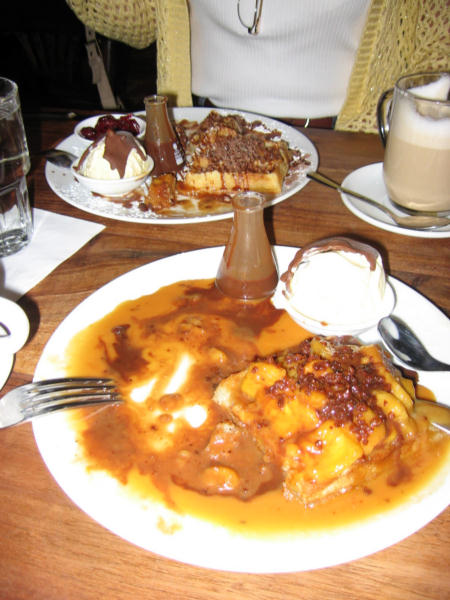 |
After dessert we all had to take a walk. |
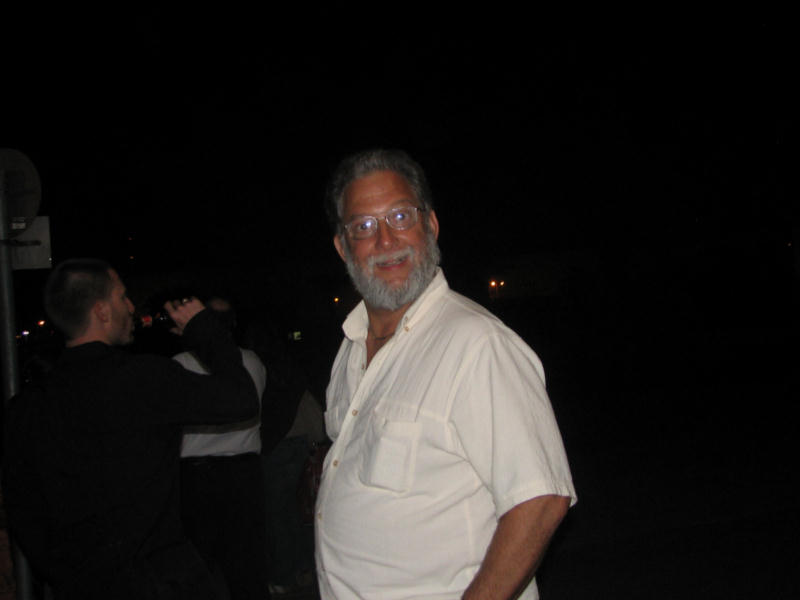 |
After having seen 137 movies in 6 days, Ronny was laughing at everything. |
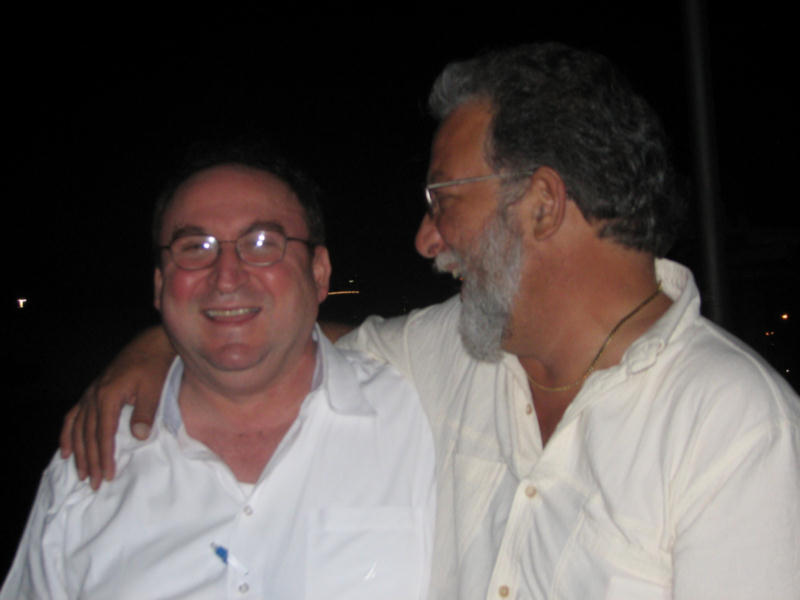 |
It was contagious. |
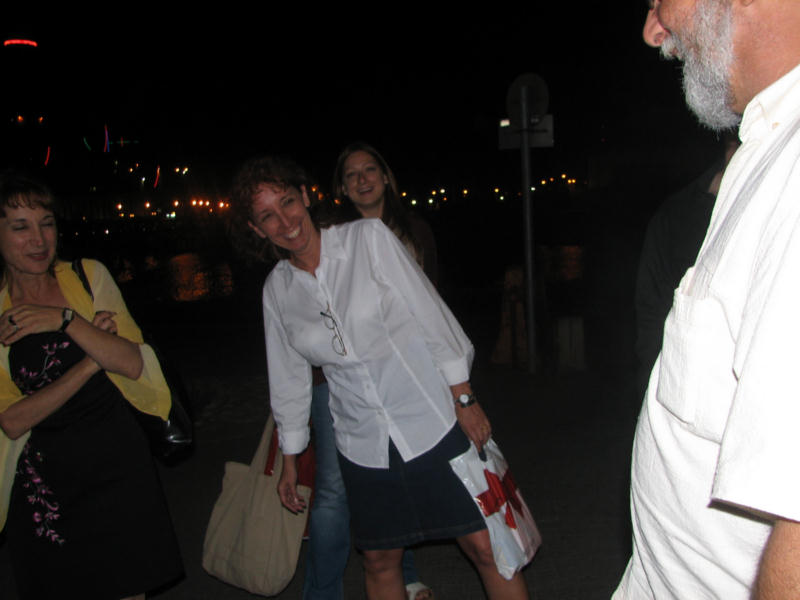 |
Rick took a shot... |
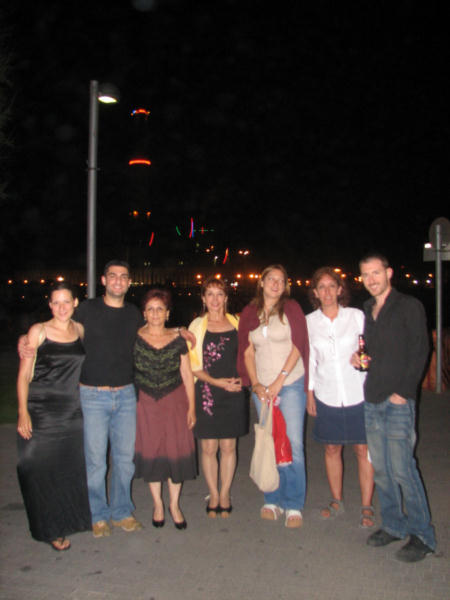 |
..Natalie took one. |
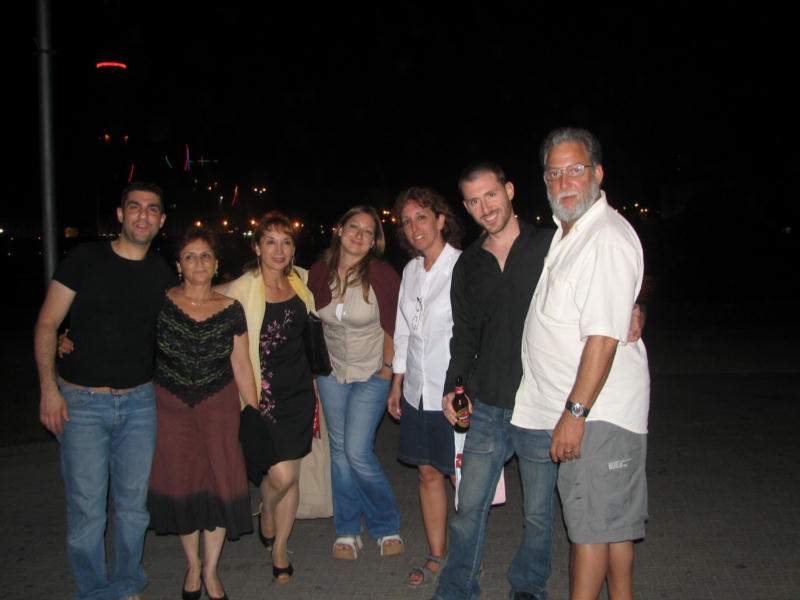 |
I think we left Ronny in the dark. |
 |
The two on the left would rather camera angles be raised on all photos. |
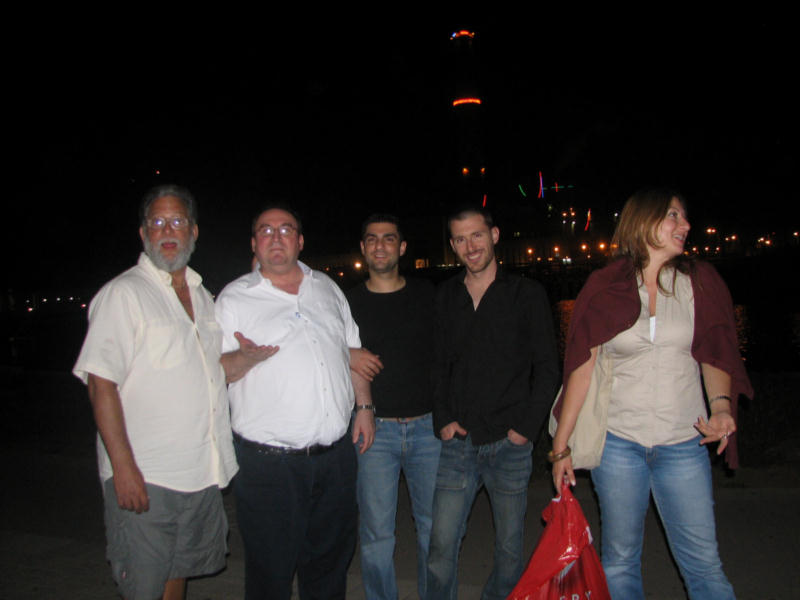 |
Monica found herself a ride. Riiiight! |
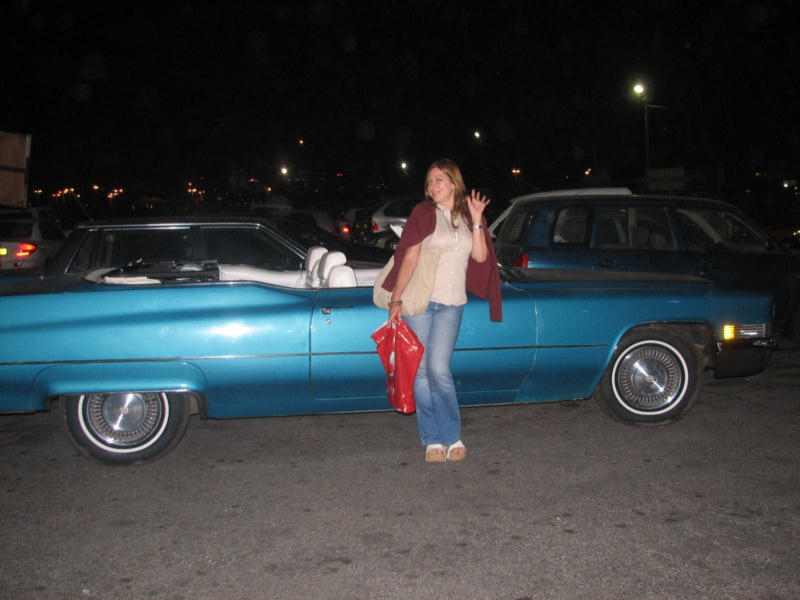 |
And Natalie says "Good Night" and "Good Bye". |
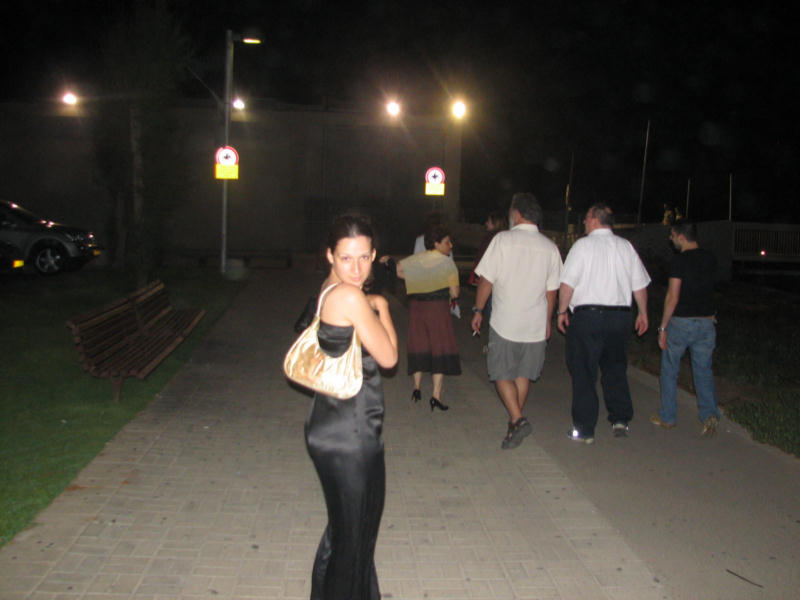 |
![]()